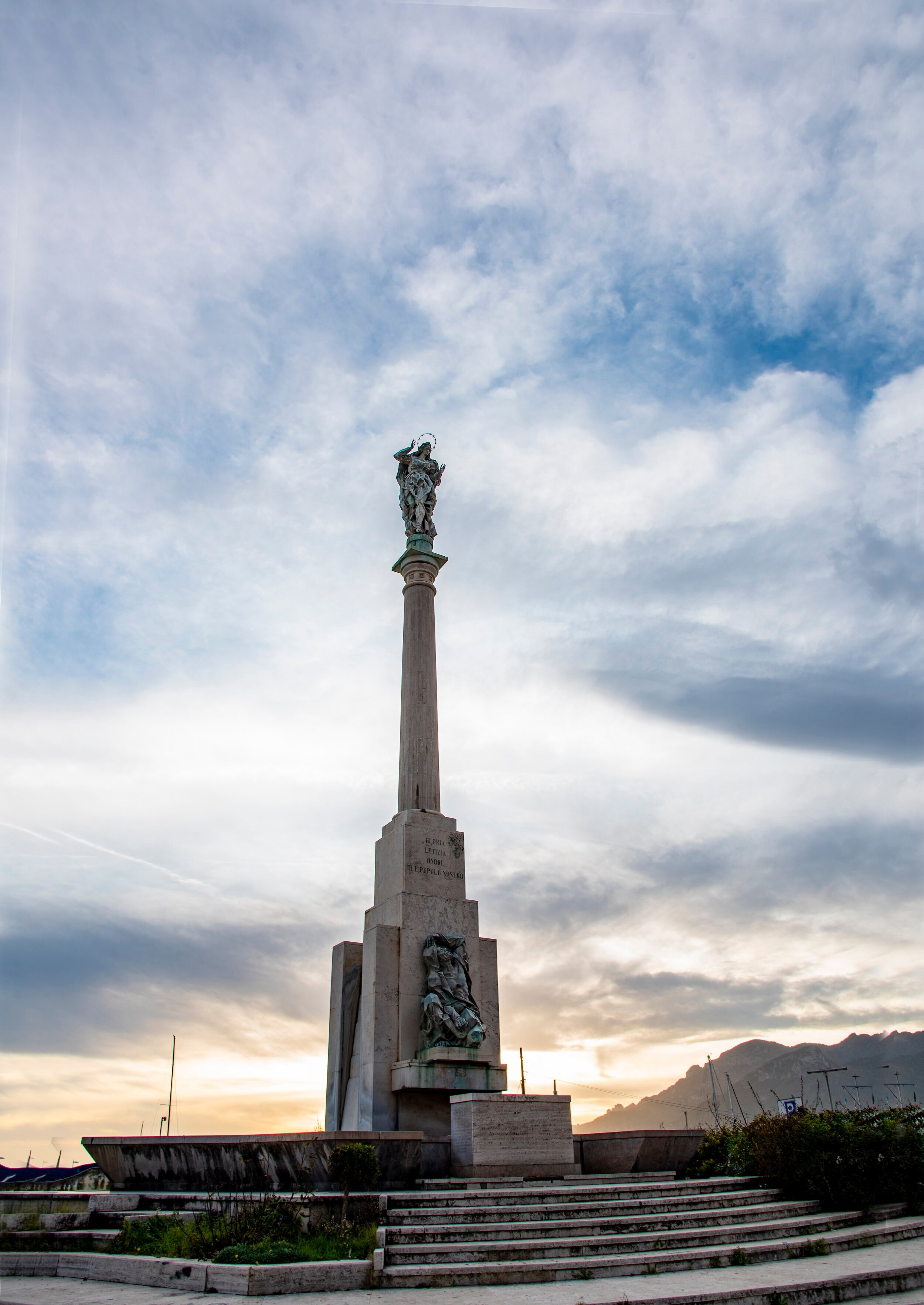
Monument to the sailors in the Piazza della Concordia, Salerno, designed by Antonio Berti and opened in 1963. Obelisk is 65.5 feet high surmounted by a statue of the Virgin Mary in golden bronze.

Statue of Virgin Mary, golden bronze, atop the Berti Sailor Monument obelisk.

After parking our car at the Piazza della Concordia, we walked along the Lungomare (promenade) Guglielmo Marconi in search of food and a hotel.
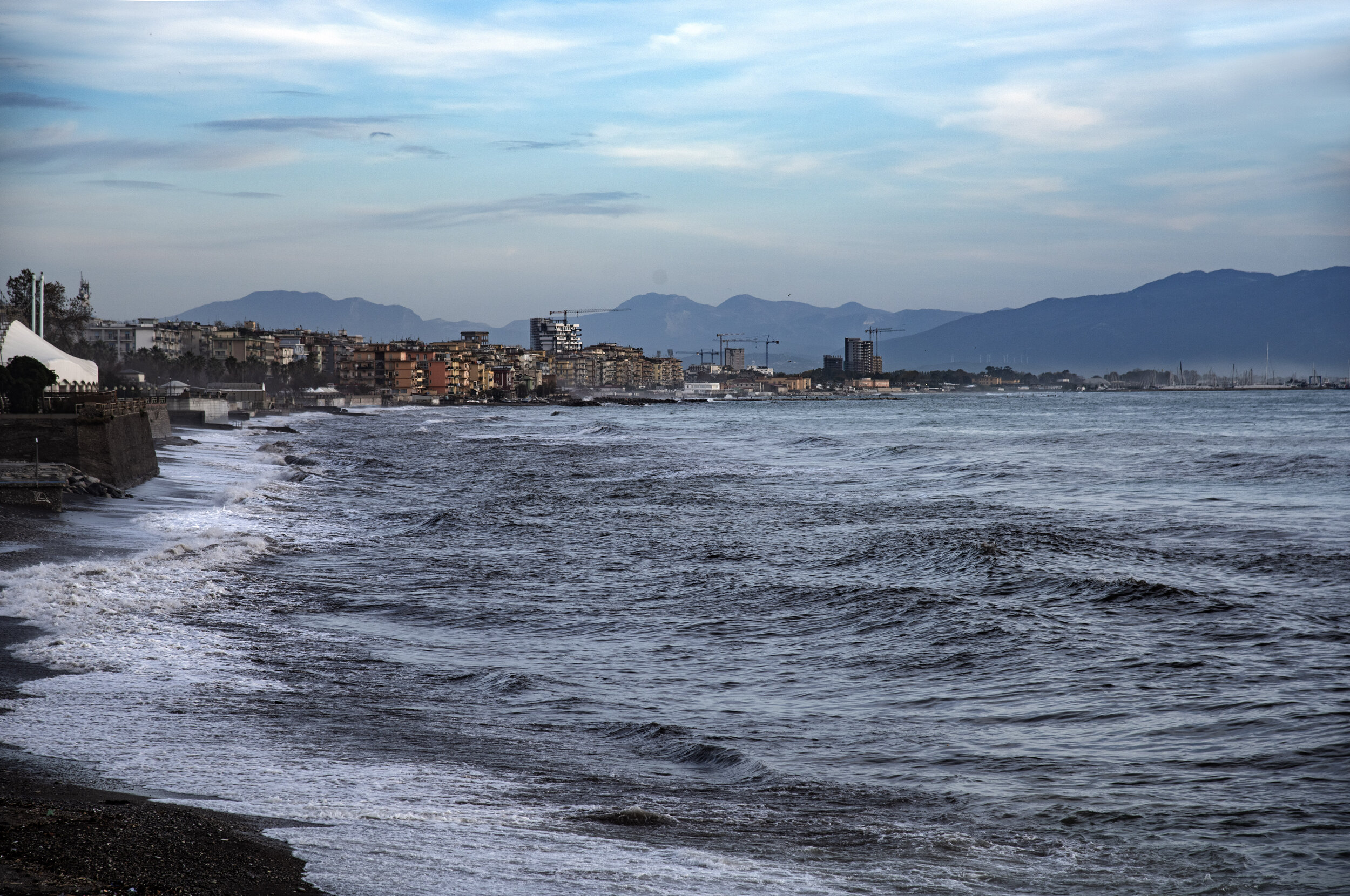
Late afternoon Salerno looking toward the southeast and the Tyrrhenian Sea.

Fishing the Tyrrhenian Sea in the late afternoon.
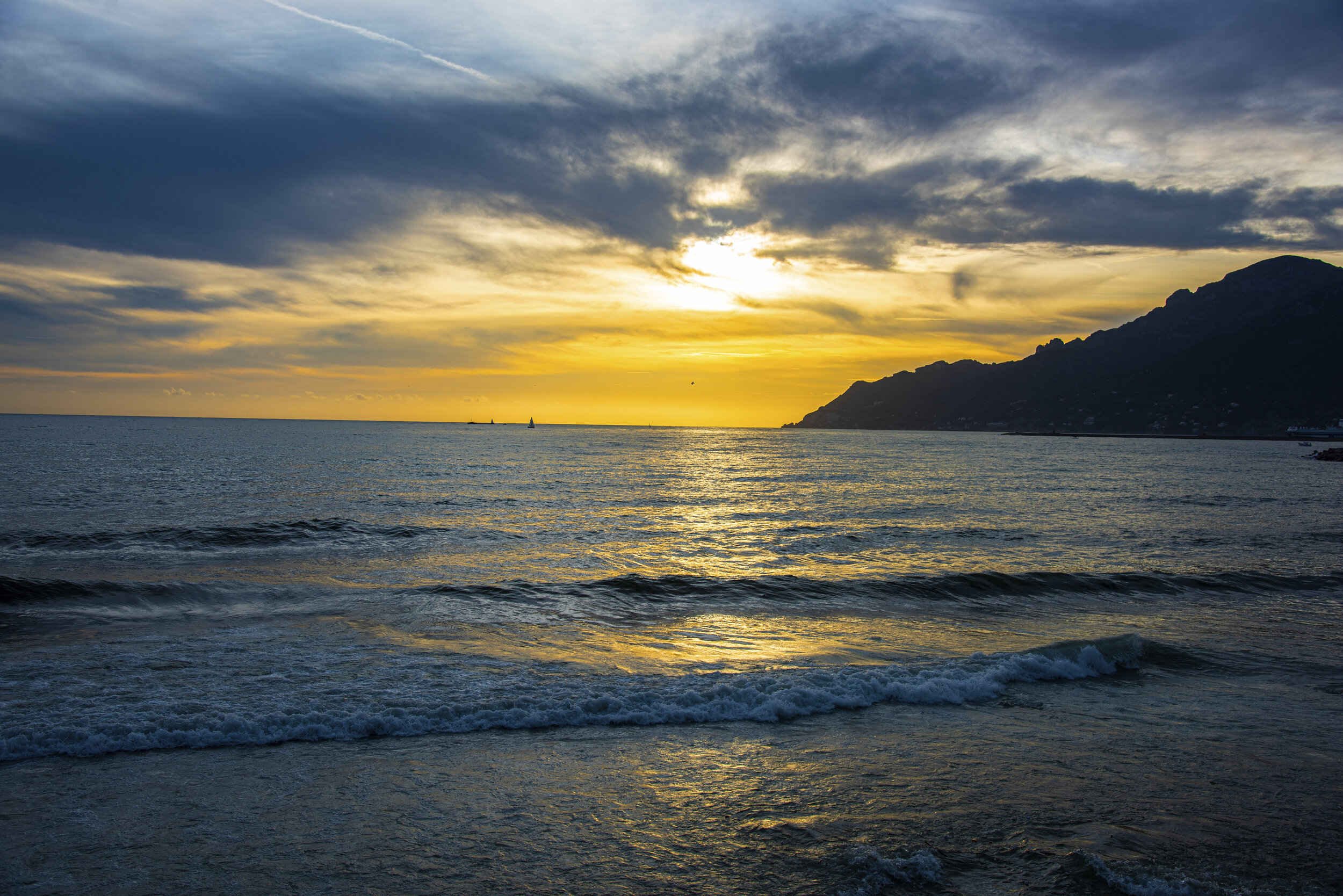
Sunset over the Tyrrhenian Sea looking northwest toward the Amalfi Coastline.
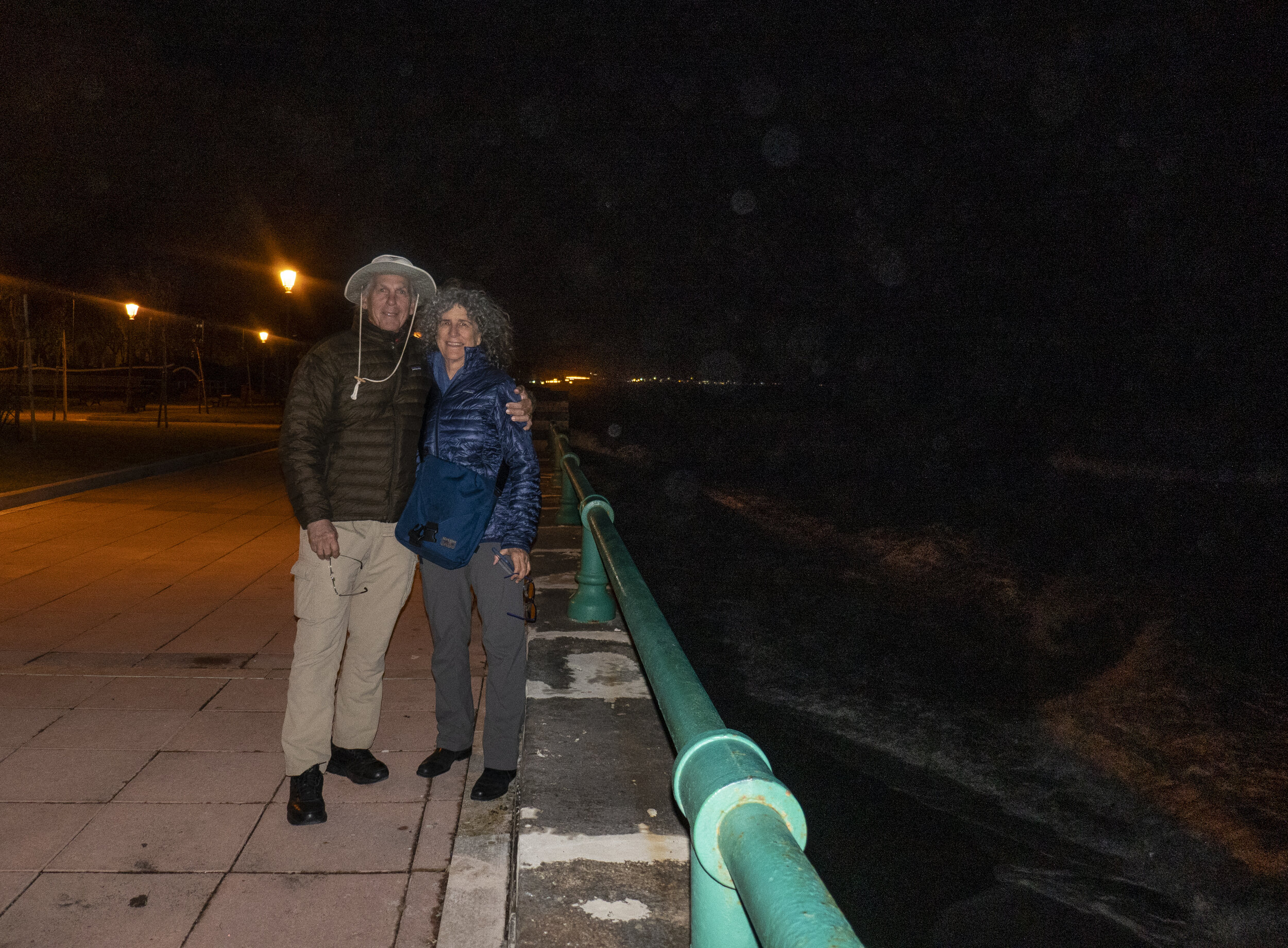
After finding a most wonderful hotel across the street from the Tyrrhenian Sea we took an evening stroll along the promenade by the sea.

Saint Matthew Cathedral (San Matteo Duomo) was begun by the Norman, Robert Guiscard in 1076 and consecrated by Pope Gregory VII in 1084. Its shape and plan as chosen by Alfano I, Archbishop of Salerno
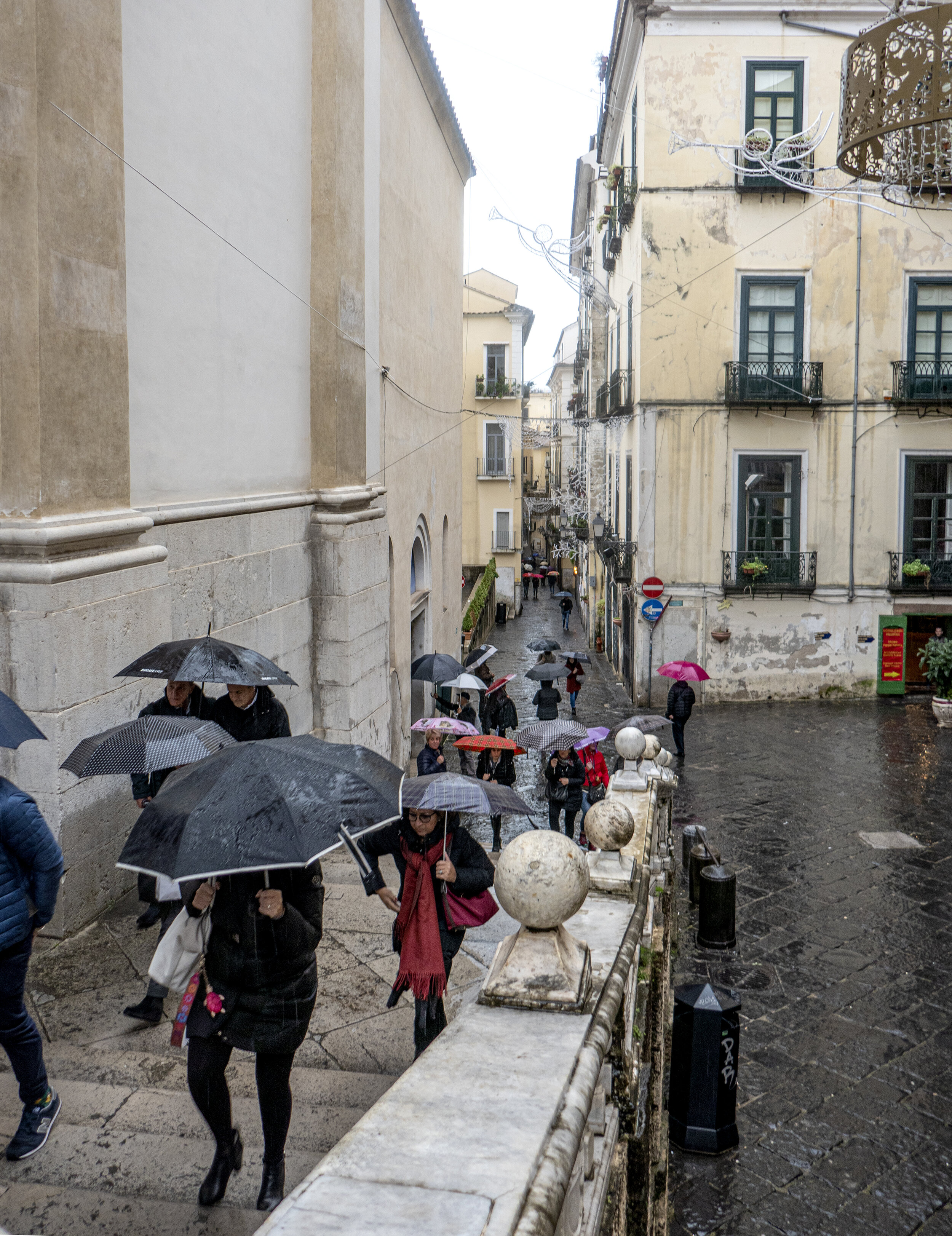
Sunday morning mass-goers climb steps on both sides of the mid-17th century baroque-style facade in order to enter the Cathedral atrium.
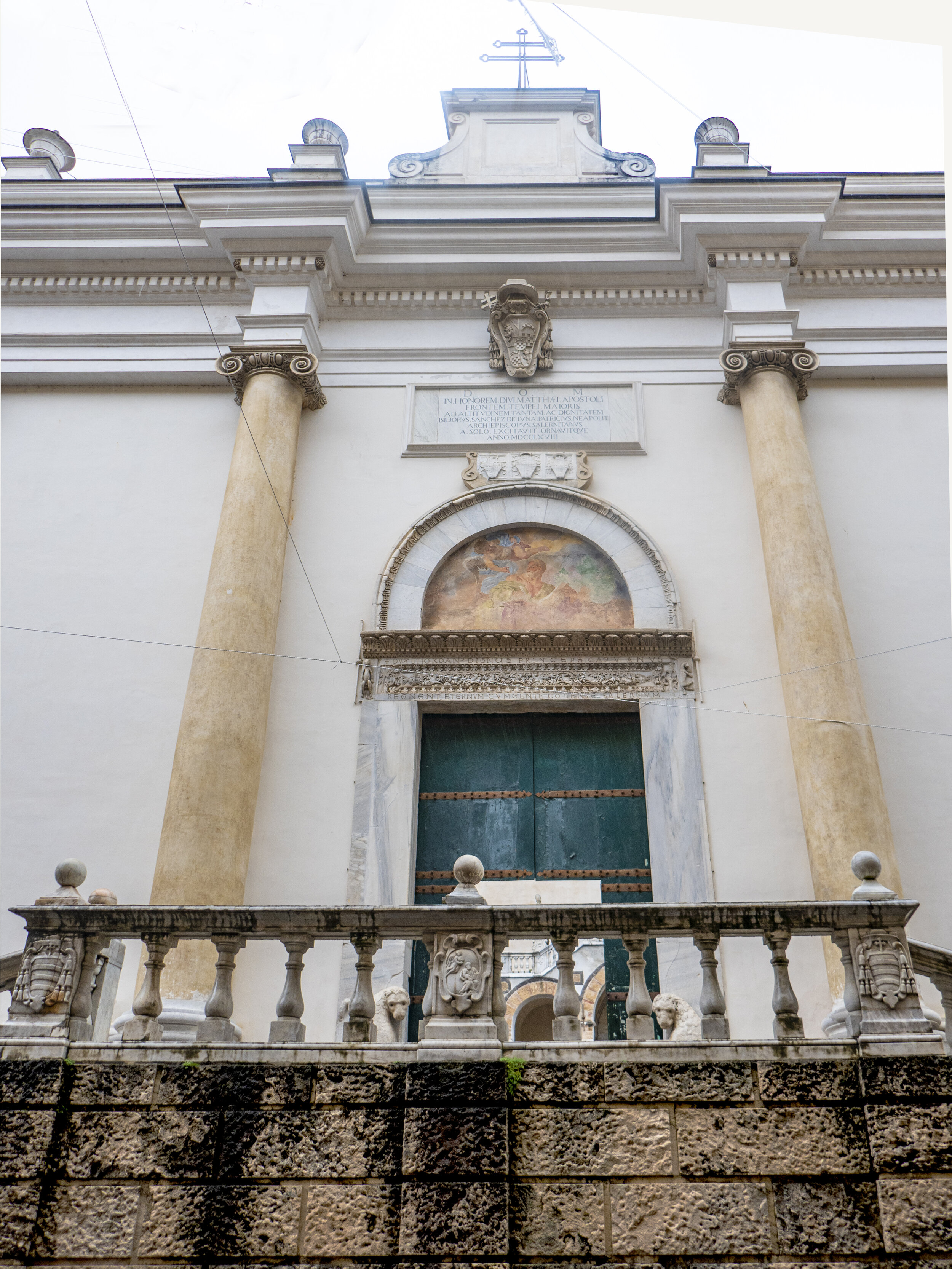
The double steps of the Cathedral meet on a landing where parishioners, pilgrims, and tourists enter through the "Porto Dei Leoni" into the atrium of the Cathedral.

On the architrave (main beam of the door frame) of the entrance an inscription, in Roman capital characters, reminds those who enter about the alliance between the Principalities of Salerno and Capua.
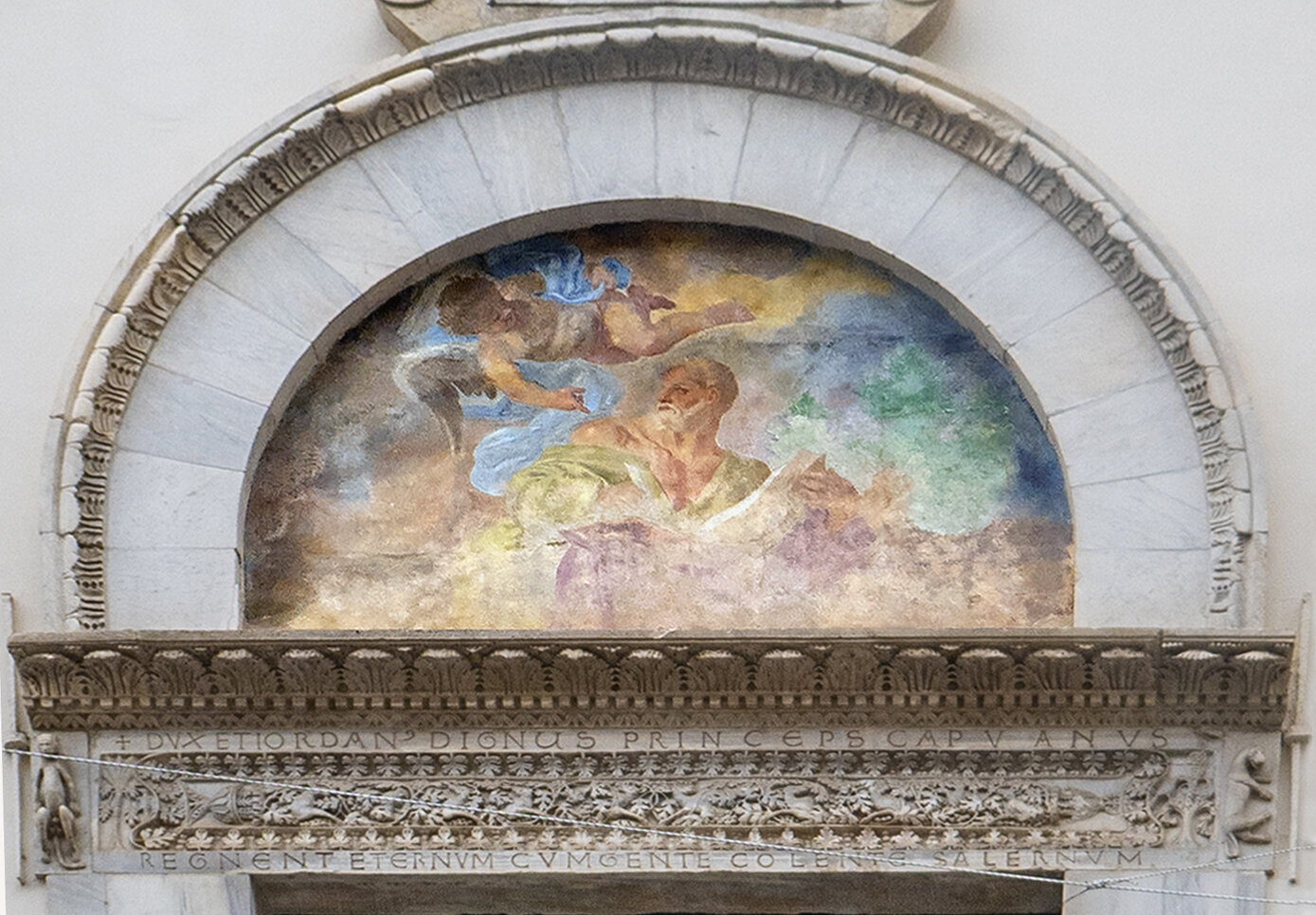
The lunette above the architrave and "Porto Dei Leoni" contains a 17th century fresco depicting St. Matthew writing the gospel.

The ancient Romanesque portal called the "Porto dei Leoni " because of the two lion statues on either side of the jambs, one, the male, symbolizes strength and the other, a lioness with a cub, charity
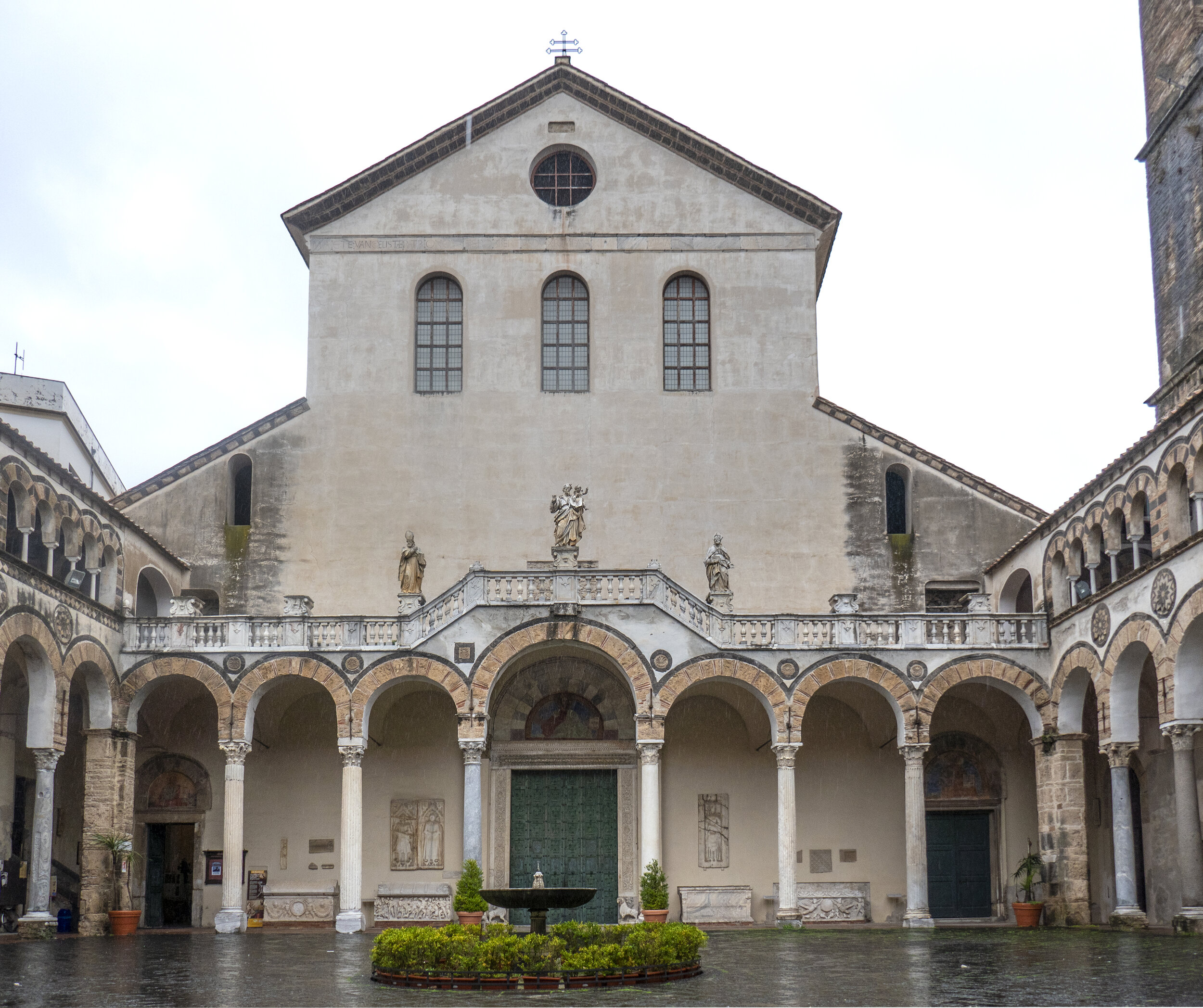
The Duomo’s 11th-century atrium contains 28 antique columns taken from the ancient Greek ruins of Paestum. Behind them are Roman sarcophagi recycled in the Middle Ages as tombs for dignitaries.
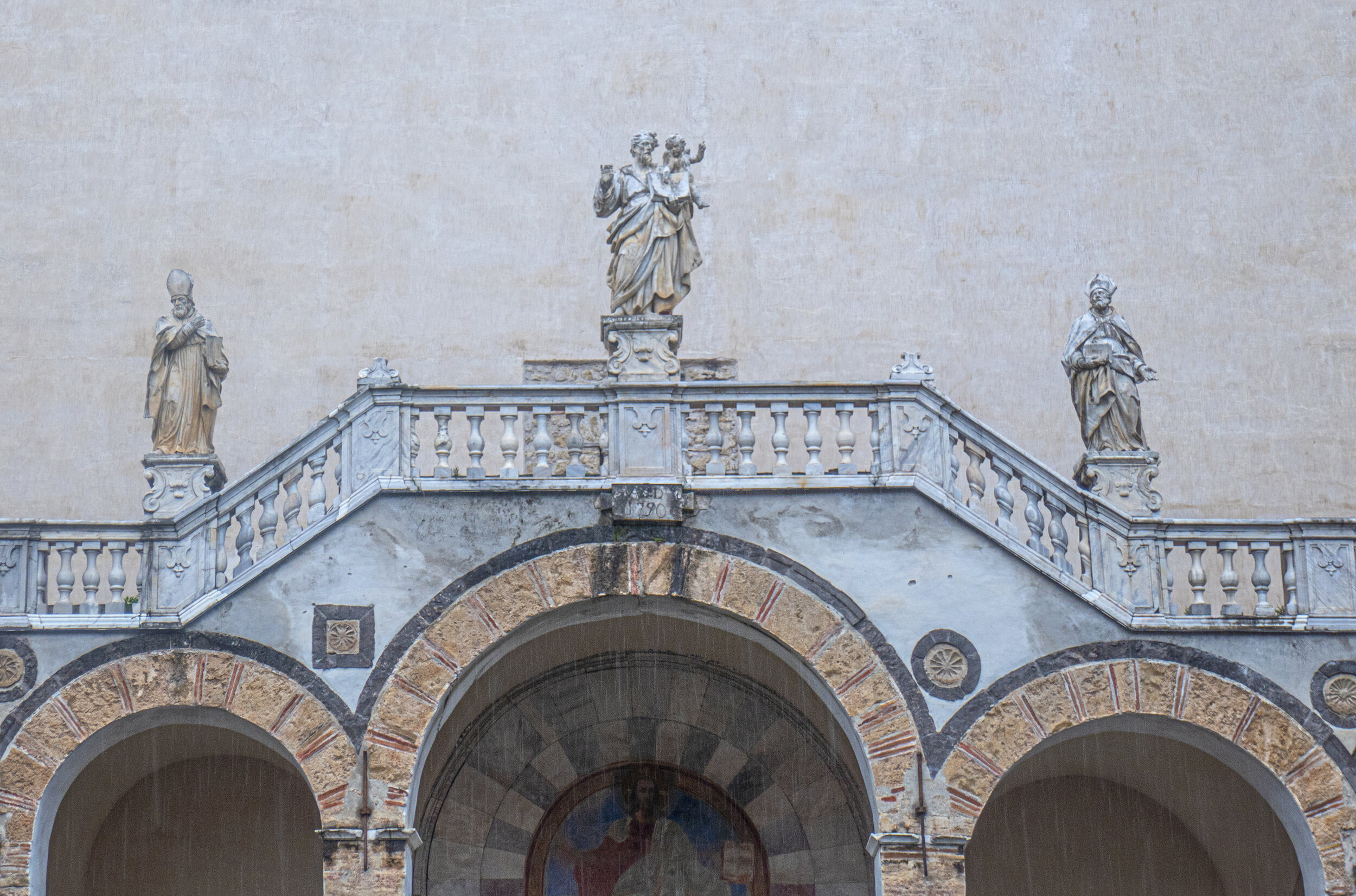
Atrium statues above a central doorway, include St. Matthew, completed in 1737 - bottom engraved with the sculptor's name, Matteo Bottigliero. Also, are statues of St Bonosio and St. Grammazio.
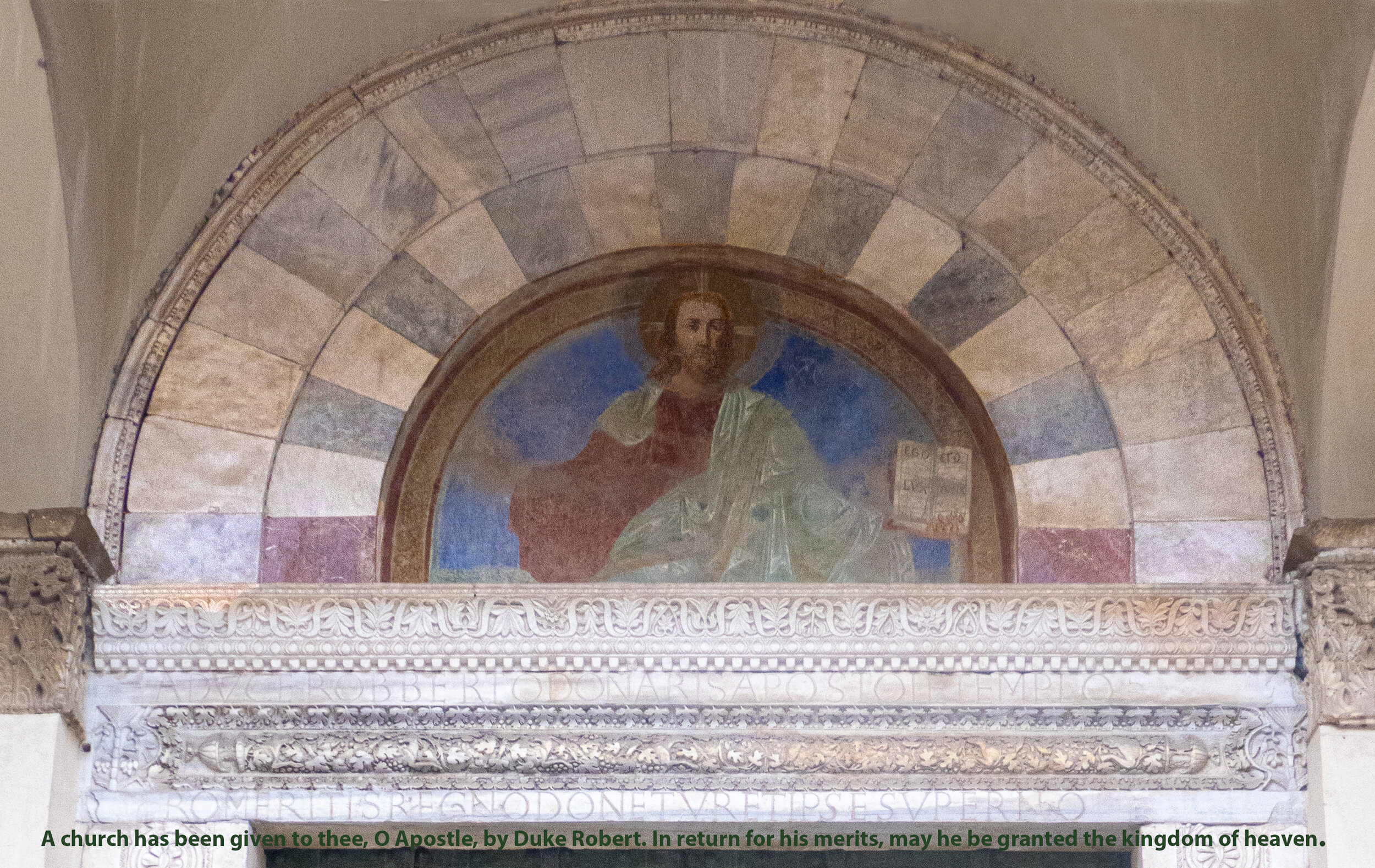
Lunette: St. Matthew with bible, welcoming the faithful. Inscription: "A church has been given to thee, O Apostle, by Duke Robert. In return for his merits, may he be granted the kingdom of heaven."
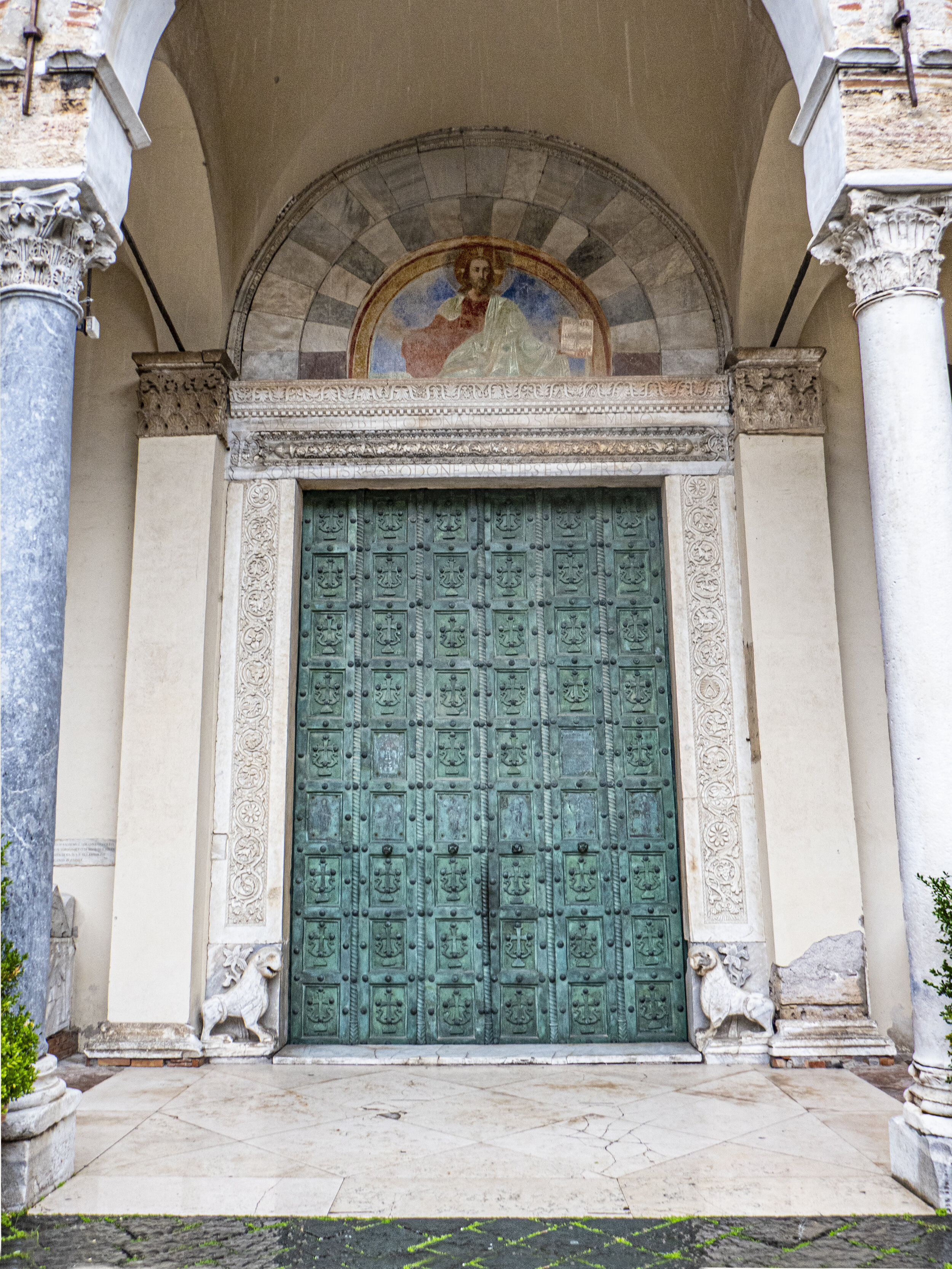
Below statues and lunette are Byzantine-style bronze doors from Constantinople (1099), with 54 panels, 46 in relief with a stylized cross and 8 etched panels; framed by a marble portal with two lions.

Virgin Mary door panel.

Peter the Apostle door panel.

Simon the Apostle door panel.
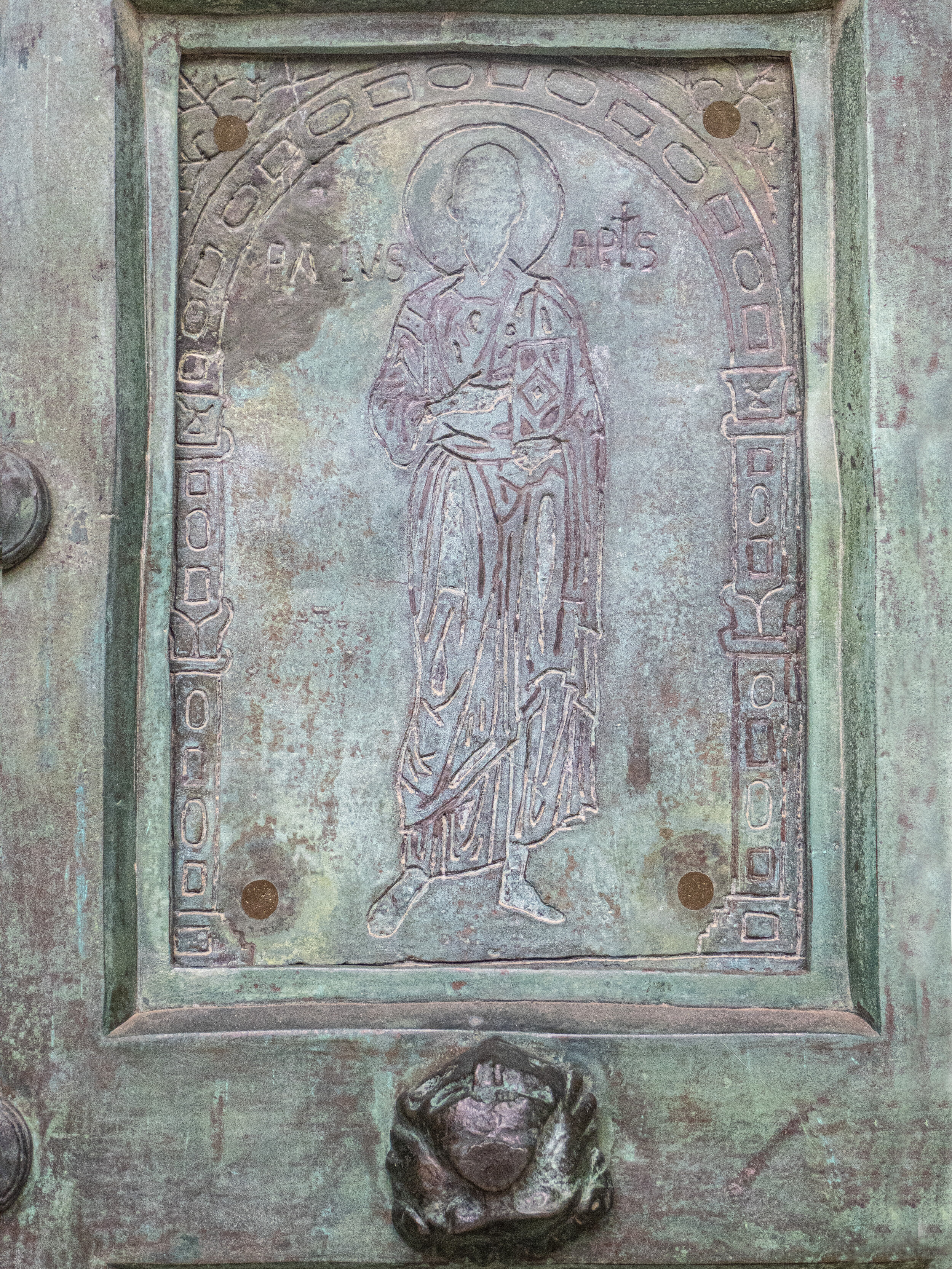
Paul the Apostle door panel.
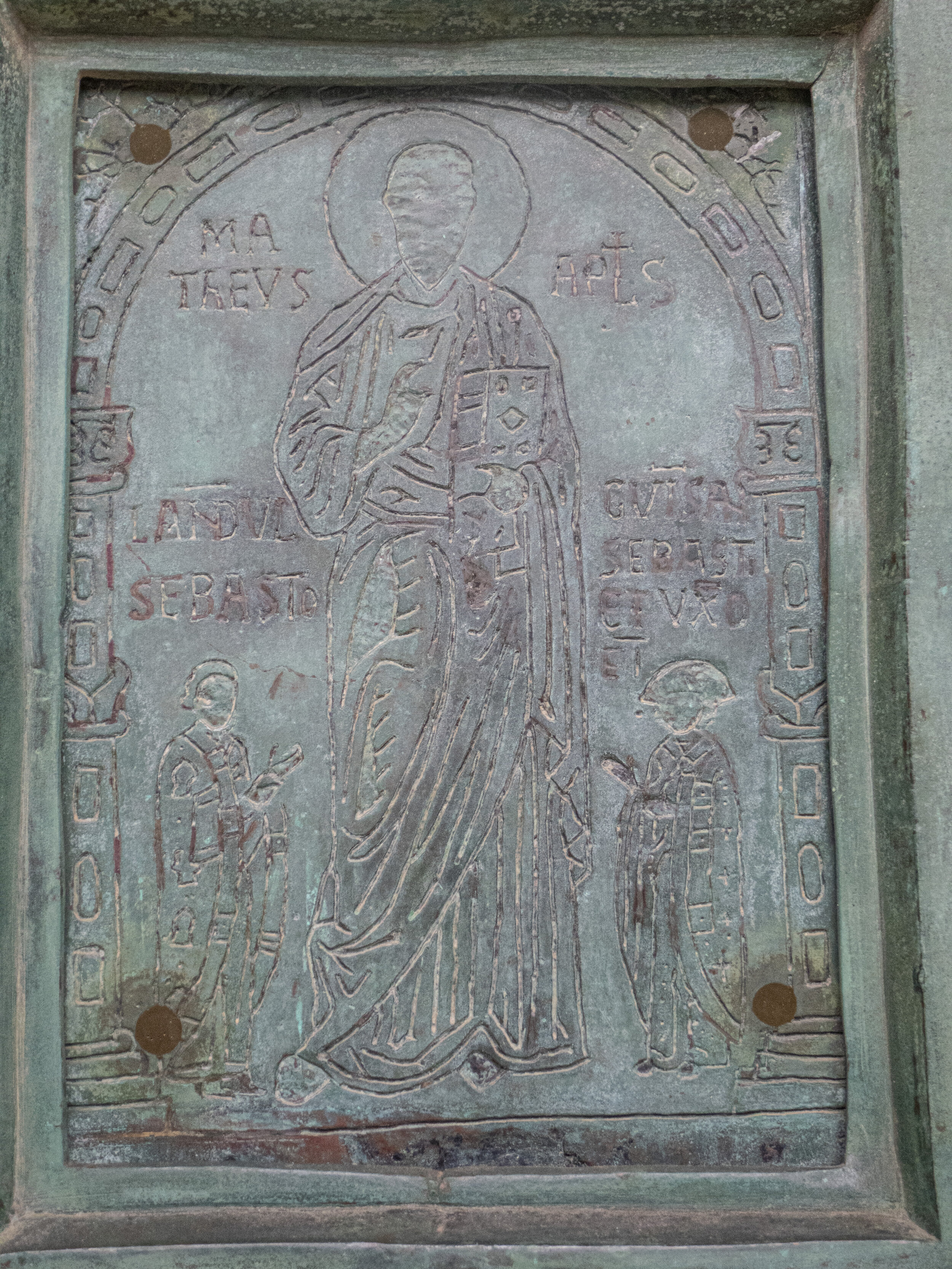
Matthew the Apostle door panel.
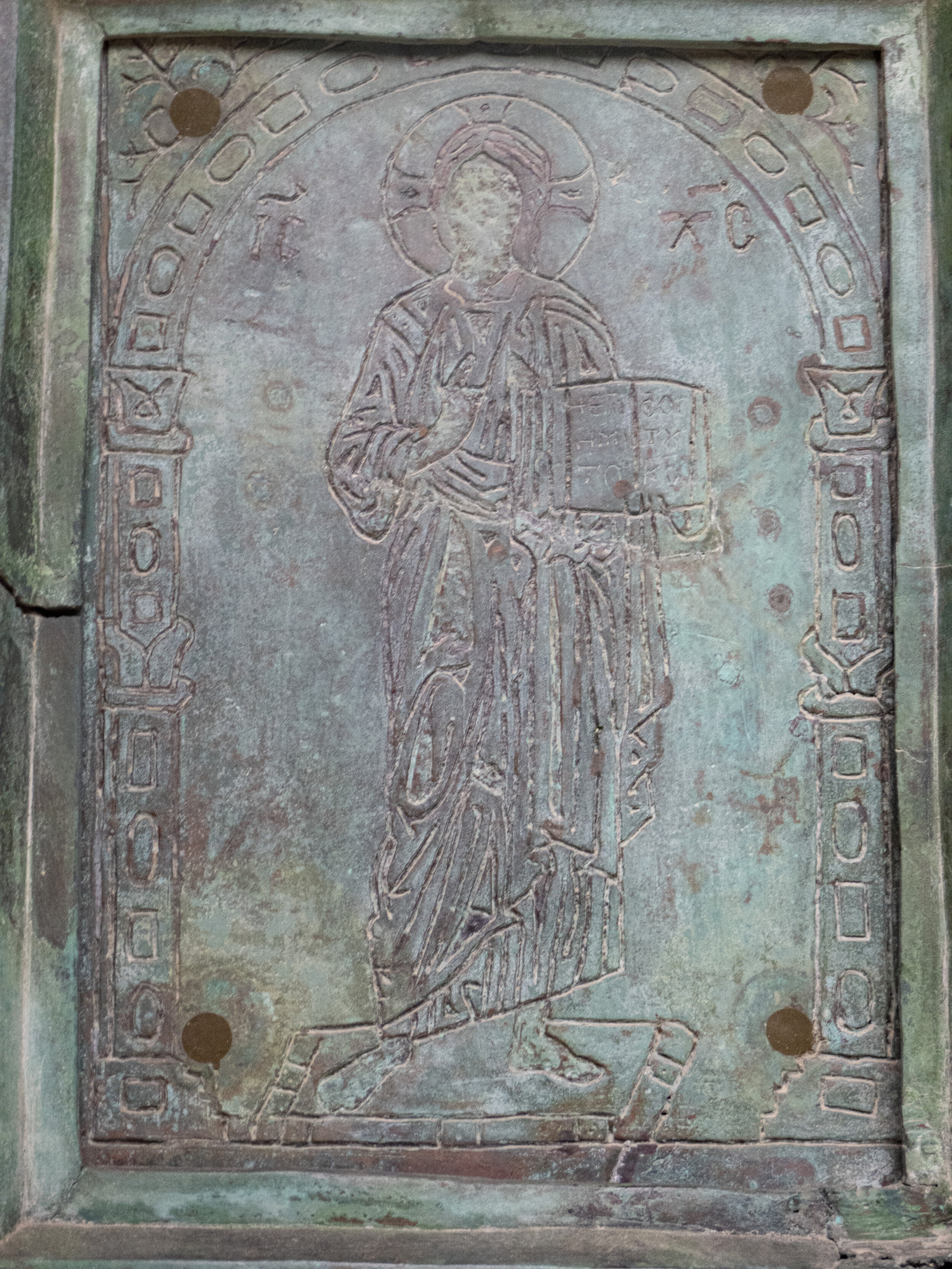
Jesus Christ panel.

The mid-12th c. bell tower, with small arcades, approximately 184 feet high and in Arabic-Norman style. It contains 8 large bells. The patron was Guglielmo da Ravenna, Archbishop of Salerno, 1137-1152
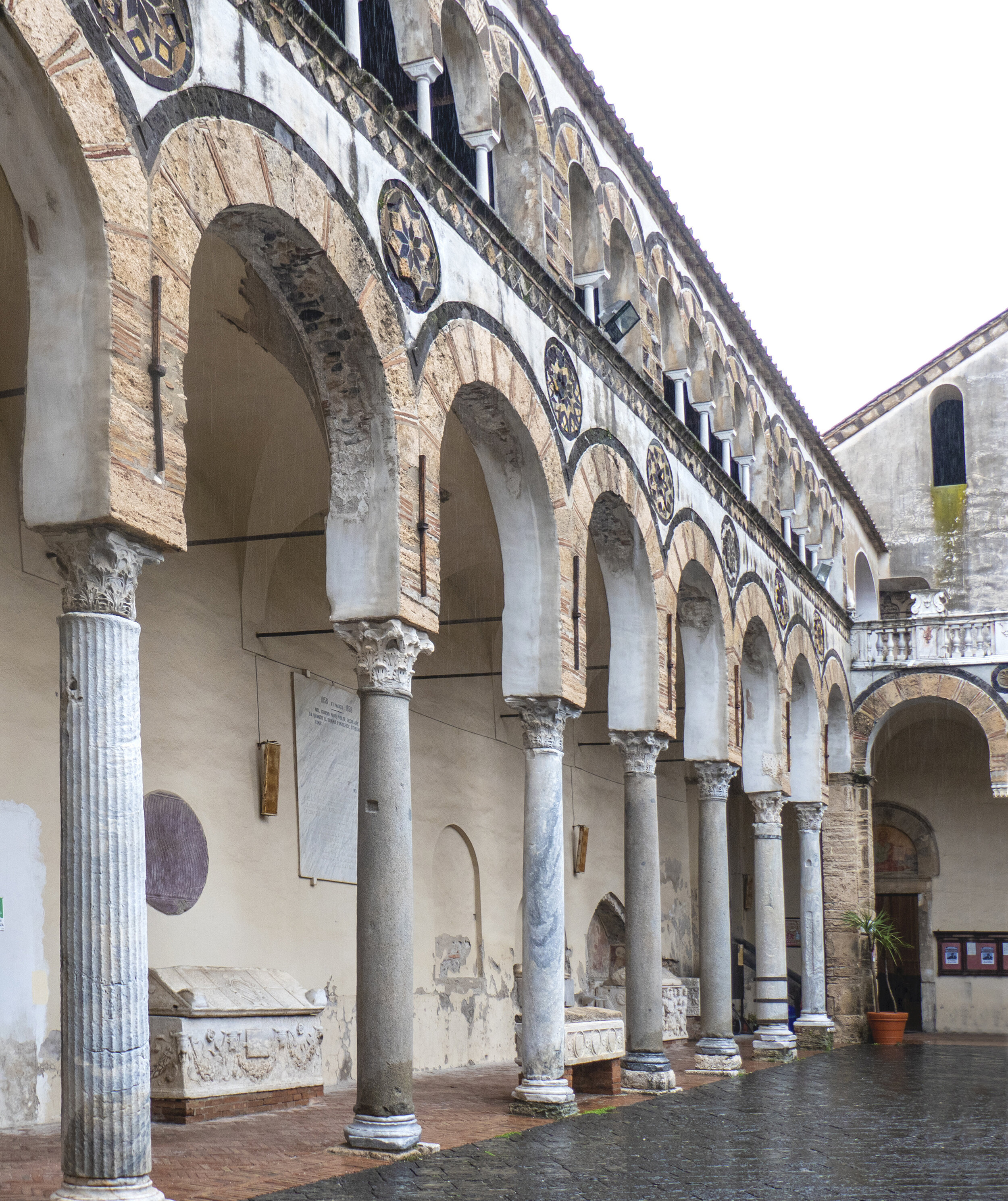
Romanesque atrium columns with rounded arches decorated with polychrome inlays, and above each a circular rosette; above all is a loggia with mullioned windows.
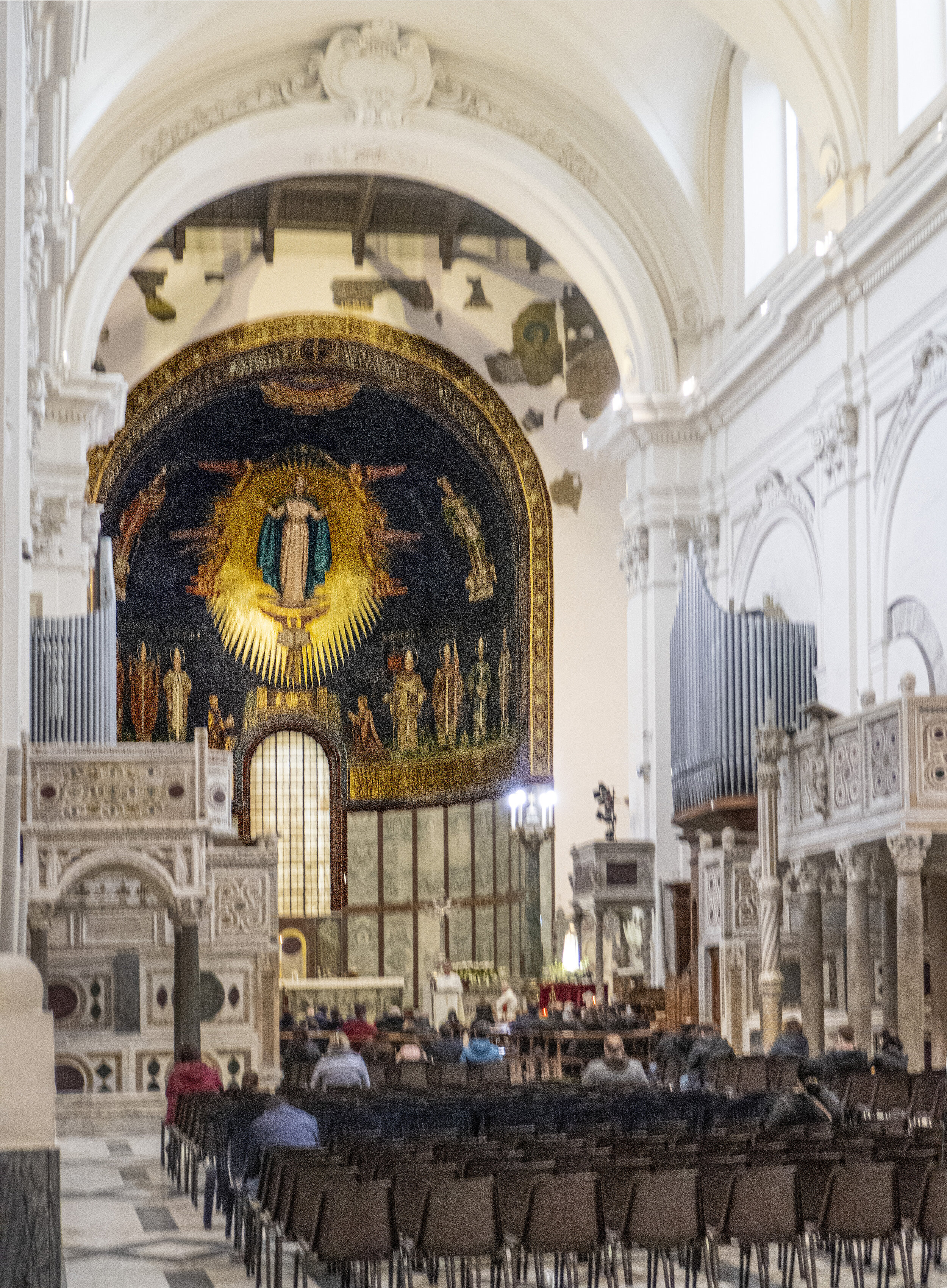
The upper central nave part of Saint Matthew Cathedral. On either side of the chairs in the middle of the picture are two ambo, (oblong pulpits with steps on each side) from which the Gospel is read.
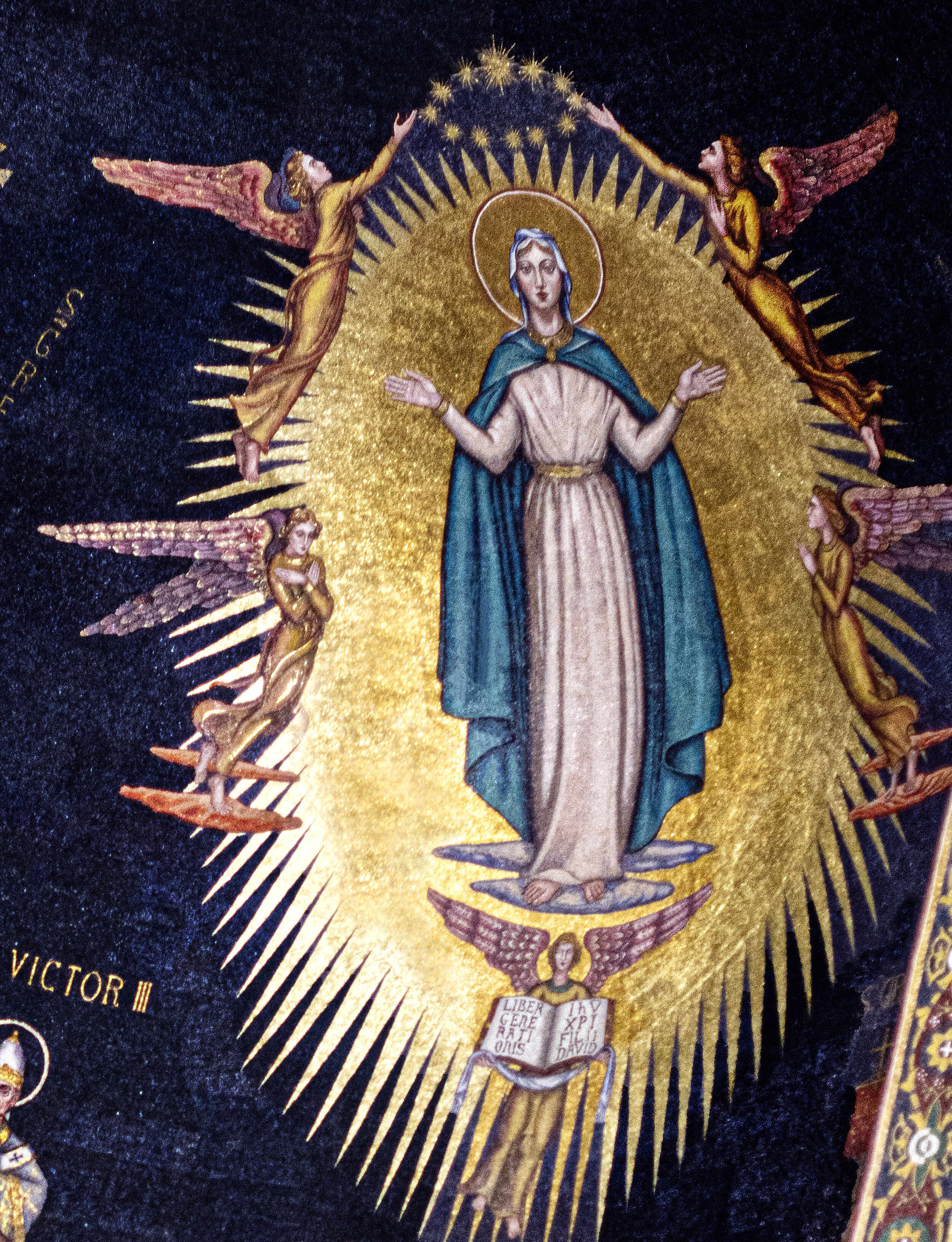
The central apse shows Mary surrounded by angels and saints. Saint Matthews Cathedral was built on an early Christian church dedicated to the holy Mary of the Angels.

12th-c D’Ajello Ambo (right side of the nave), its function mainly linked to the liturgy of Holy Easter, sits on 12 columns with capitals with carvings of figures & mosaic quincunx decorations above..

In the Cathedral's north nave, past the first Chapel with its Baptismal font, we came to Chapel II, dedicated to Saint Joseph by Archbishop Bonaventura Poeria - Appointed 11/11/1697, Died 11/18/1722.
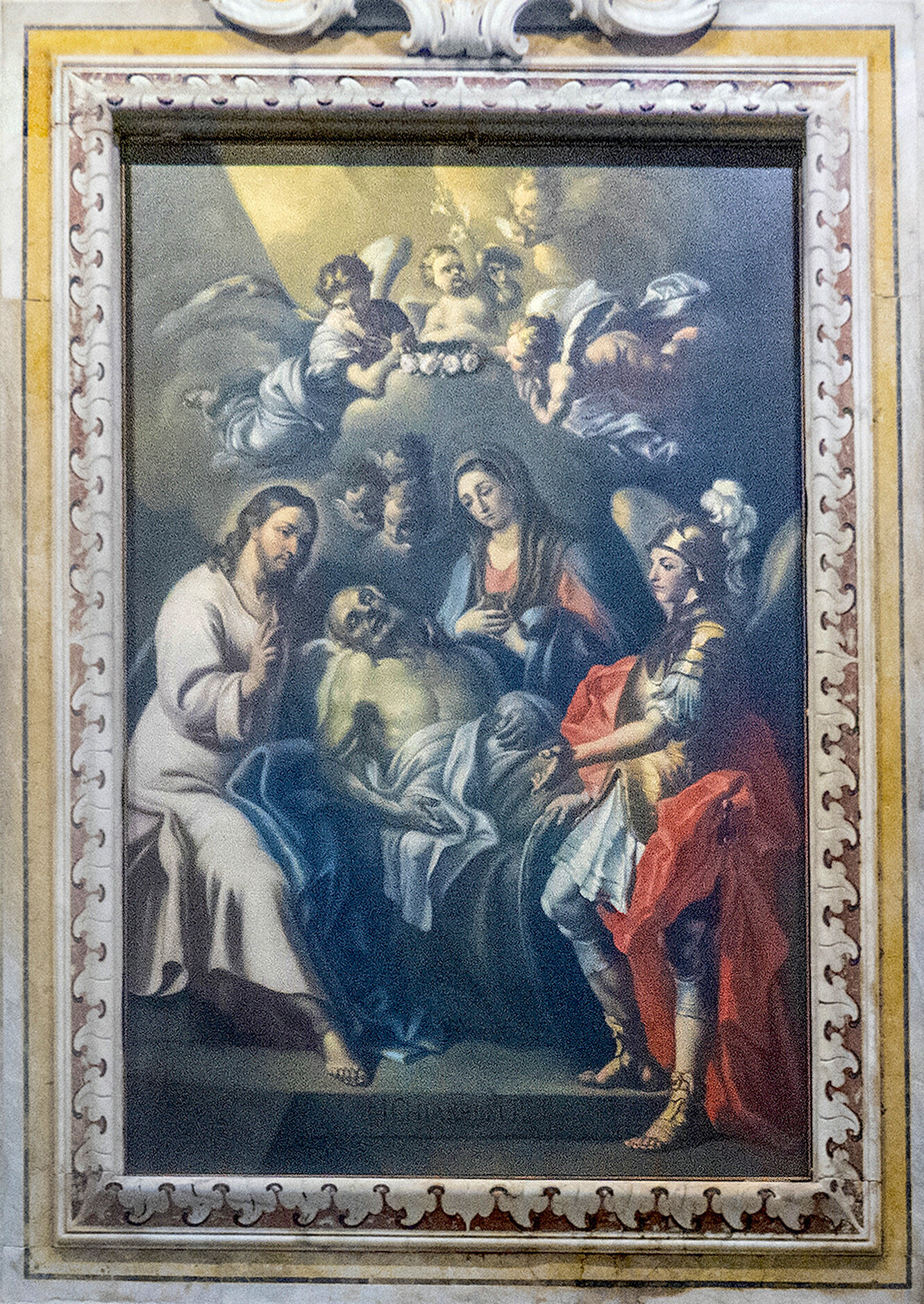
Painting, "The Transition of St. Joseph" by Matteo Chiariello, 18th-c.

Chapel III, the Pinto Family Chapel, was built by the will of the Pinto family in 1708.. Fortunado Pinto was an Archbishop of Salerno - Confirmed 6/26/1805; Died - 11/20/1825.
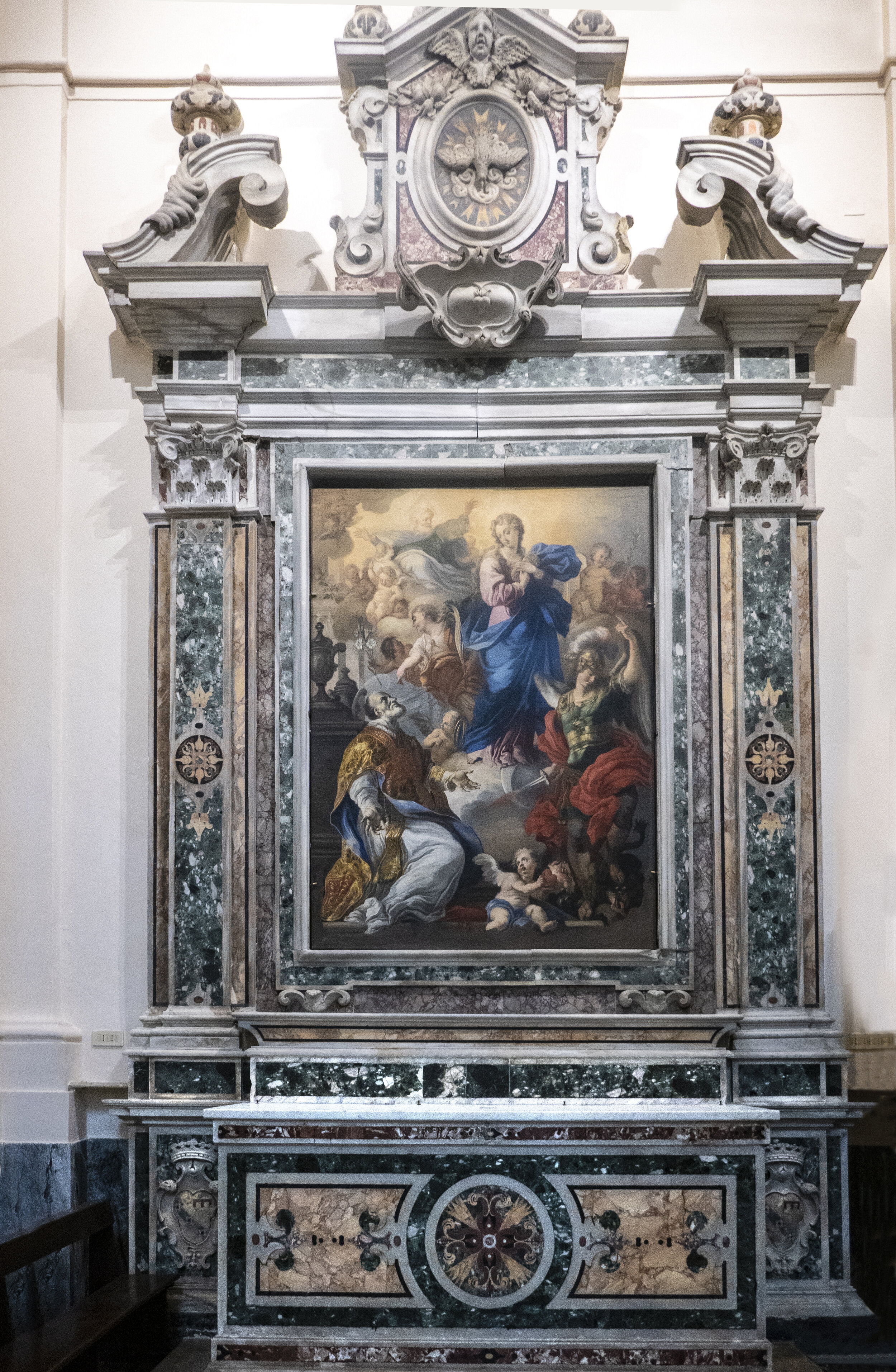
The Pinto family Chapel altar in polychromic marbles made by the master lapicide (stonecutter) Viginio Ogna.
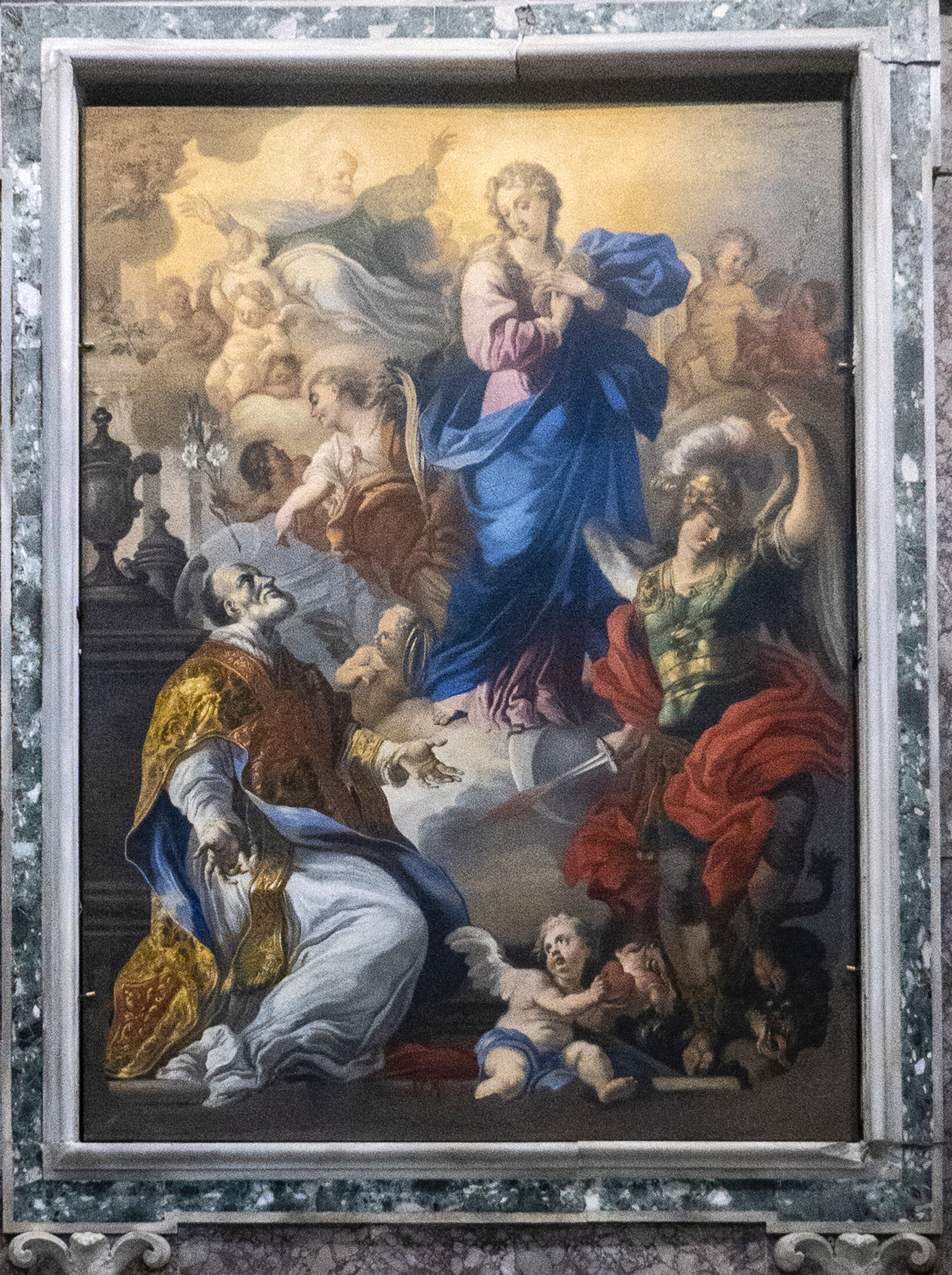
The Pinto altar painting represents "The Blessed Virgin with Saints Filippo Neri and Michael the Archangel" attributed to Michele Riicciardi, an artist working in the first half of the 18th c.
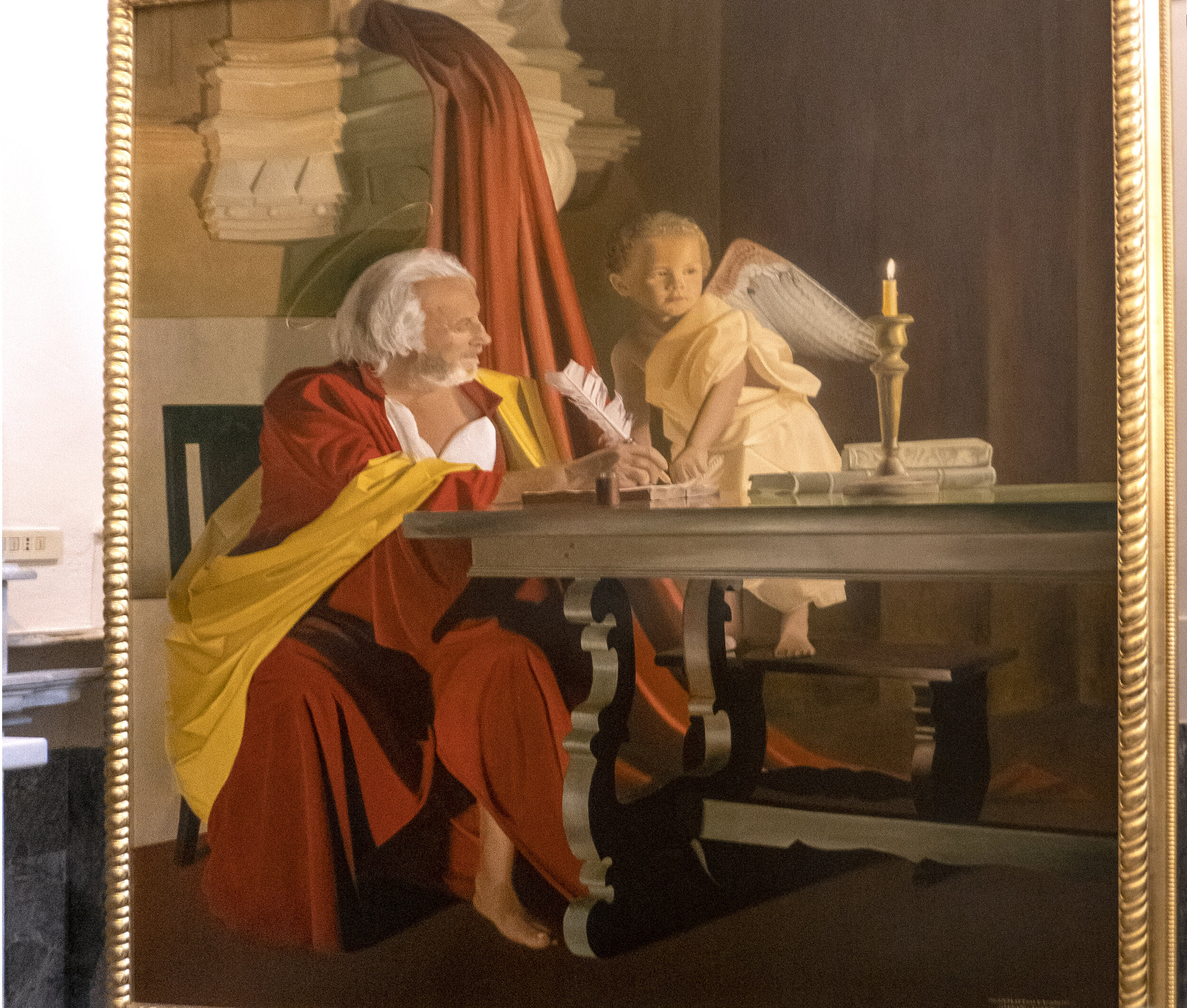
The painting "Saint Matthew and the Angel" by Stefano Trapanese, 2011 is owned by the Salerno municipality and will be located in the future Court City of Salerno when it is completed.
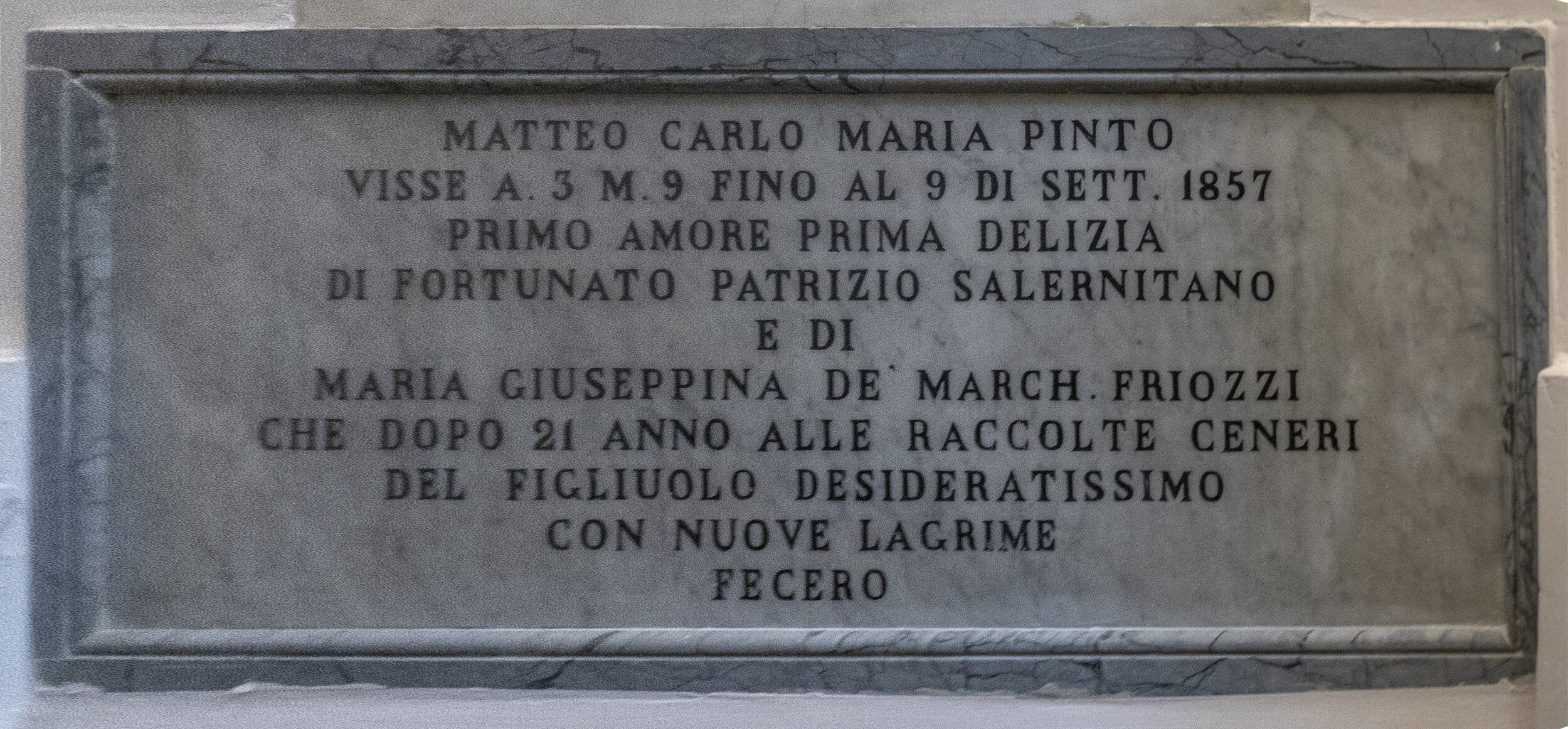
The tomb stones placed on the Pinto Chapel walls, and the one on the floor in front of the chapel (left side), remember the sepulchers of the family members, e.g. Matteo Carlo Maria Pinto, died 1857.
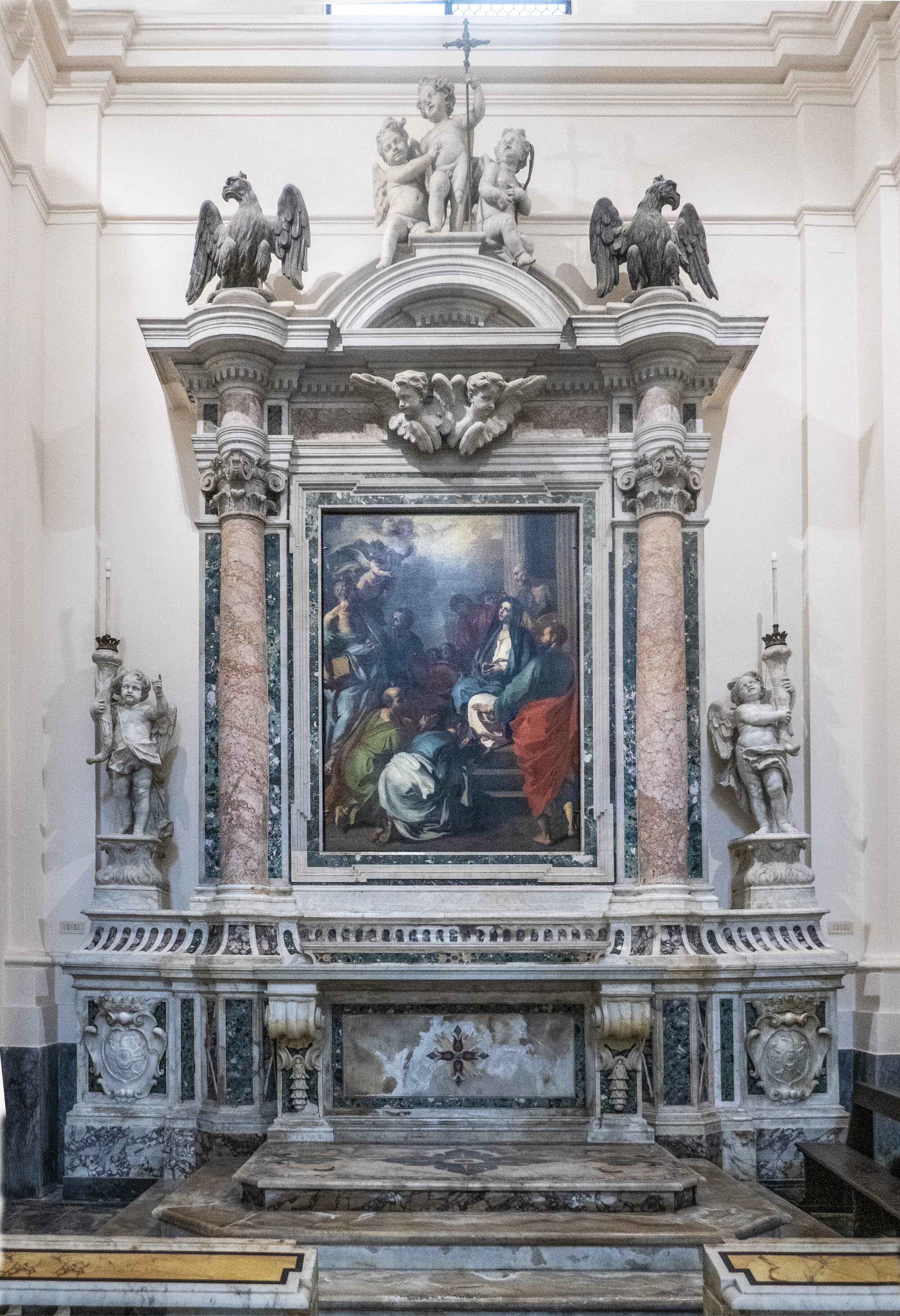
Chapel IV, The Pentecost Chapel, originally belonged to the Lembo family and later to the Lauro-Grotto family. It was executed by Ferdinando Sanfelice in 1717; Virginio Ogna made the marble altar.
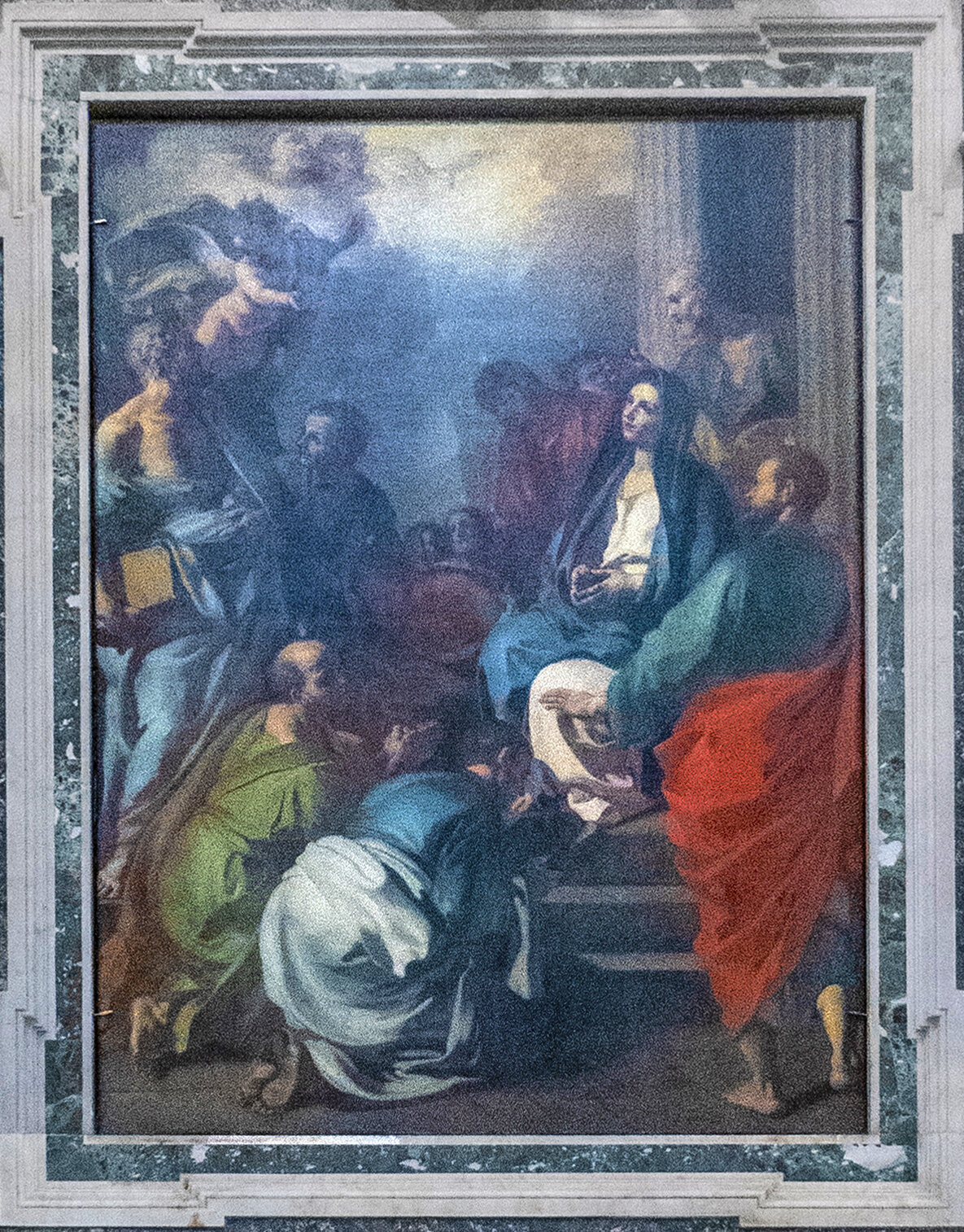
Above the Lembo altar is the painting depicting the Pentecost (the coming of the Holy Spirit upon the Apostles 40 days after Easter and 50 days after the Jewish Passover) by Francesco De Mura in 1722.
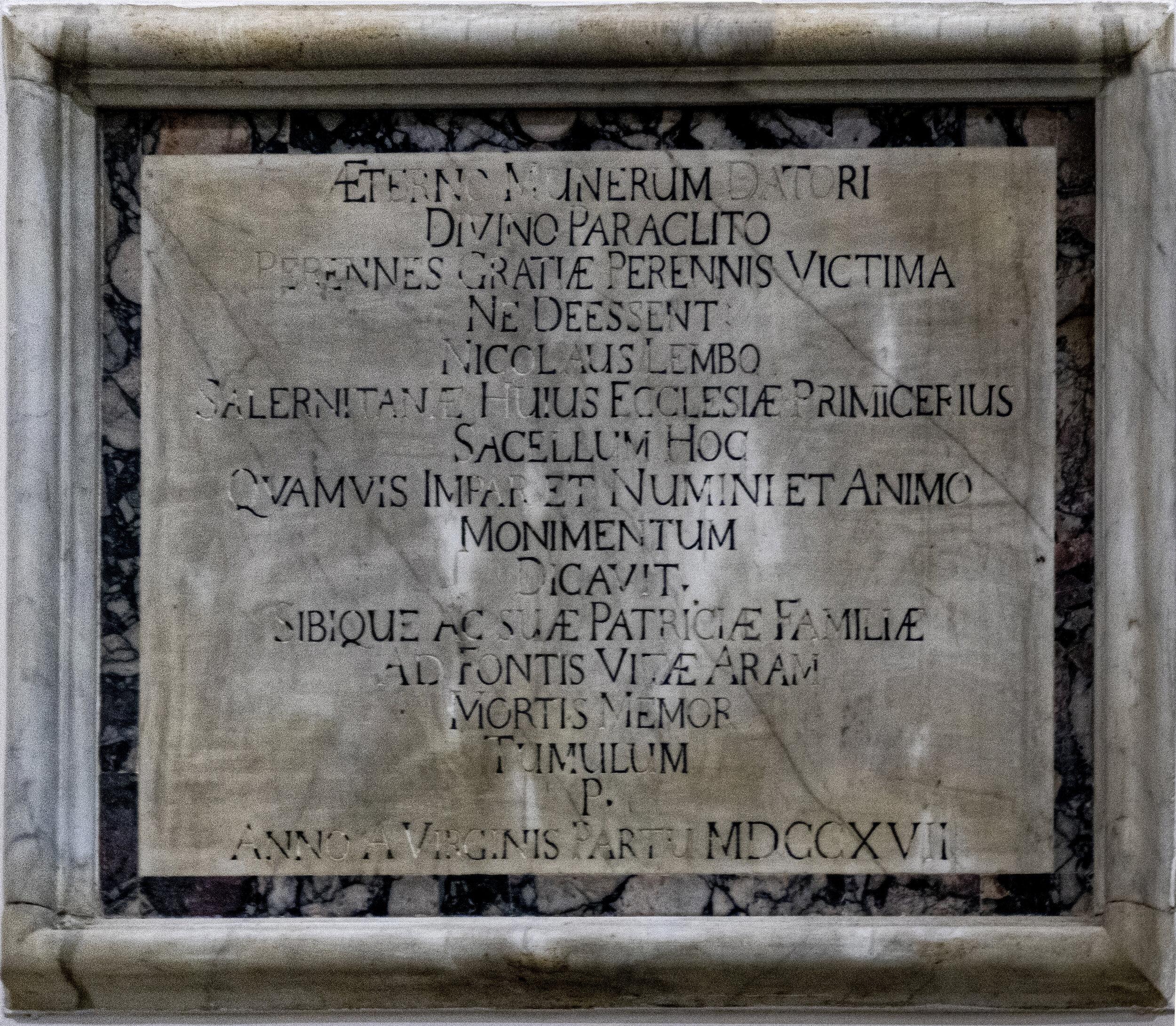
Dedication on wall of the Lembo family's Pentecost Chapel to Nicholas Lembo who died in 1717.
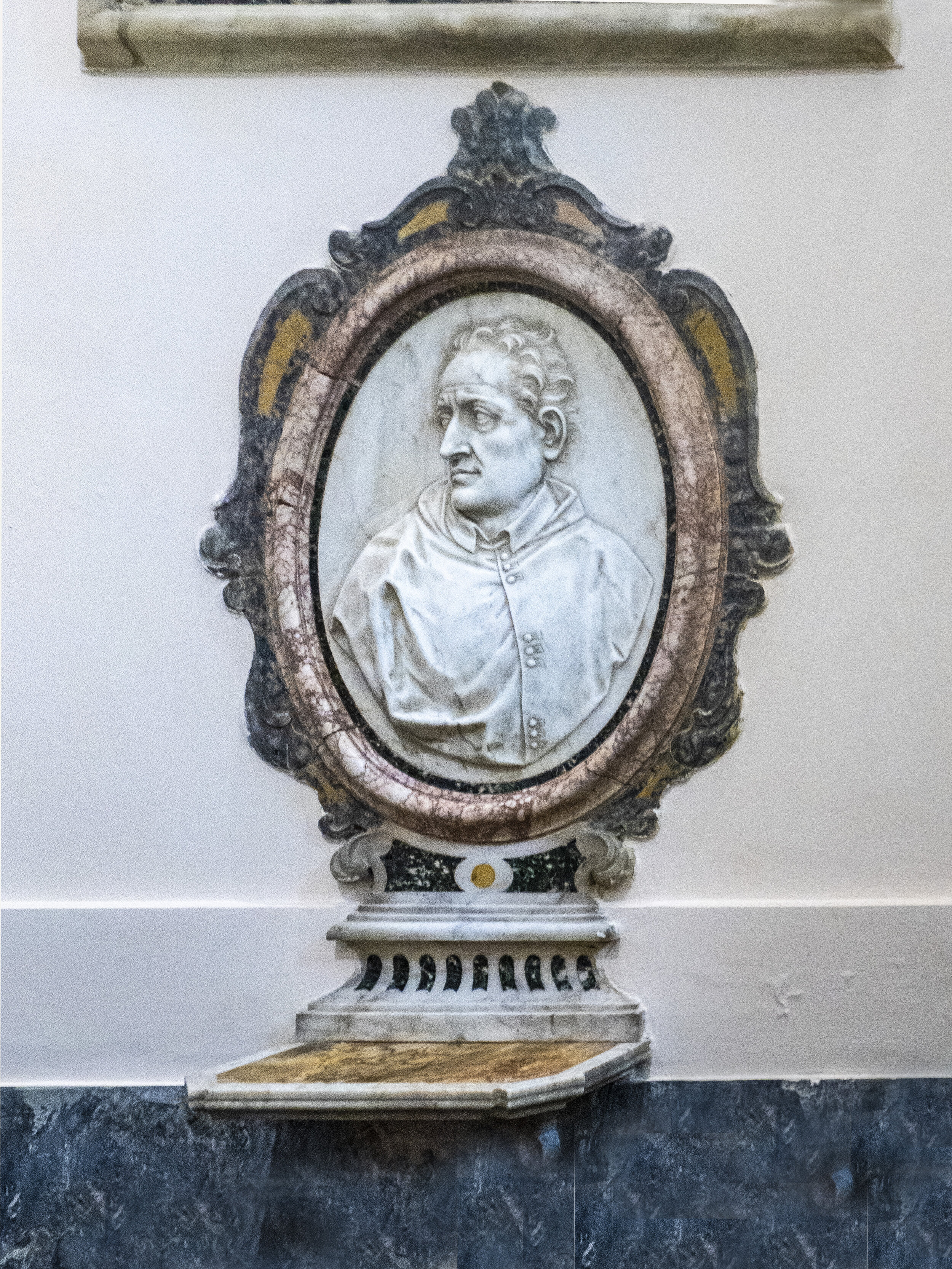
The medallion represents the founder of the Pentecost Chapel, Nicholas Lembo (d. 1717). It was sculpted by Matteo Bottigliero in 1722 and is located below the dedication marker.
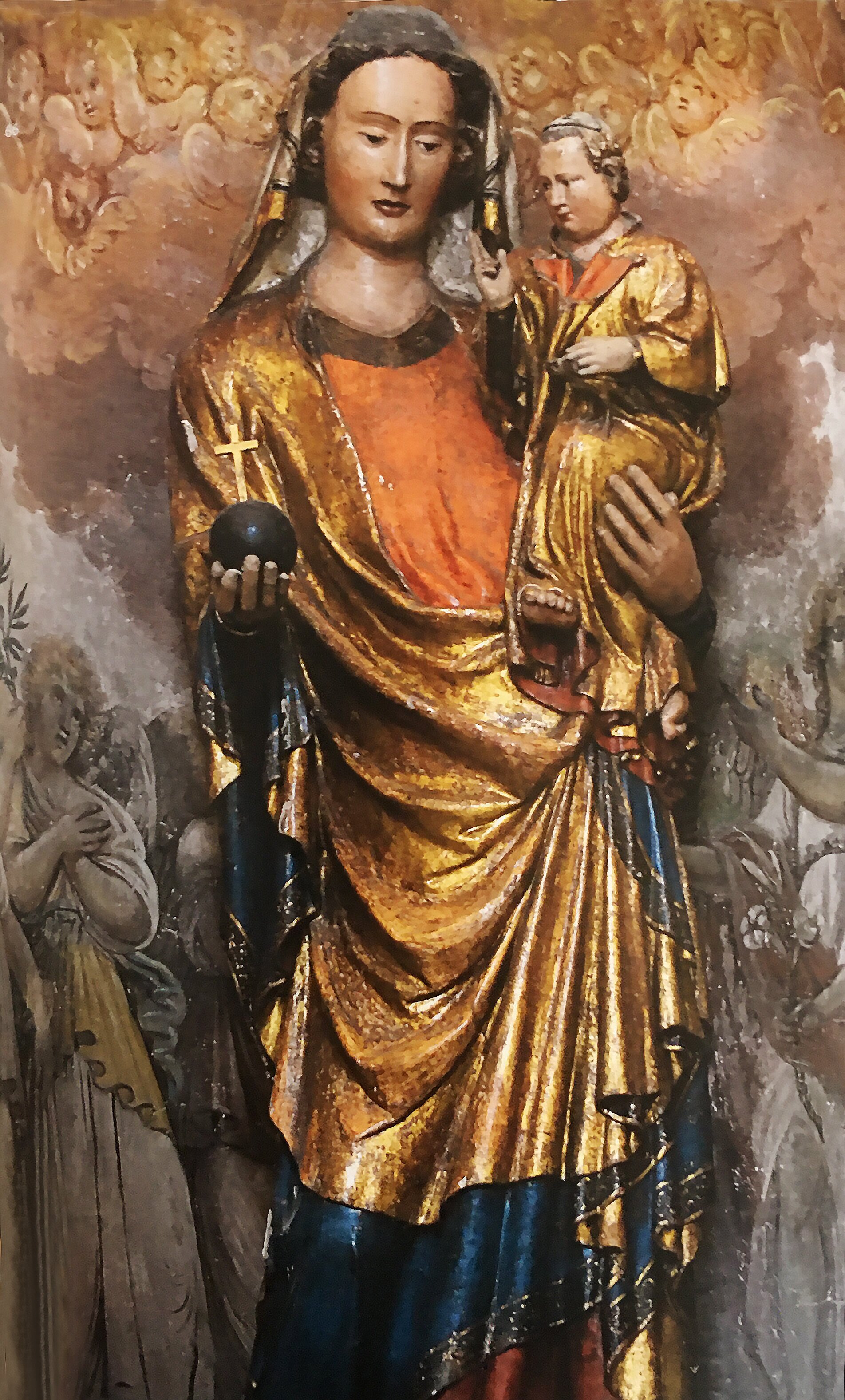
Chapel V (northern nave) belonged to the De Ruggerio family. At the beginning of the 19th c. Archbishop Fortunato Pinto placed here the wooden sculpture of "Saint Mary of the Angel" (dated 1364-1378).
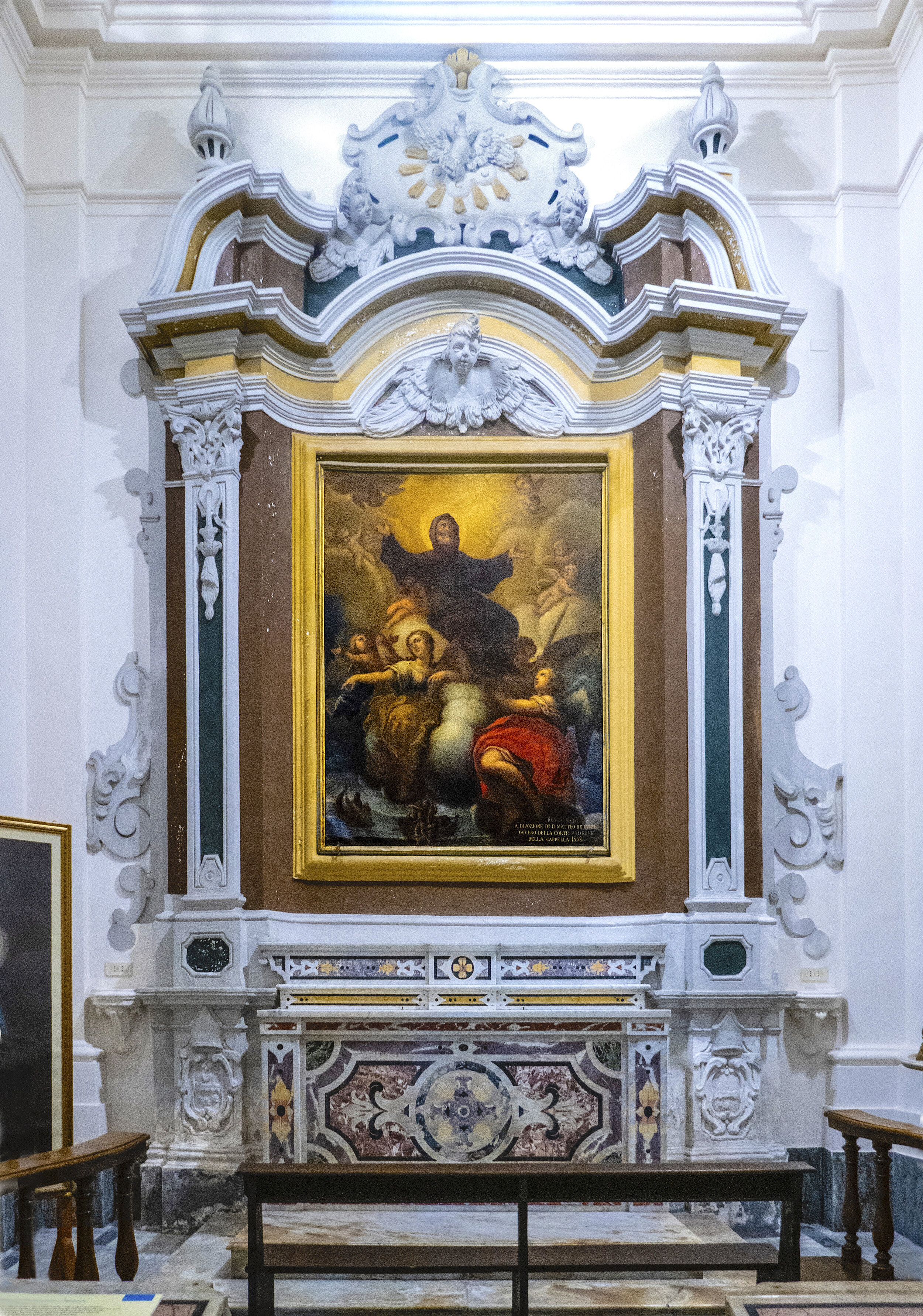
Chapel VI originally belonged to the Di Donato family, was dedicated to San Francesco di Paola. Later it became the property of the Della Corte family.

The painting shows "Saint Francis of Paola in Accendence to Glory" and has been dated as having been completed sometime in the 1730's.
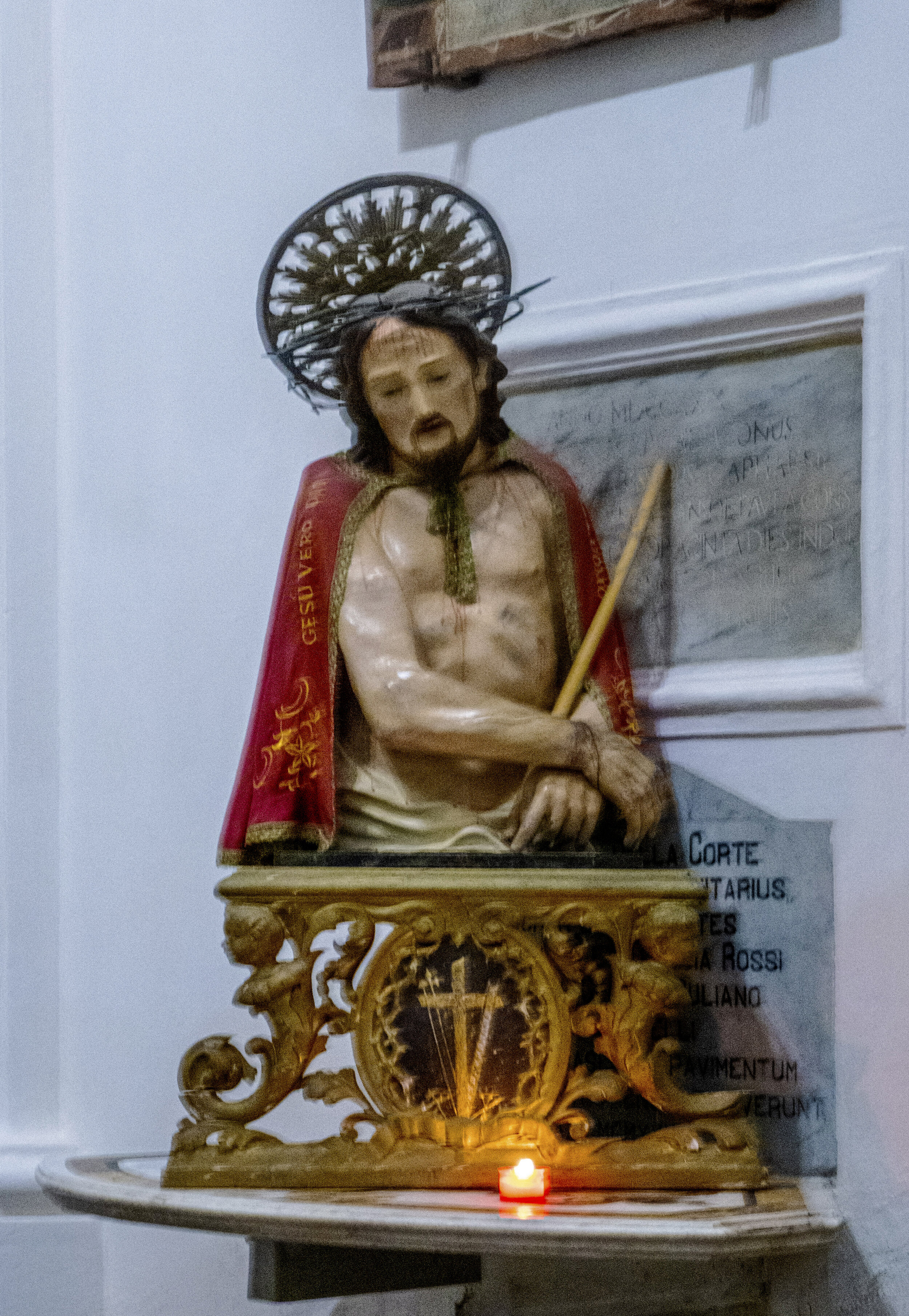
Chapel VI, statue of Christ kneeling with wounds from his crucifixion in front of a tomb memorial of a Della Corte family member.
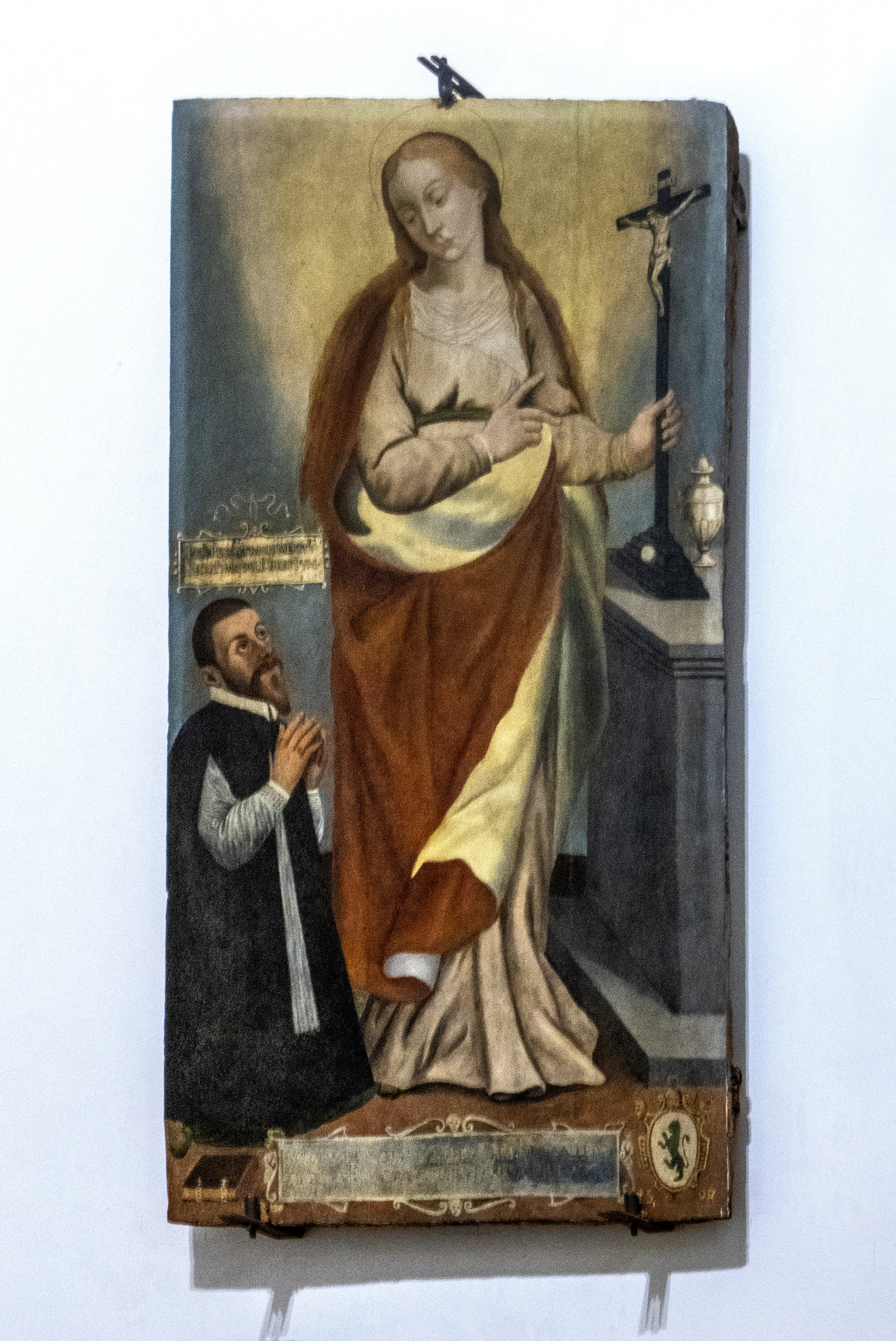
Chapel VI, above the statue of Christ, a painting possibly depicting an apparition of the Virgin to Saint Francis of Paola (3/27/1416 - 4/2/1507), born in Paola, Cosenza, and patron saint of Calabria
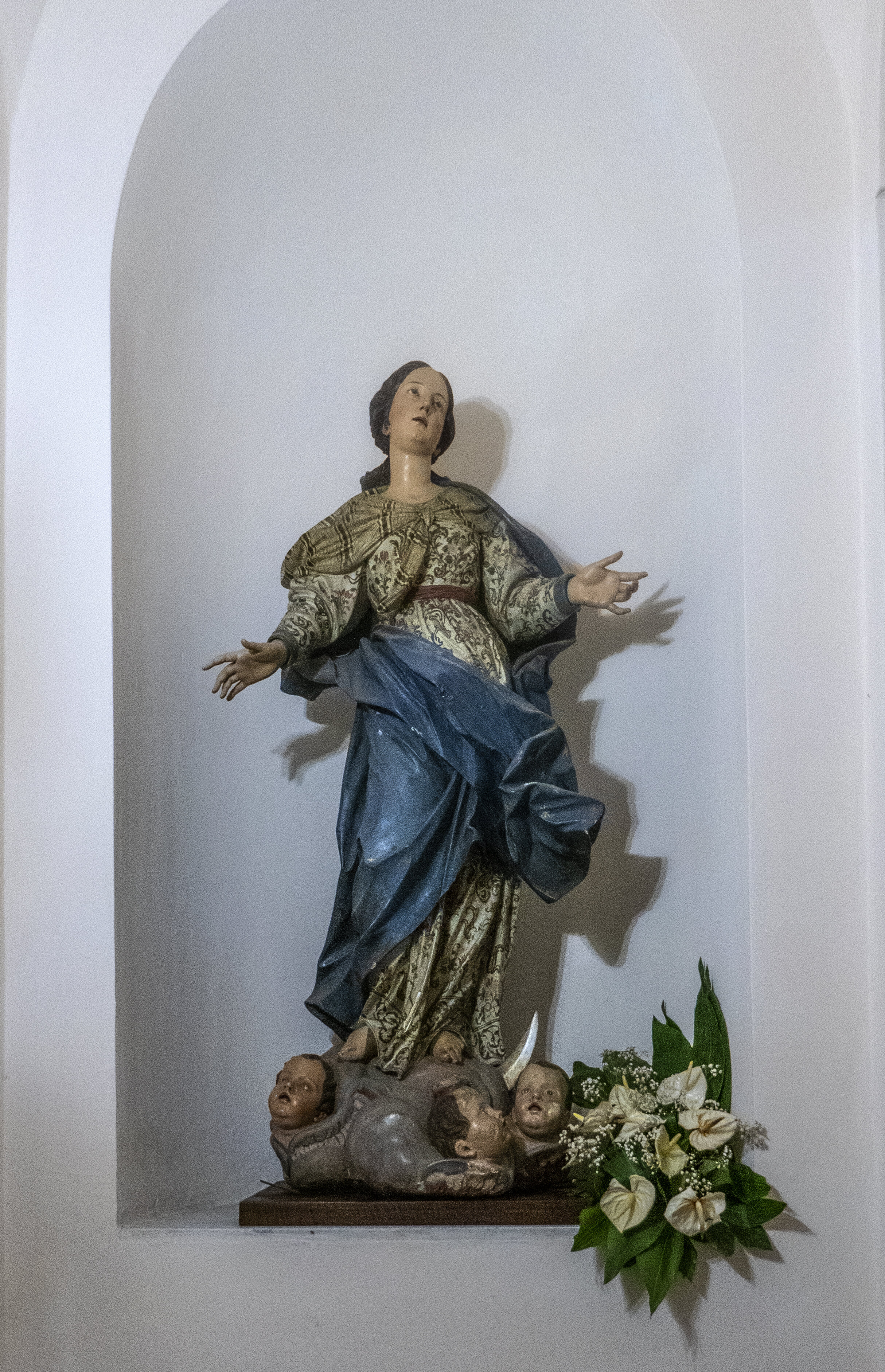
Chapel VI, alcove containing a statue of the Virgin Mary with cherubs at her feet.
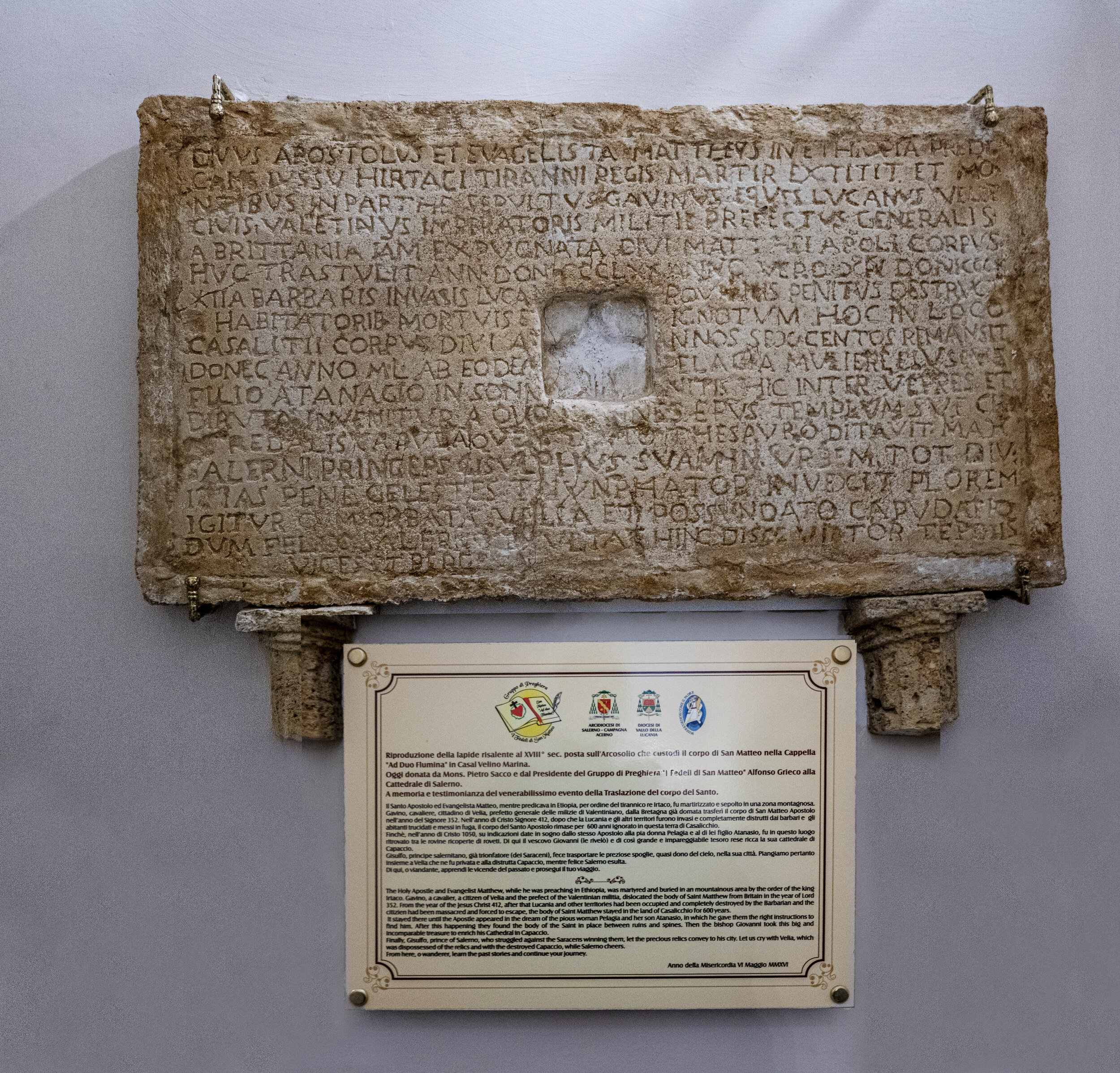
Entering the crypt area the Saint Matthew's tombstone in Latin with translation (below) describes how his remains were found and brought in 1091 to rest in the crypt under the Cathedral.
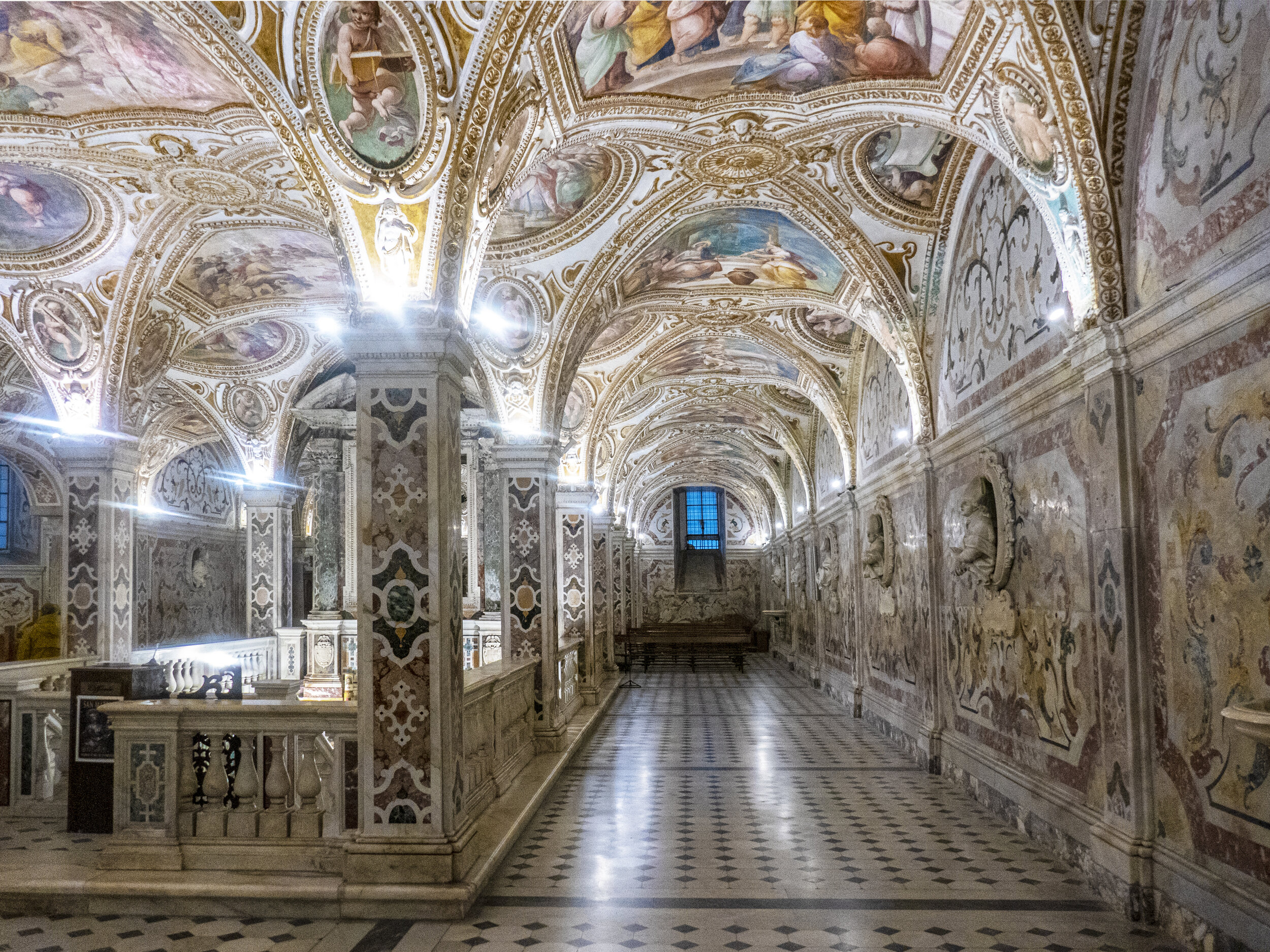
We enter Saint Matthew's crypt under the Cathedral in its southern nave. The crypt was the first nucleus in the construction of the Cathedral in 1091.
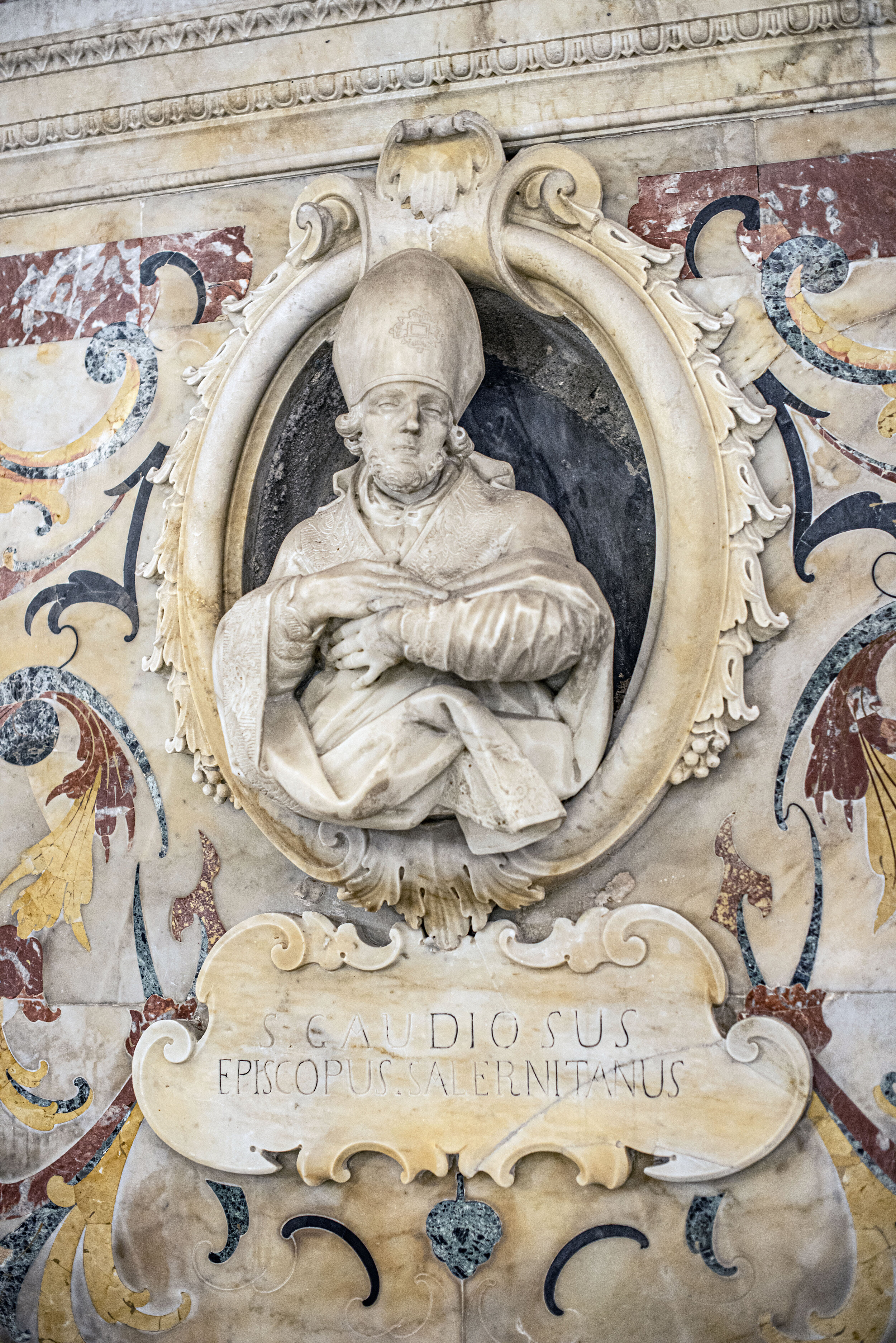
Along the walls of the crypt are busts of Archbishops of Salerno, such as Gaudiosus, shown here.
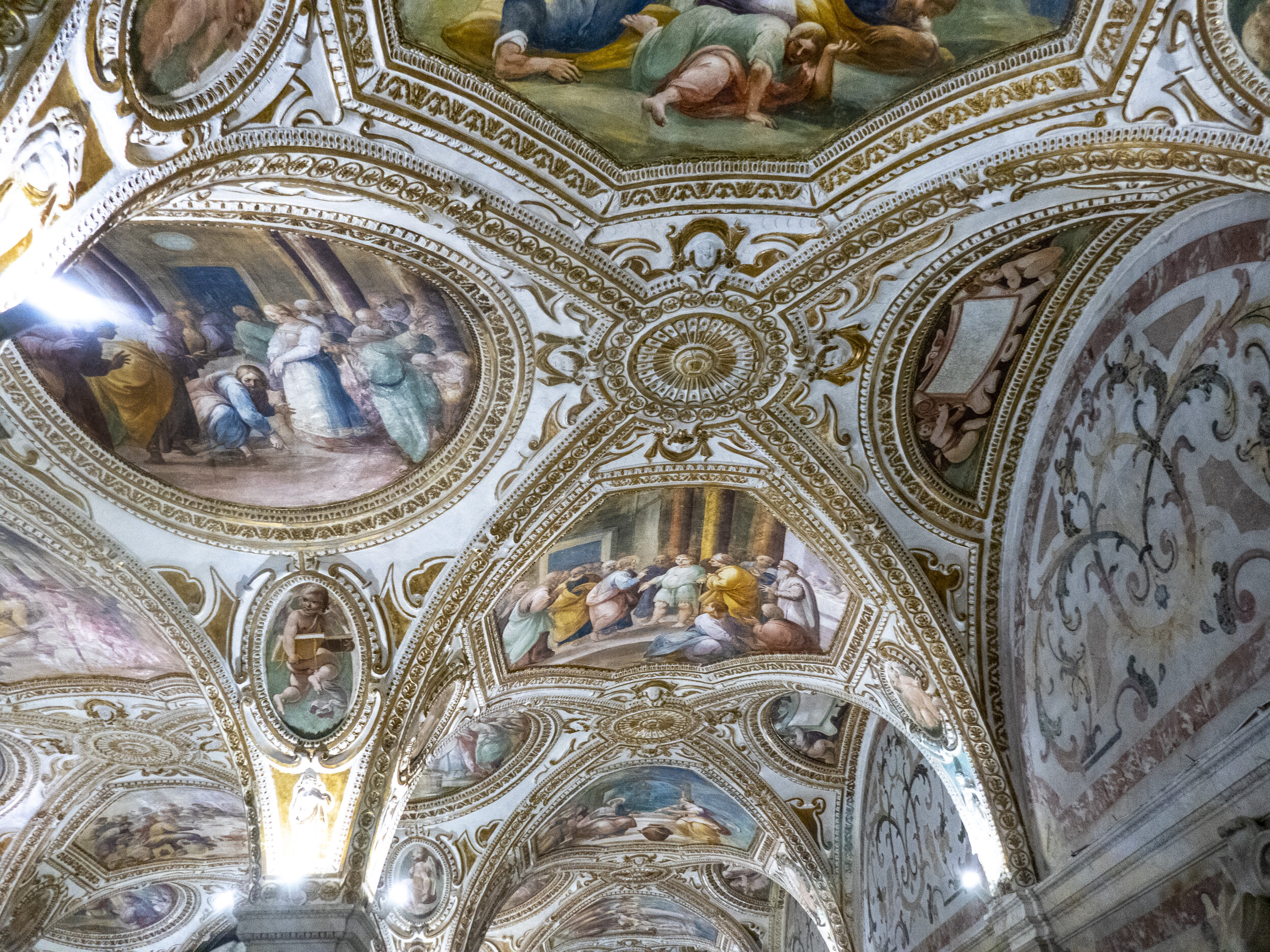
The ceiling of the crypt has a Baroque garment (curving forms including oval forms - concave and convex) following the 17th c. (1606-1608) work by the architects Domenico and Giulio Cesare Fontana.
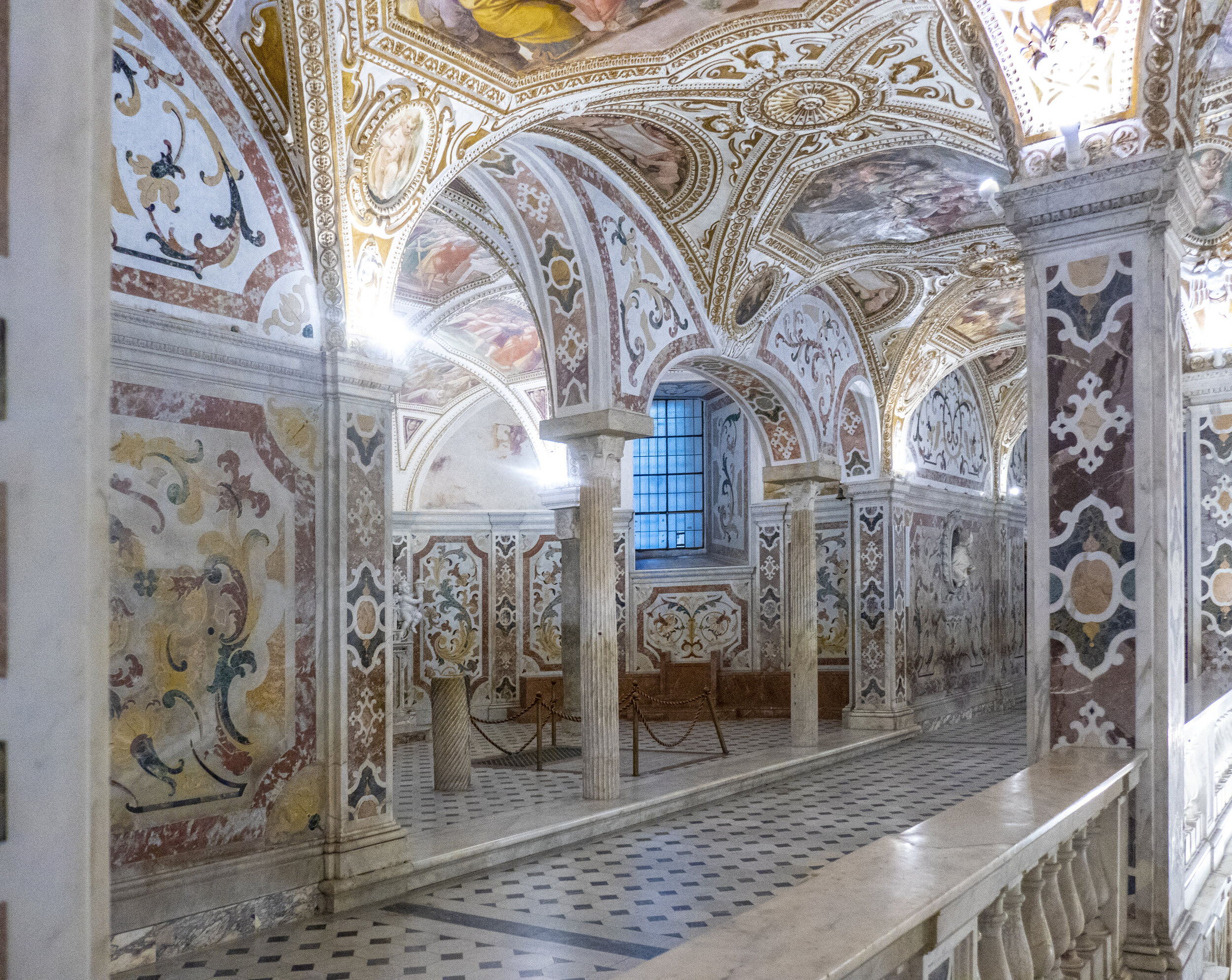
This picture of the north nave of the crypt shows the stone inlay designs on walls and paintings depicting events in the lives of Jesus Christ and St. Matthew, and Salerno.

"Mary's Visitation to Elizabeth" (Luke 1:39-56) by B.Corenzio. Mary is pregnant with Jesus and Elizabeth is pregnant with John the Baptist and is filled with he Holy Spirit hearing Mary's greeting.
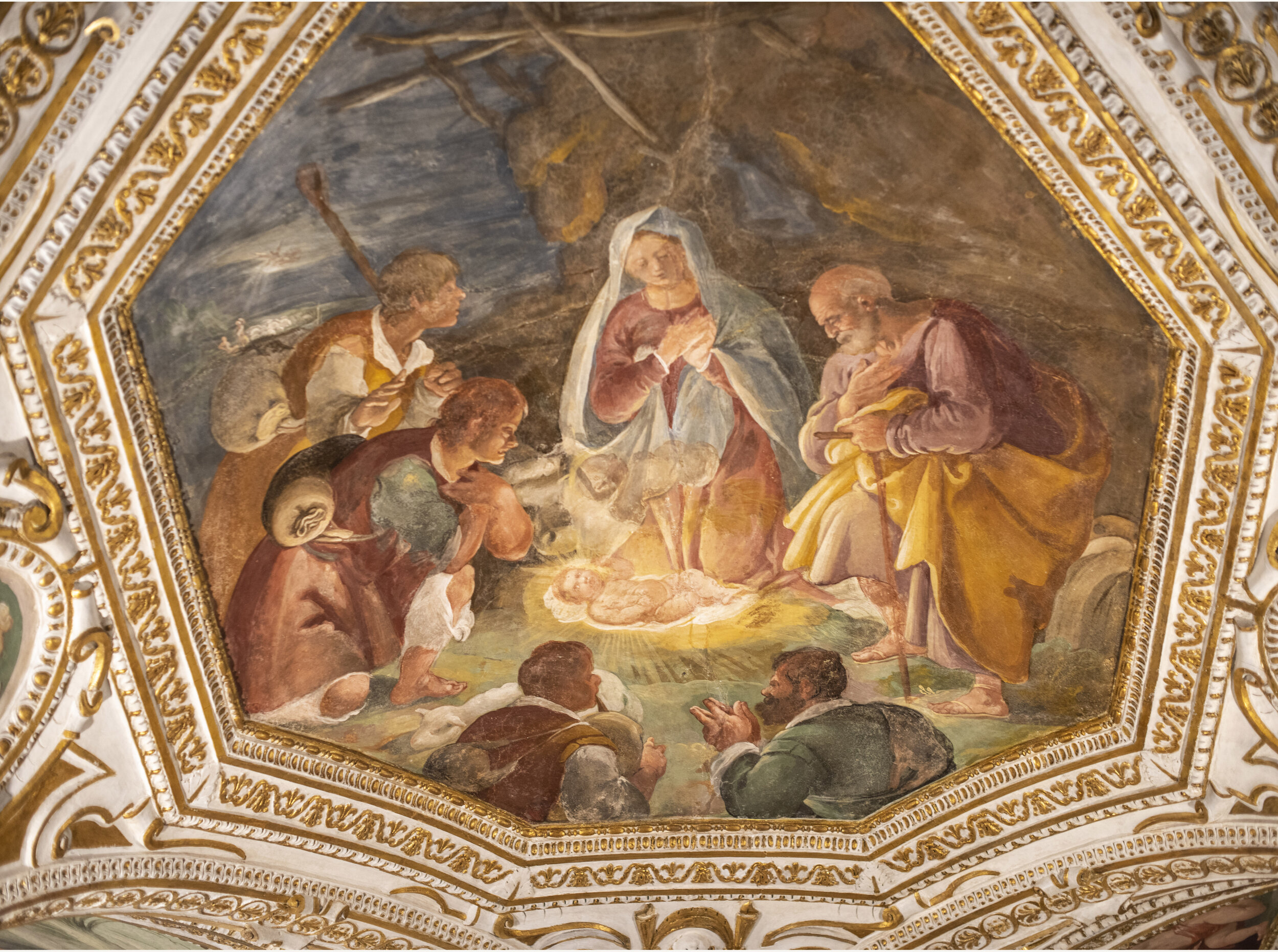
In his depiction of "Jesus in the Manger," Belisario Corenzio places Jesus in humble surroundings with everyday people who have traveled to see him.
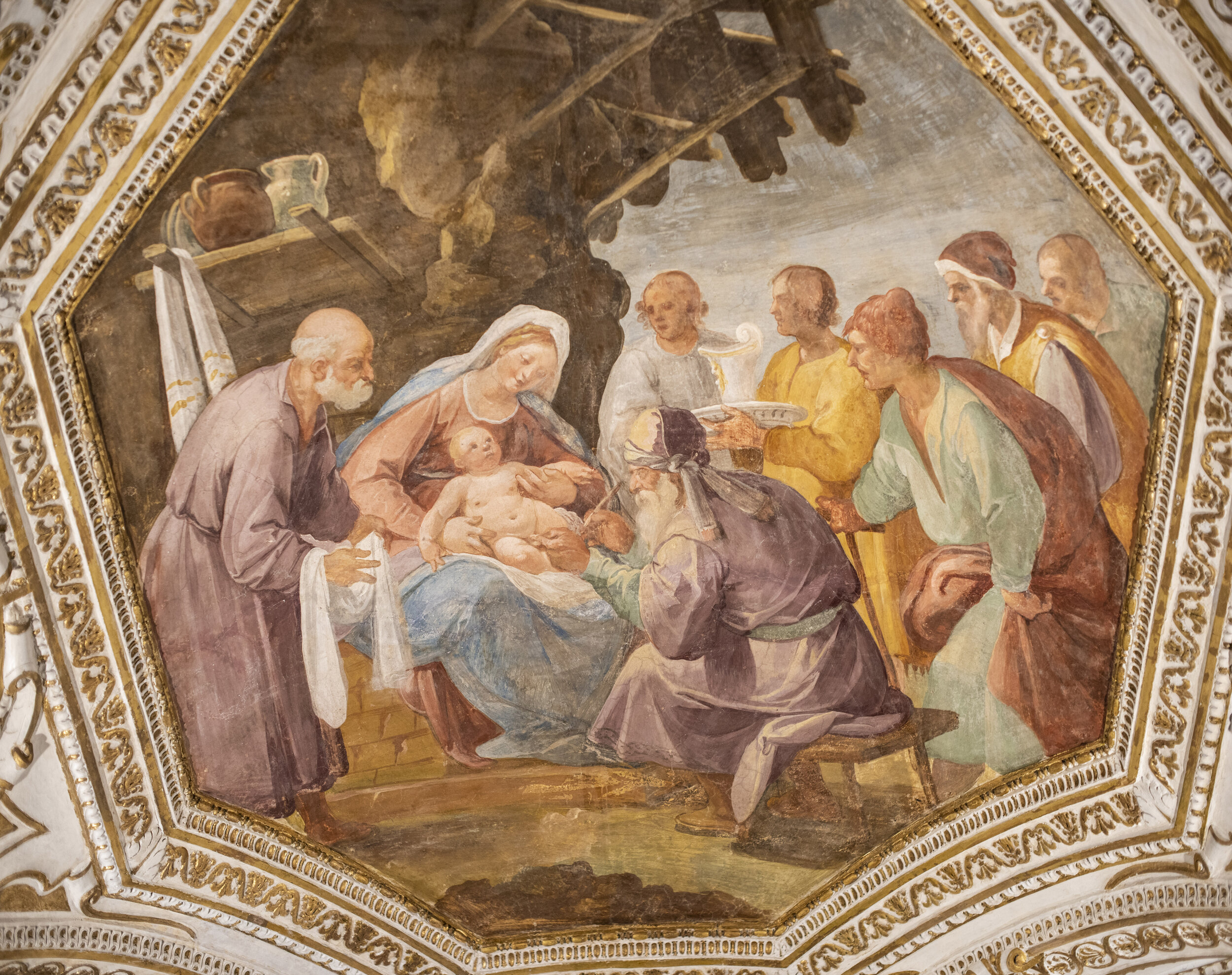
"The Circumcision of Christ," by Belisario Corenzio and based on Luke 2:21, is celebrated on January 1, eight days after birth following Jewish law.

"Flight to Egypt" by Belisario Corenzio. Matthew 2:13-23 recounts an angel appeared to Joseph in a dream telling him to flee to Egypt with Mary and infant Jesus since King Herod would seek to kill him

"Presentation of Jesus in the Temple" (Luke 2:22-40) Mary and Joseph took Jesus to the Temple in Jerusalem 40 days after his birth to complete Mary's ritual purification after childbirth.

"The Finding in the Temple" from the Luke 2:41-52. Jesus at the age of 12 yrs. went with Mary, Joseph on pilgrimage according to Passover custom. He is depicted in discussion with elders.

"Jesus Calls the First Disciples" Matthew 4:18-22. By the Sea of Galilee Jesus seeing two brothers, Simon (Peter) and Andrew, casting a net said, "Follow me, and I will make you fishers of men."

"Jesus Walks on Water" (B. Corenzio). Matthew 14:22-23 - Jesus walking on water saved Peter who had asked to join him but became afraid and sank. Jesus said, "You of little faith, why did you doubt?"

"The Water of Life Discourse" as described in John 4:4-4-26 Jesus tells a Samaritan woman, Photine, that those who drink the water he has to give will never be thirsty and states he is the Messiah.

"Wedding at Canaa" (Belisario Corenzio). John 2:2-22 tells the story of how Jesus turned water into wine at a wedding in Canaa of Galilee when told by his mother that they had run out of wine.

"Calming of the Storm" (B. Corenzio) in Matthew 8:23-27. Jesus rebukes the winds and waves and the lake becomes calm after asking the fearful apostles, "You of little faith, why are you so afraid?"
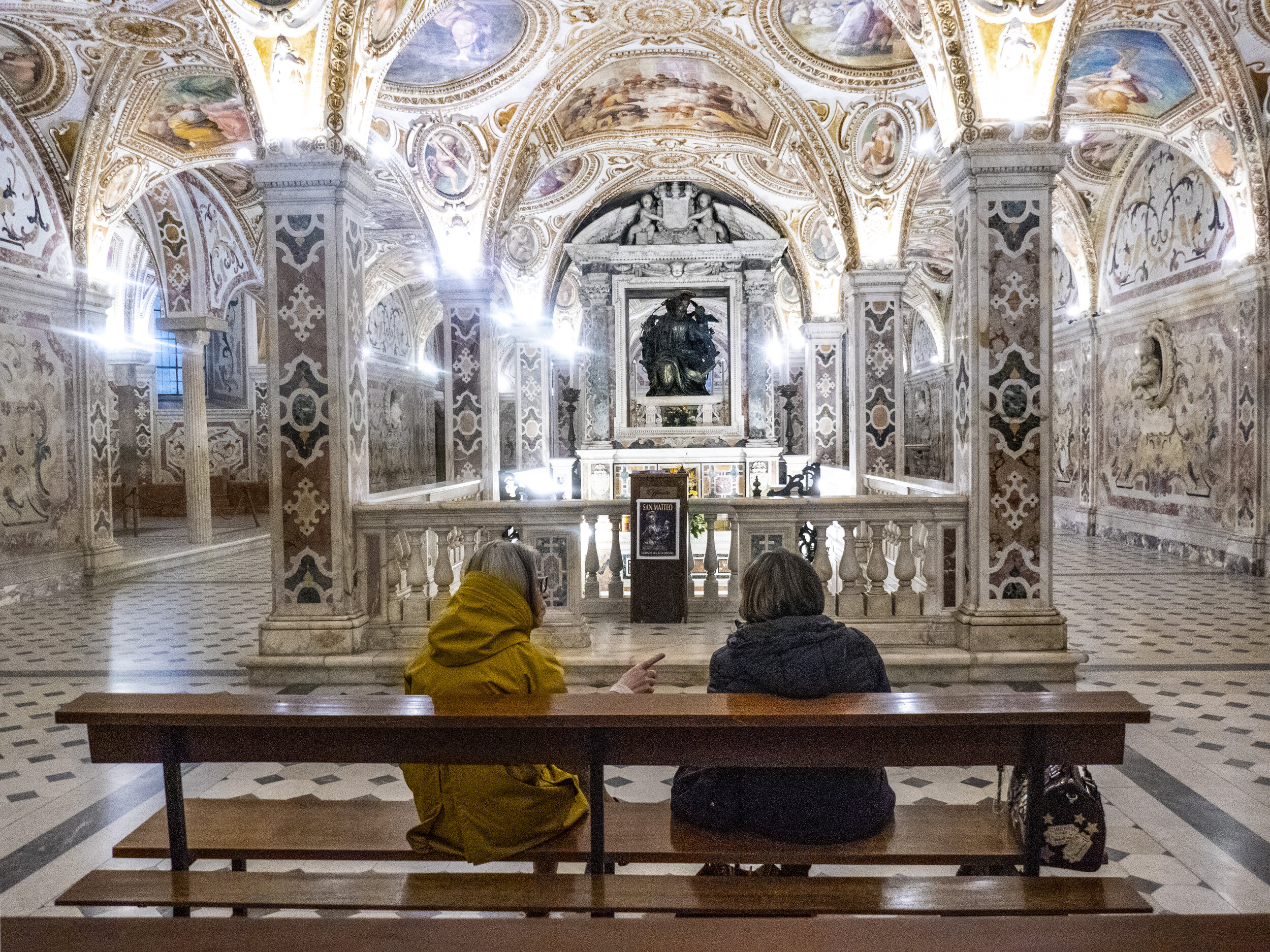
A view of structure of Saint Matthew's crypt with its two aisles and the crypt in the middle, and the vaulted ceiling with the paintings by Belisario Corenzio (1558-1643).

Saint Matthew, the Apostle's remains were buried here in July 1094 in the presence of Alfano I, Emperor Michele and Duke Roberto il Guiscardo. Pope Gregory VII officially consecrated the Basilica.
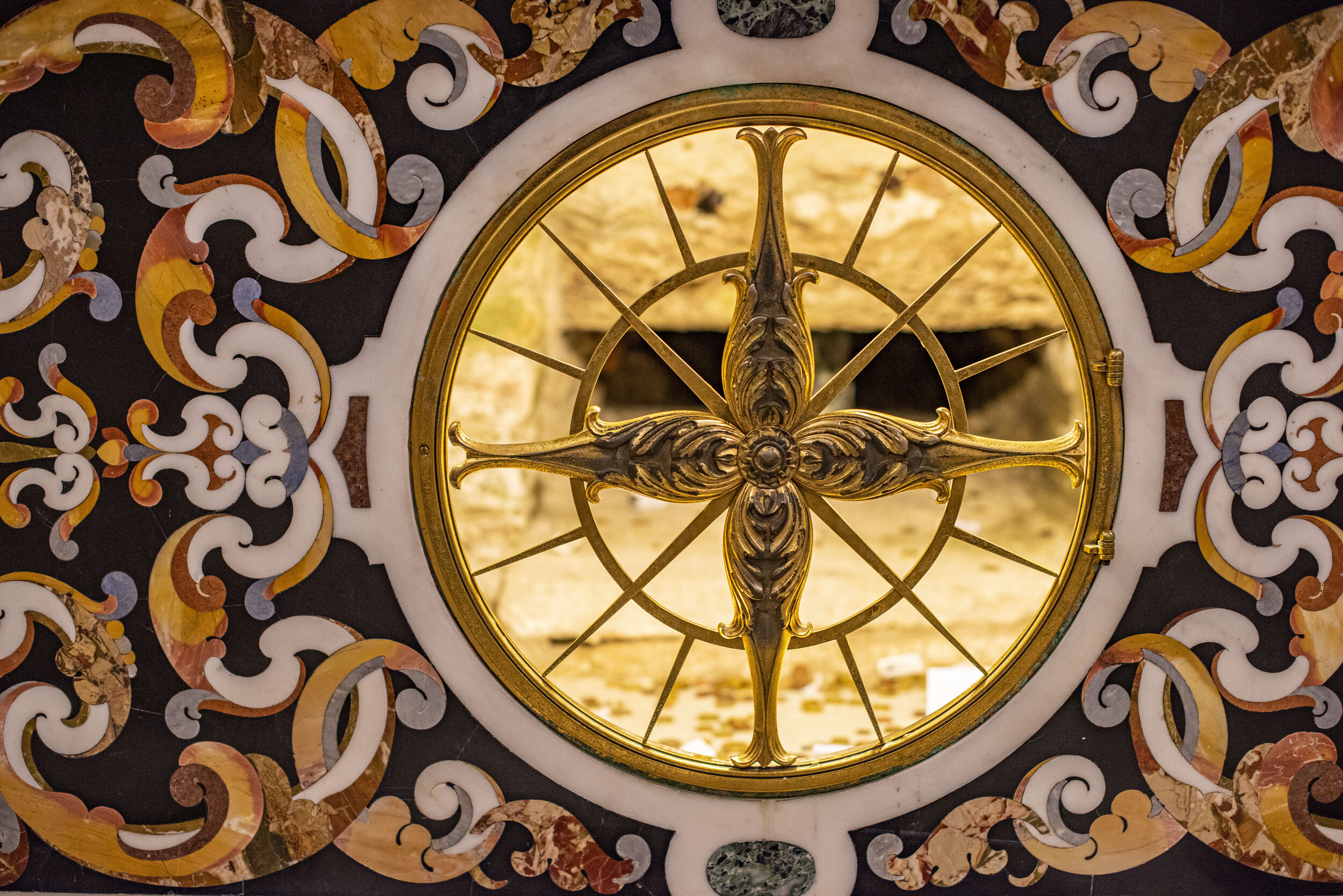
One descends the staircase, walks toward the actual crypt, crouch down and look into the place where Saint Matthew's remains are buried.
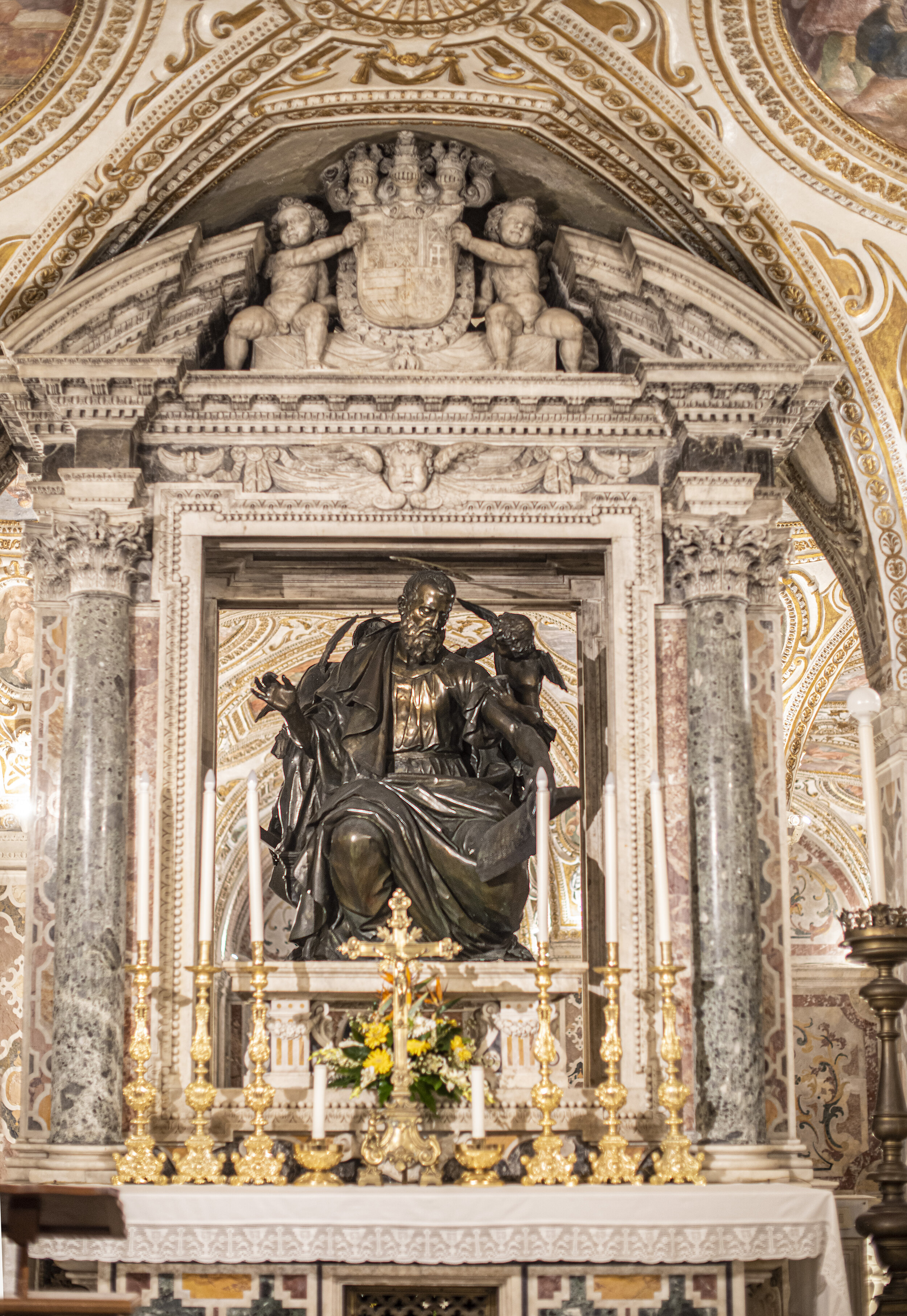
Marble altar of Saint Matthew, the Apostle crypt is decorated on both sides by an elegant canopy and is adorned with two pairs of brass candelabra (one seen on the right) made by Francis Rosso (1673).
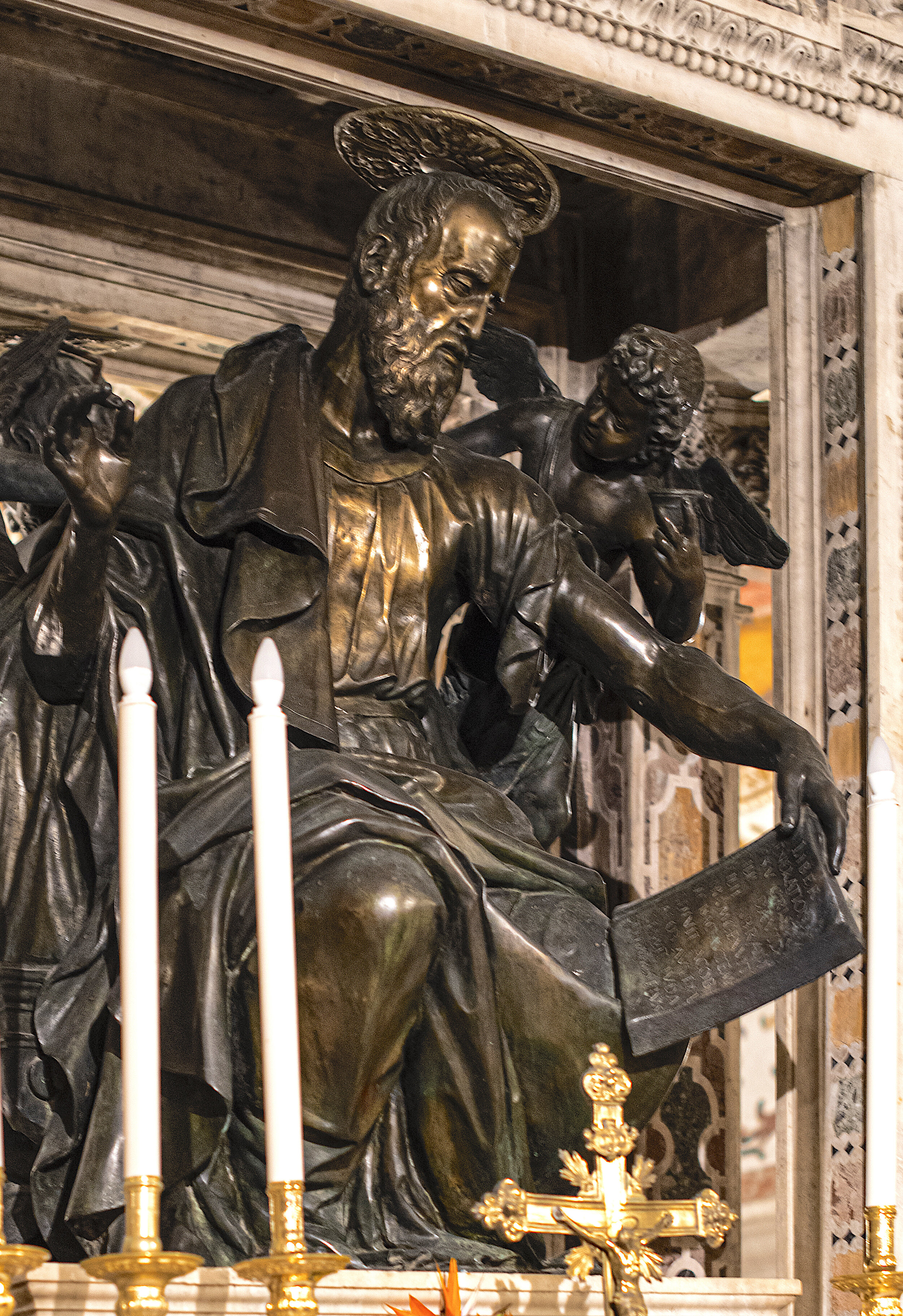
Sitting atop the crypt altar, a bronze statue of Saint Matthew writing his gospel while an angel holds an inkwell for him. It was made in 1606 by Michelangelo Naccherino (3/6/1550-2/1622).

"Healing of the Man Born Blind." John 9:1-12, Jesus spat on the ground and put the mud on the blind man's eyes. He then told him to wash in the Pool of Siloam. The man did so and went home seeing.

"Jesus Healing a Bleeding Woman" (Matthew 9:20-22) While traveling to Jairus' house a woman who had been bleeding for 12 years touched Jesus' cloak. She thought if I touch his clothes, I wii be healed

Raising of Jairus' Daughter by Belisario Corenzio in Matthew 9:18-26. Jesus was told the girl was dead but he went to her anyway saying, "Little girl, I say to you, get up."

"Raising of Lazarus" by Belisario Corenzio told in John 11:1-44. Jesus raises Lazarus of Bethany, the last of the miracles of Jesus before the Passion and his own resurrection.

Saint Matthew preaching in Ethiopia.
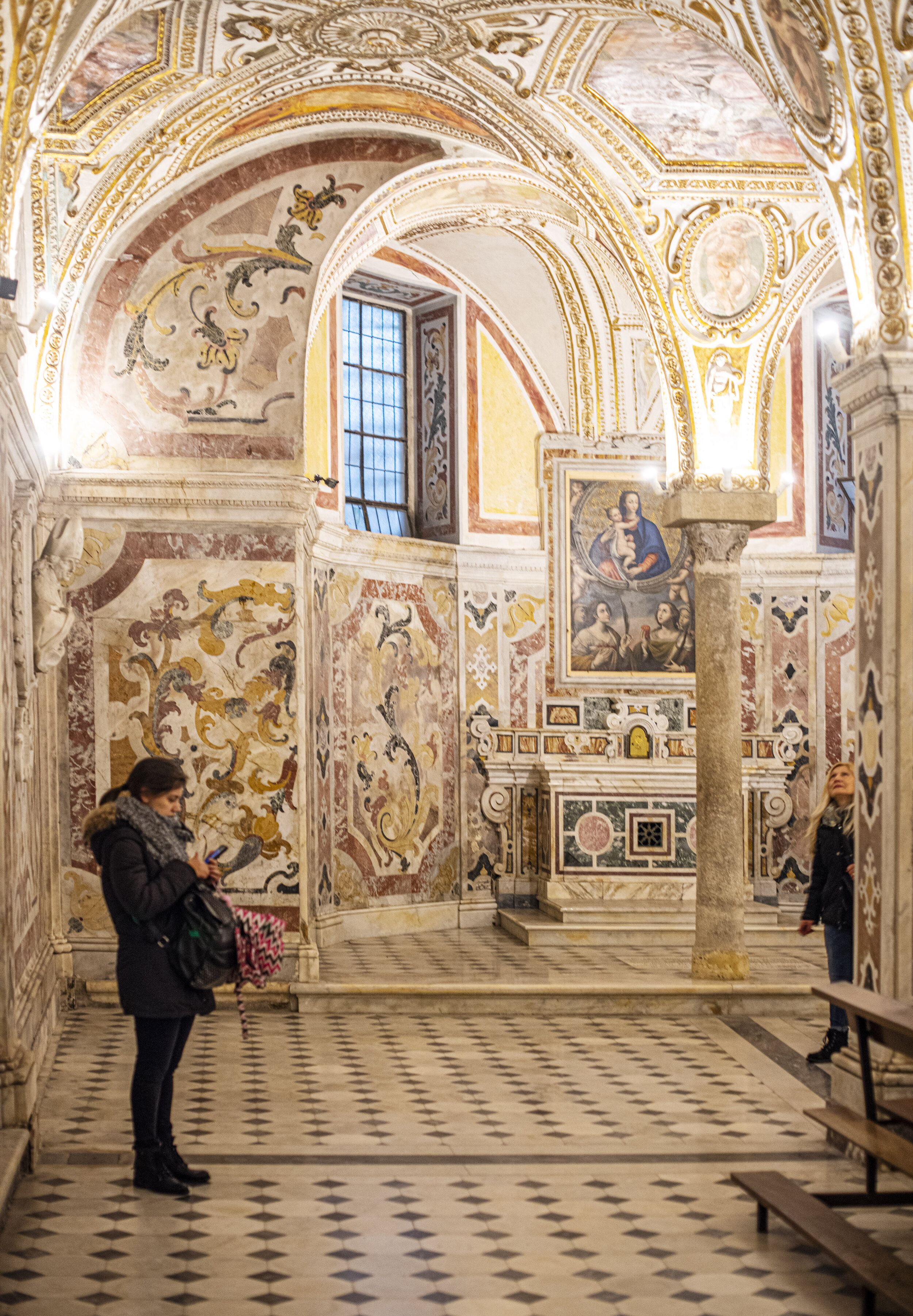
The rear walls and some arches of the northern nave of St. Matthew's crypt are covered with wondrous multi-colored stone-inlay designs.
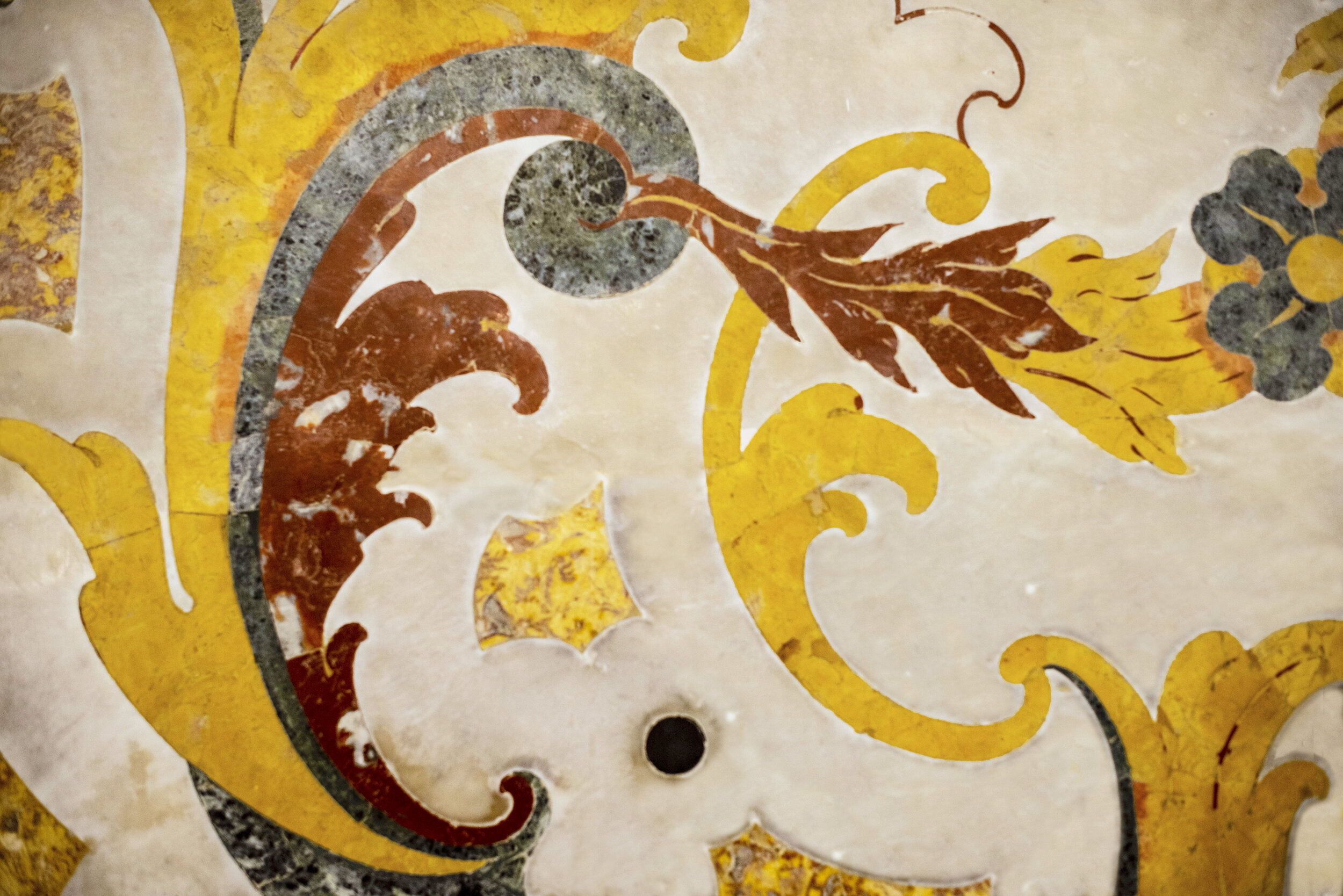
The stone-inlay designs can be referred to as pietra dura, the term for the inlay technique of using cut and fitted, highly polished colored stones to create images.
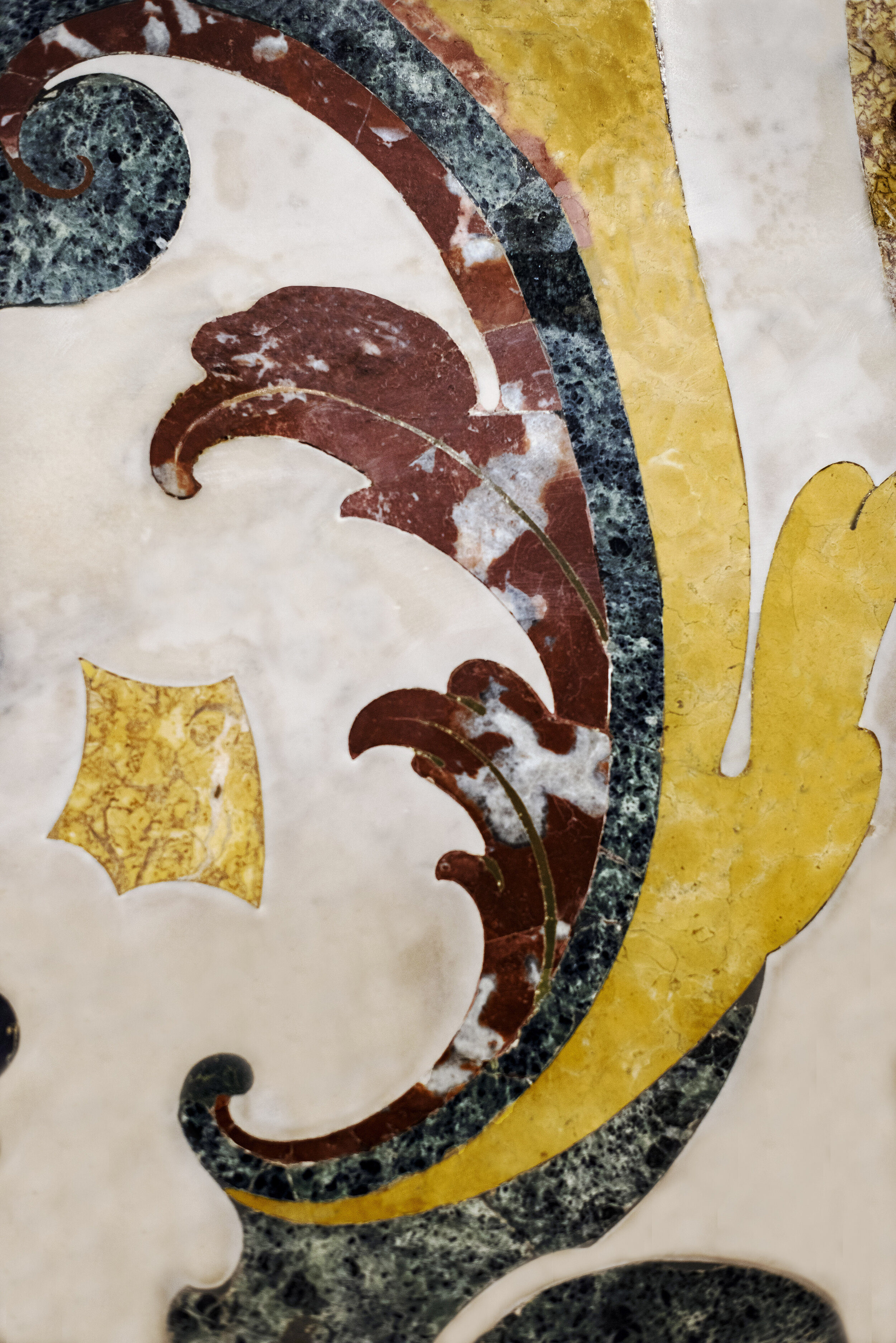
The pietra dura decorative artwork technique employs many different colored stones, particularly marbles, along with semiprecious, and even precious stones.

Pietra dura stonework is glued stone-by-stone to a substrate after having previously been "sliced and cut in different shape sections; and then assembled together.
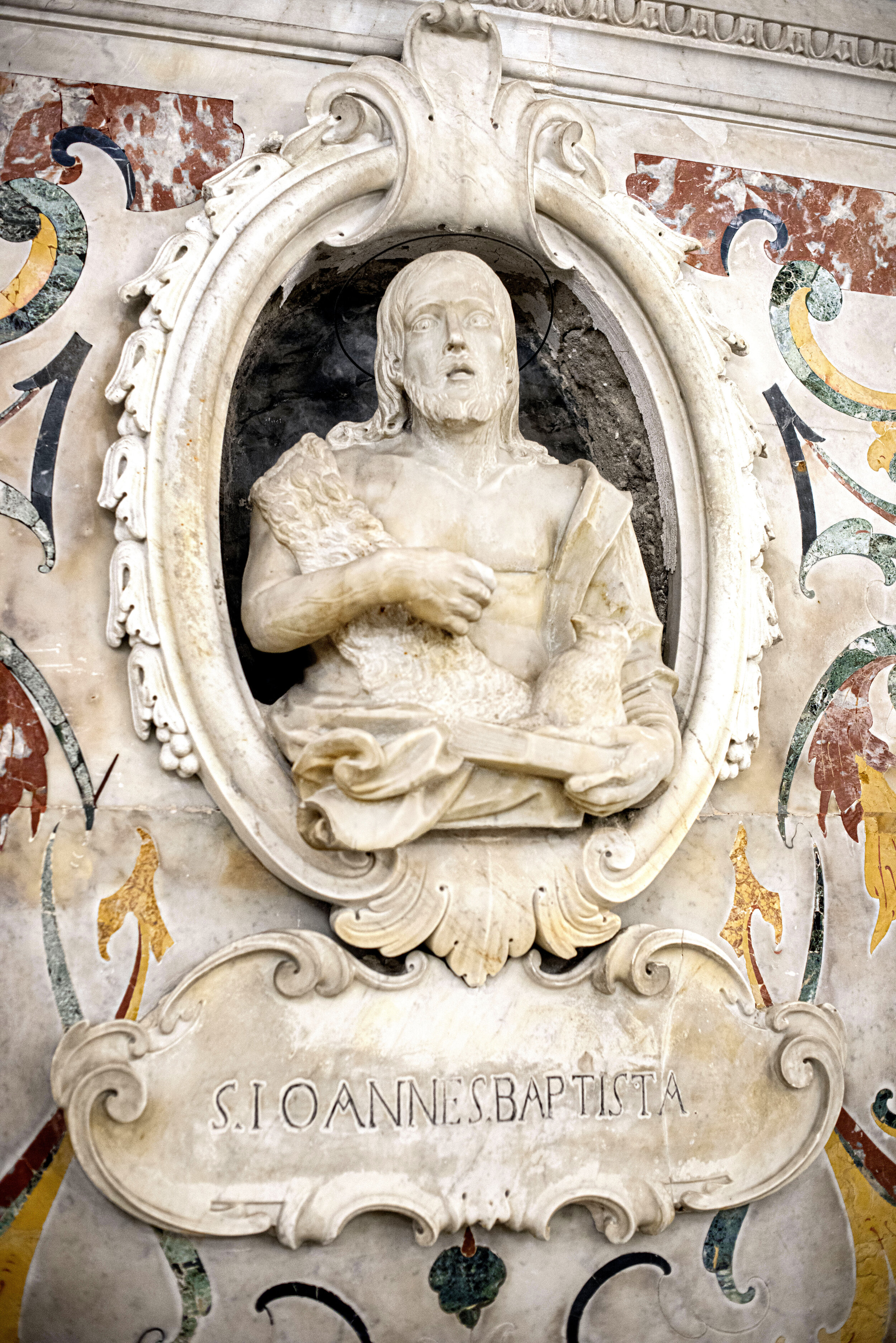
Bas relief of St. John the Baptist surrounded by pietra dura on crypt wall.

Wooden confessional in rear of the Saint Matthew crypt, northern nave.
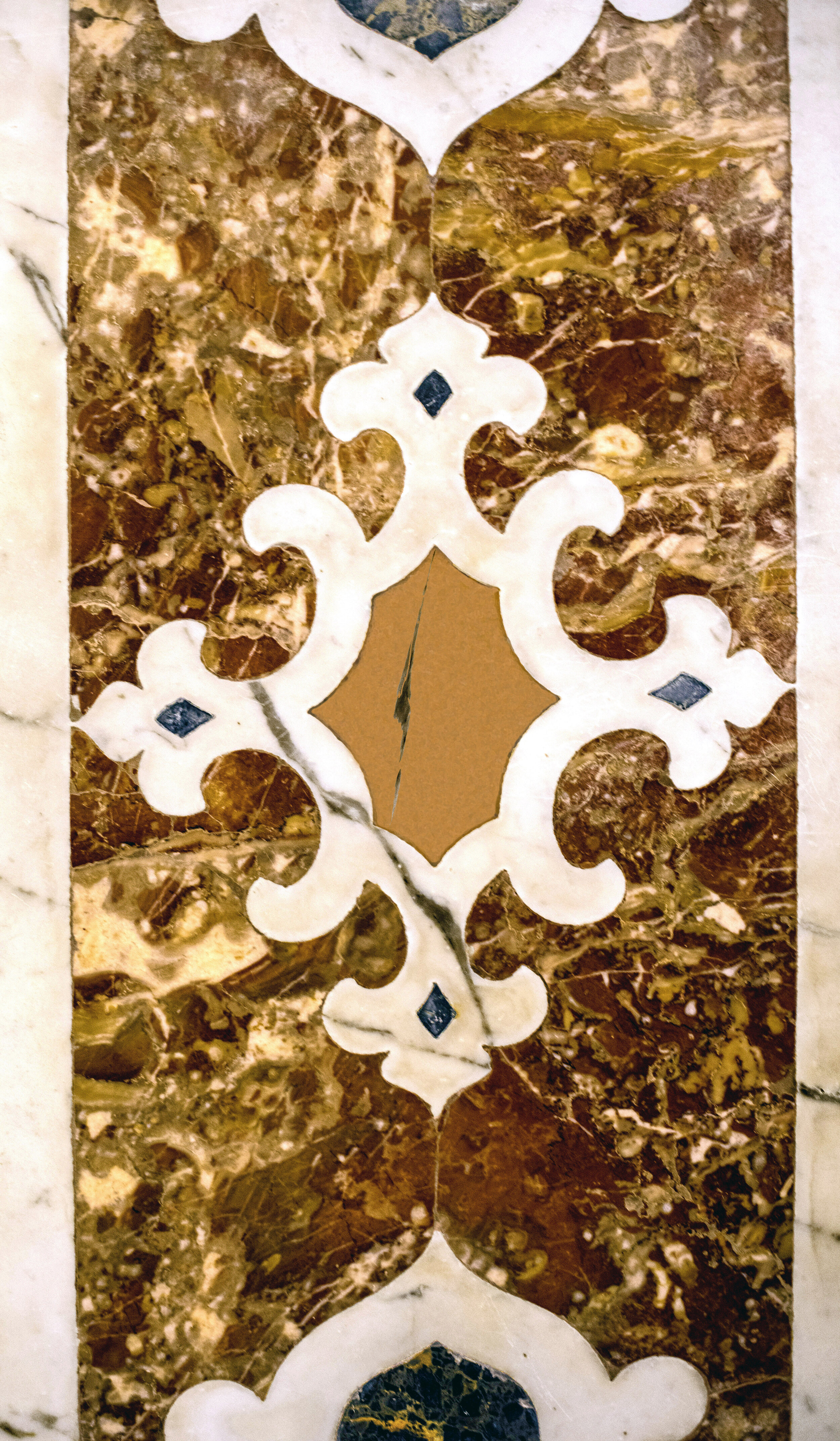
Pietra dura design on northern nave wall of the Saint Matthew crypt.
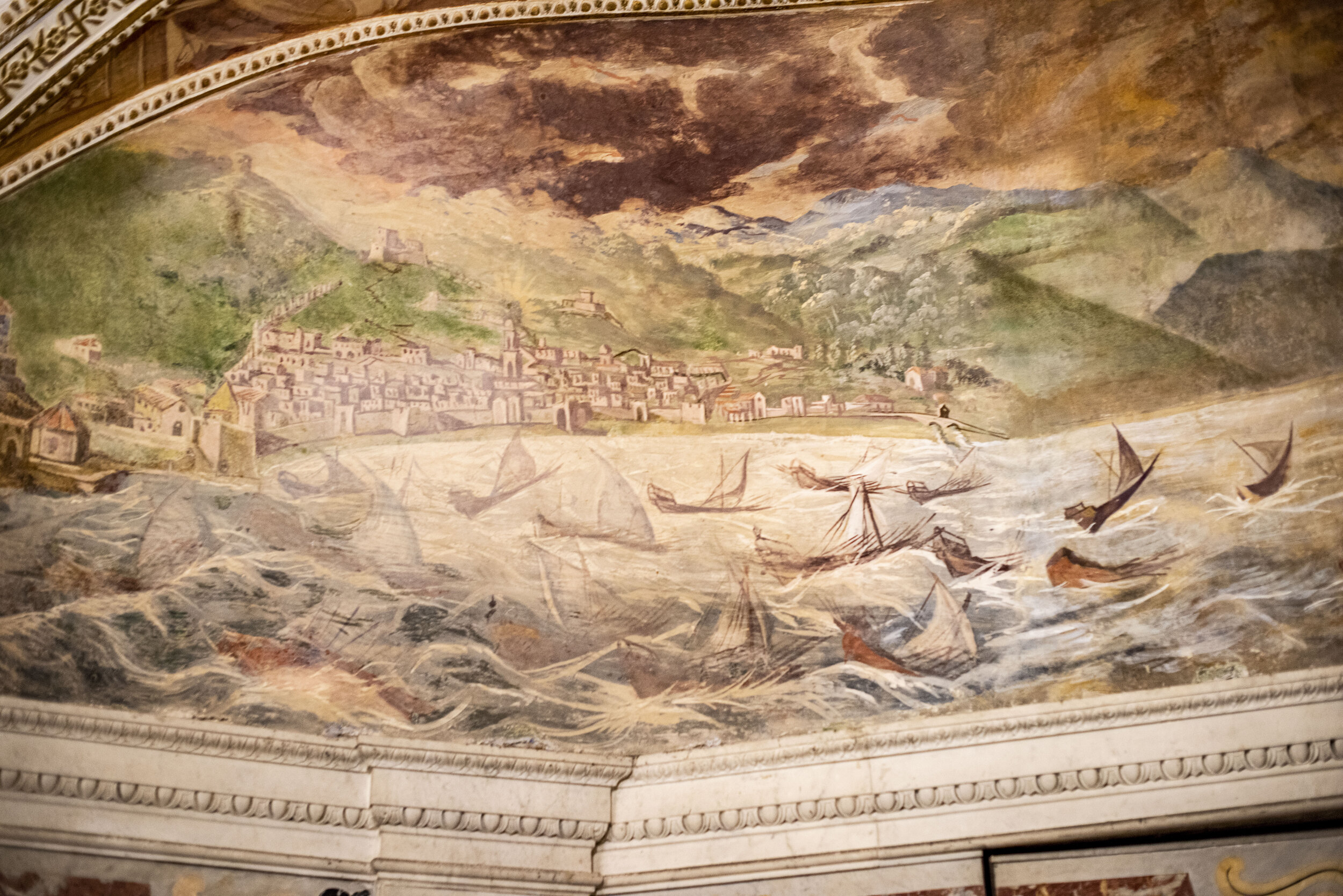
Medieval map of Salerno on crypt ceiling.
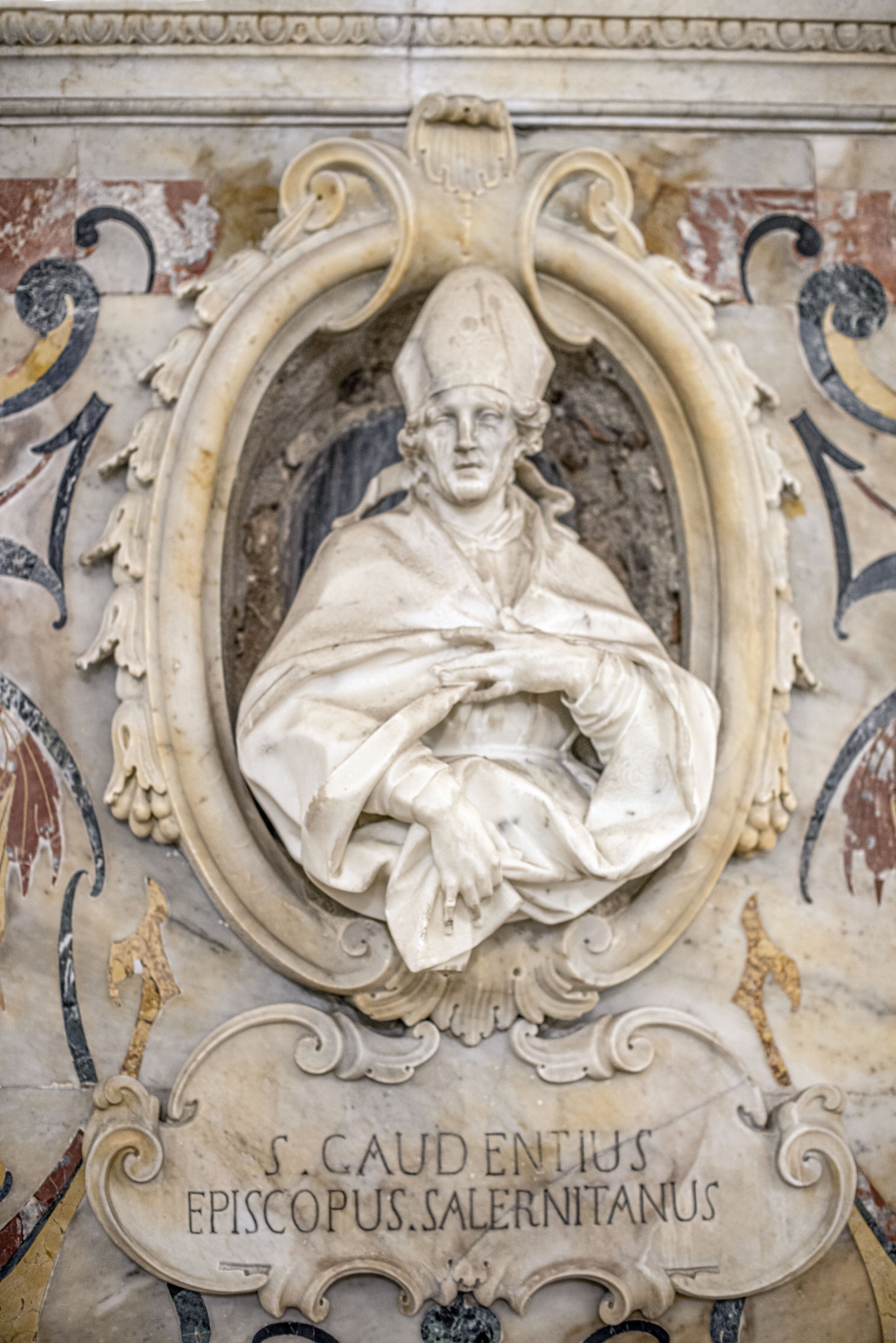
Bas relief on wall of Saint Matthew crypt commemorating Saint Caudiosus, Bishop of Salerno.

An eternal flame in the Saint Matthew crypt states, "PRO F D ET PATRIA," i.e., "On behalf of the faith and their country.".

Sacristy of St. Matthew Cathedral.

Chancel area of St. Matthew Cathedral with priests reading the epistle to the community.
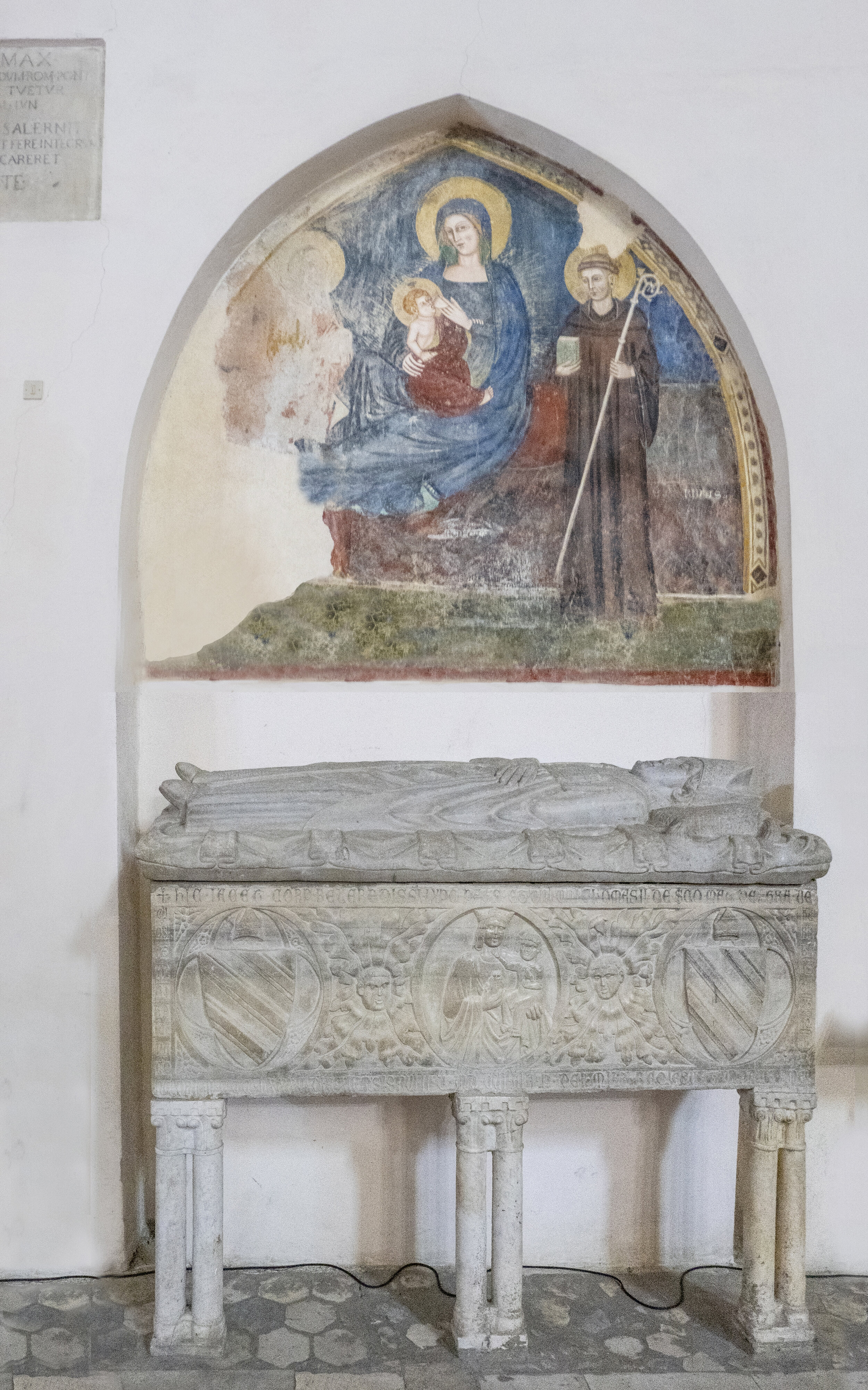
On the southern wall of the transept the tomb of Tommaso Santomango, bishop of Capaccio, who died in 1832. The structure is a simple marble coffin, supported by columns.
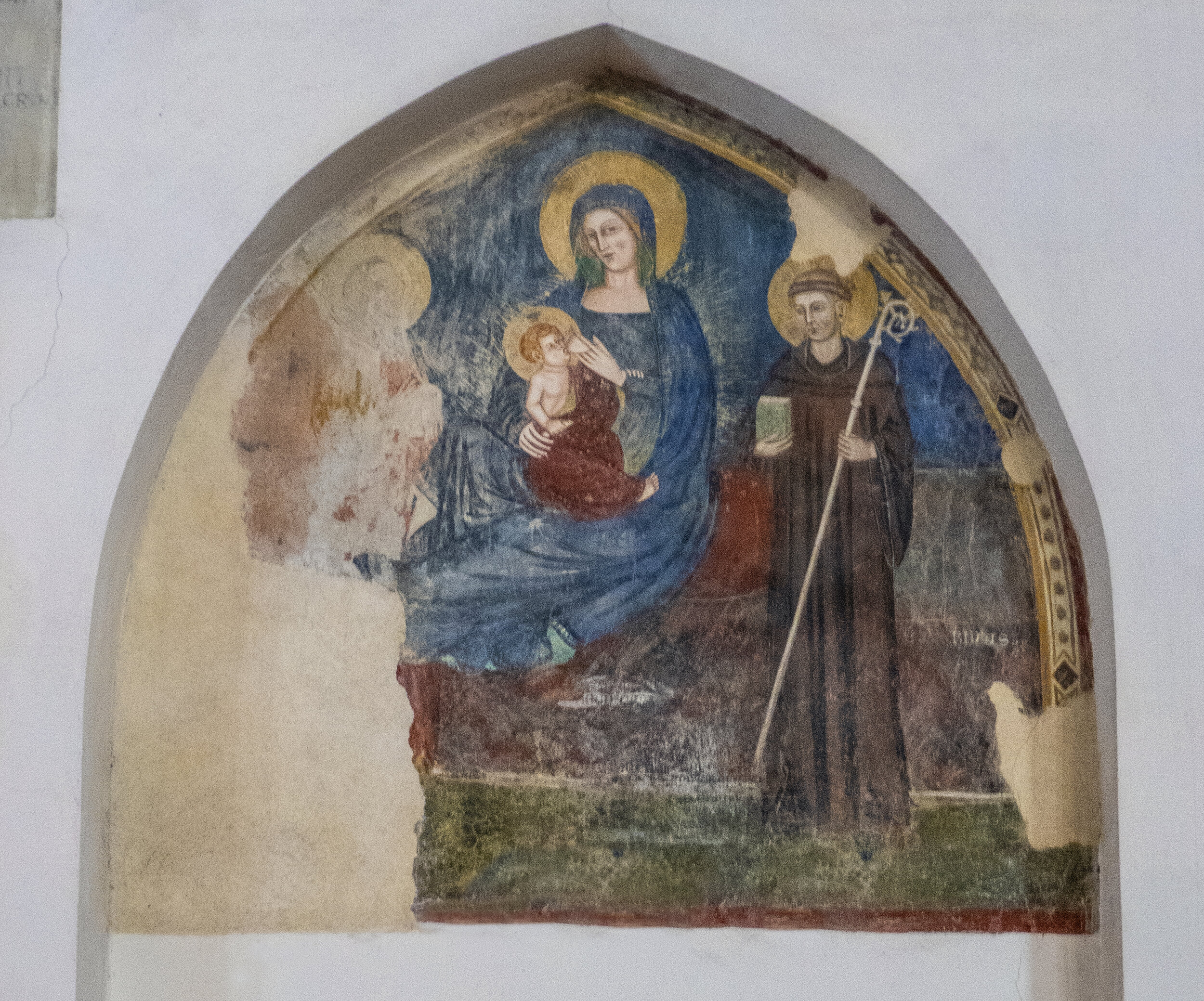
In the Gothic niche above the Santomango sarcophagus, "The Madonna of Humility," called such because the Virgin and Child at the breast is depicted sitting on ground.
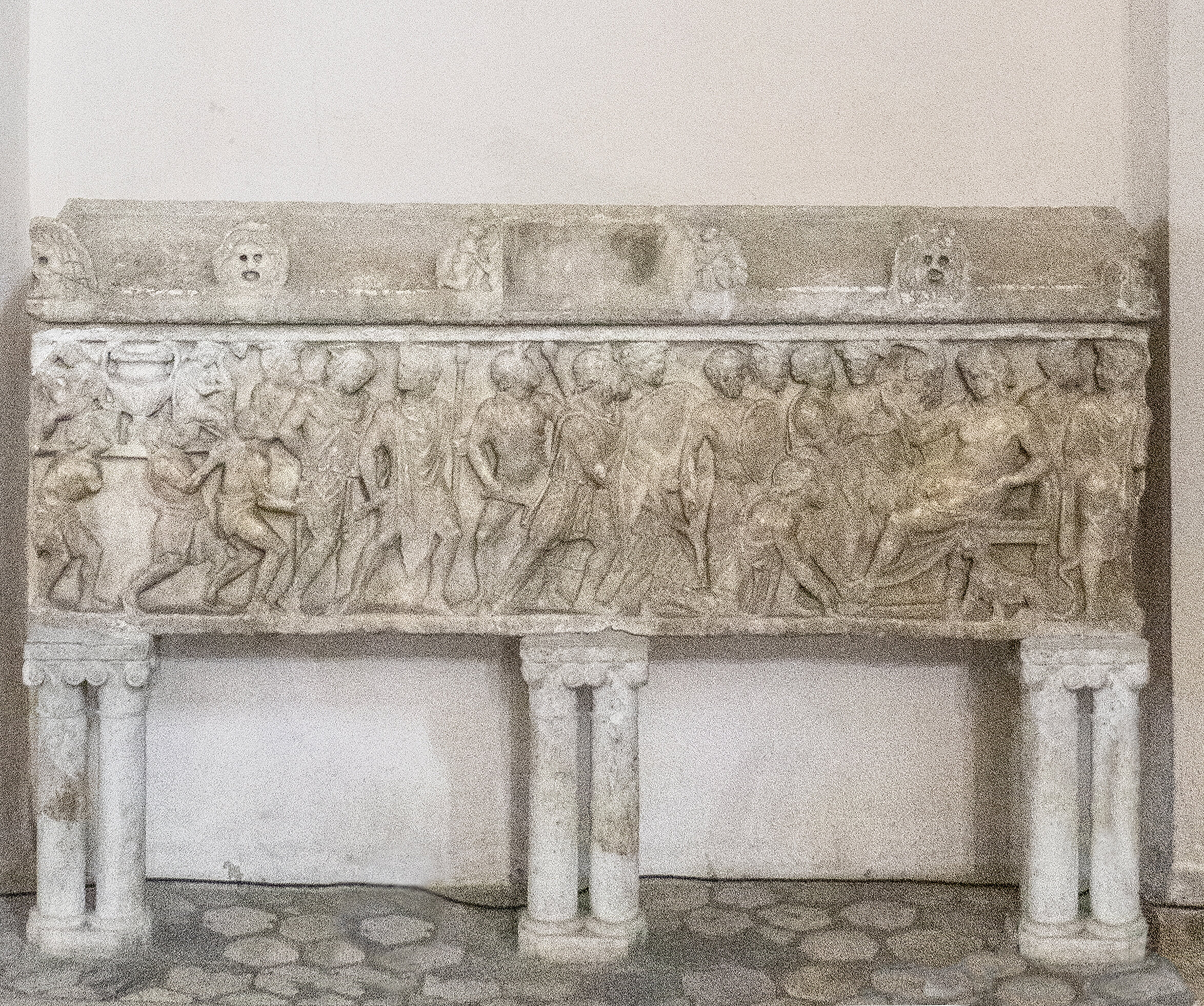
Also, the southern wall - 3rd century Roman sarcophagus with Dionysian scenes, depicting the triumph of Bacchus, and reused a as the 13th c. tomb of Matteo D'Ajello, Vice Chancellor, Norman Kingdom
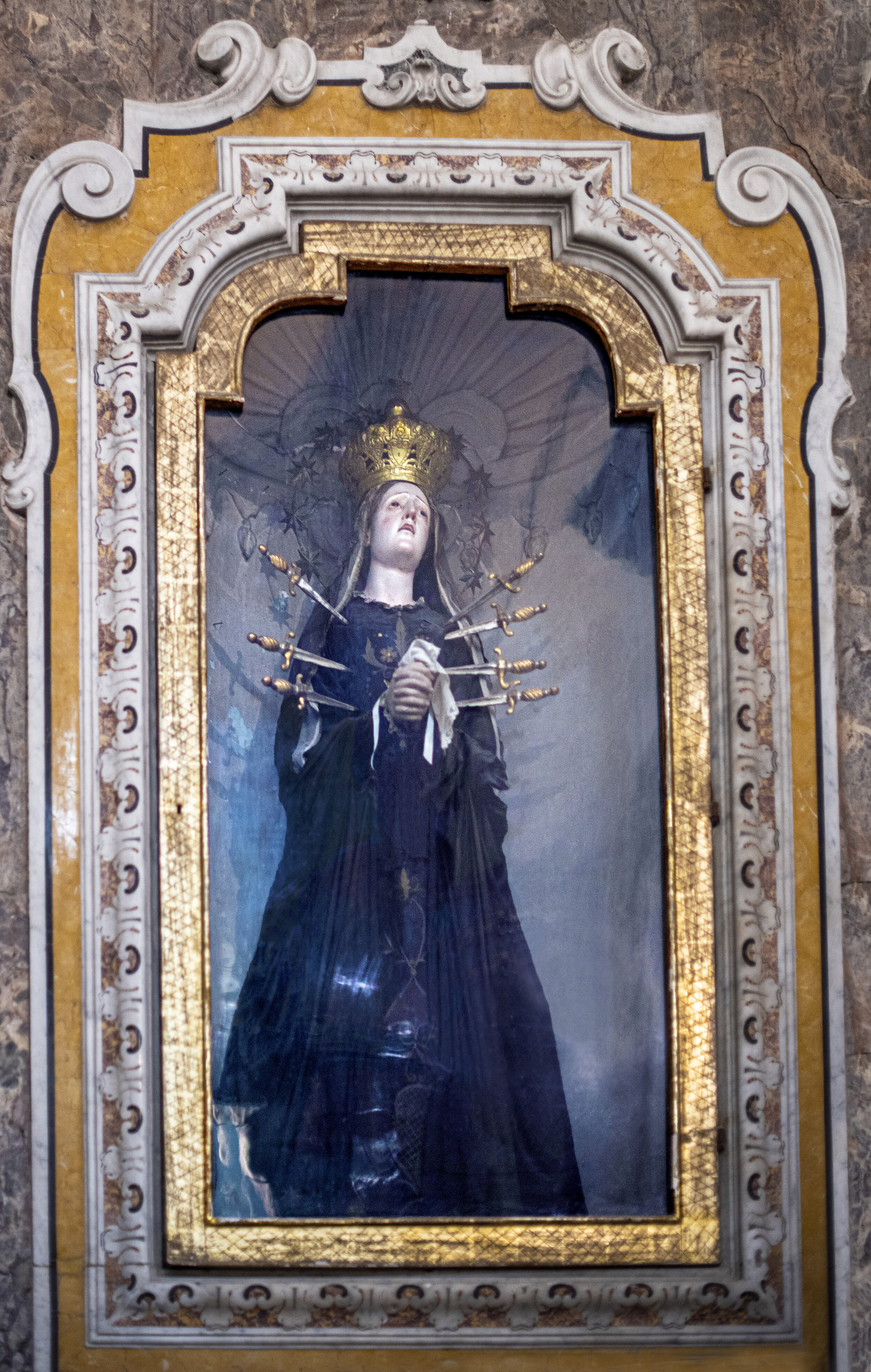
Chapel V (south nave) dedicated to "Our Lady of Sorrows" in 1724. The statue is pierced with seven daggers symbolizing the seven sorrows of Mary, the mother of god, as enumerated in the New Testament.
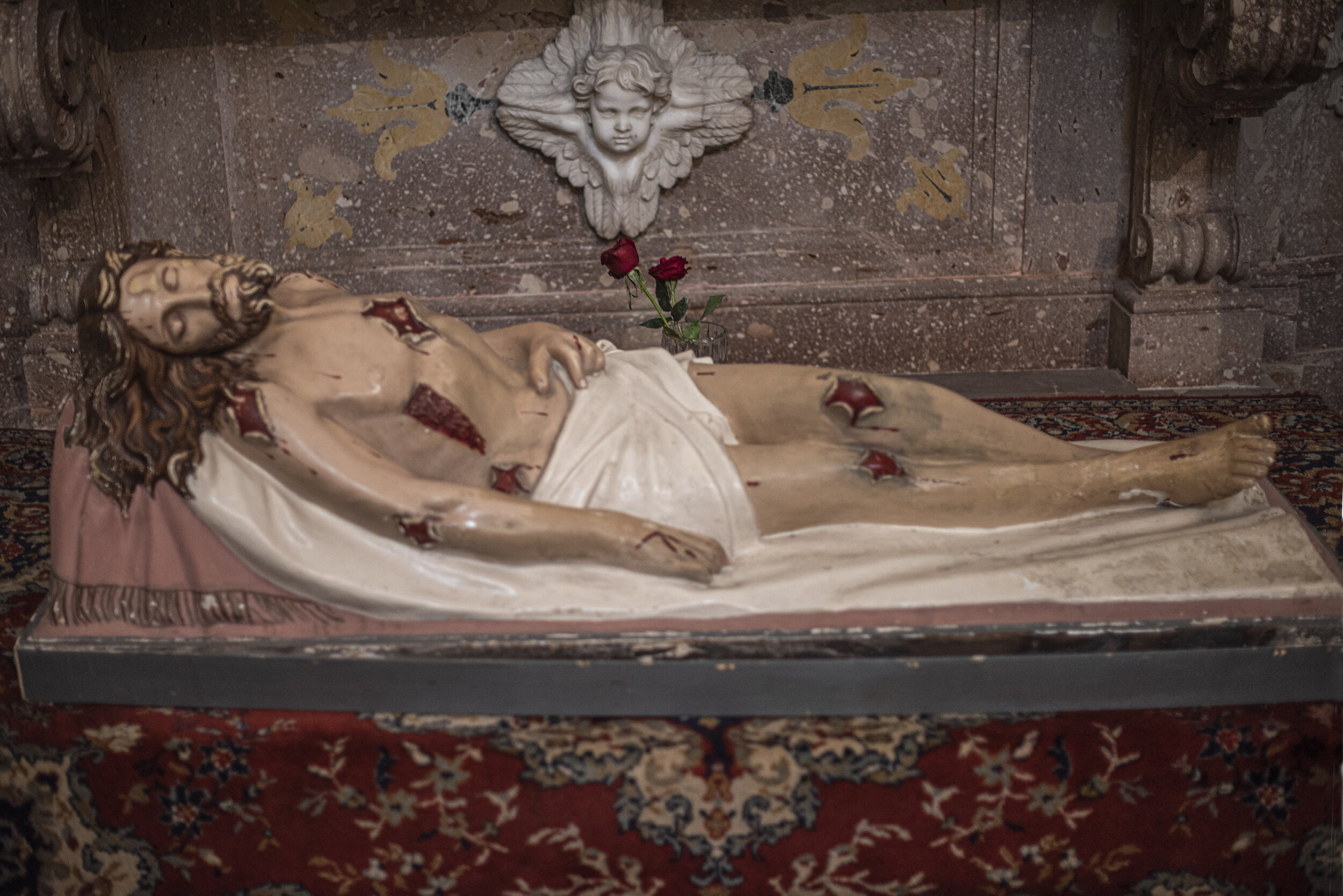
Jesus taken down from the cross (John 19:39-40) is one of the Seven Sorrows of Mary listed in https://udayton.edu/imri/mary/o/our-lady-of-sorrows-title-origins.php.

Our Lady of Sorrows Chapel also contains the half-bust sculptures of the funeral monuments of two of the Del Pezzo family members. Here we see memorialized Pietro Del Pezzo (1733).
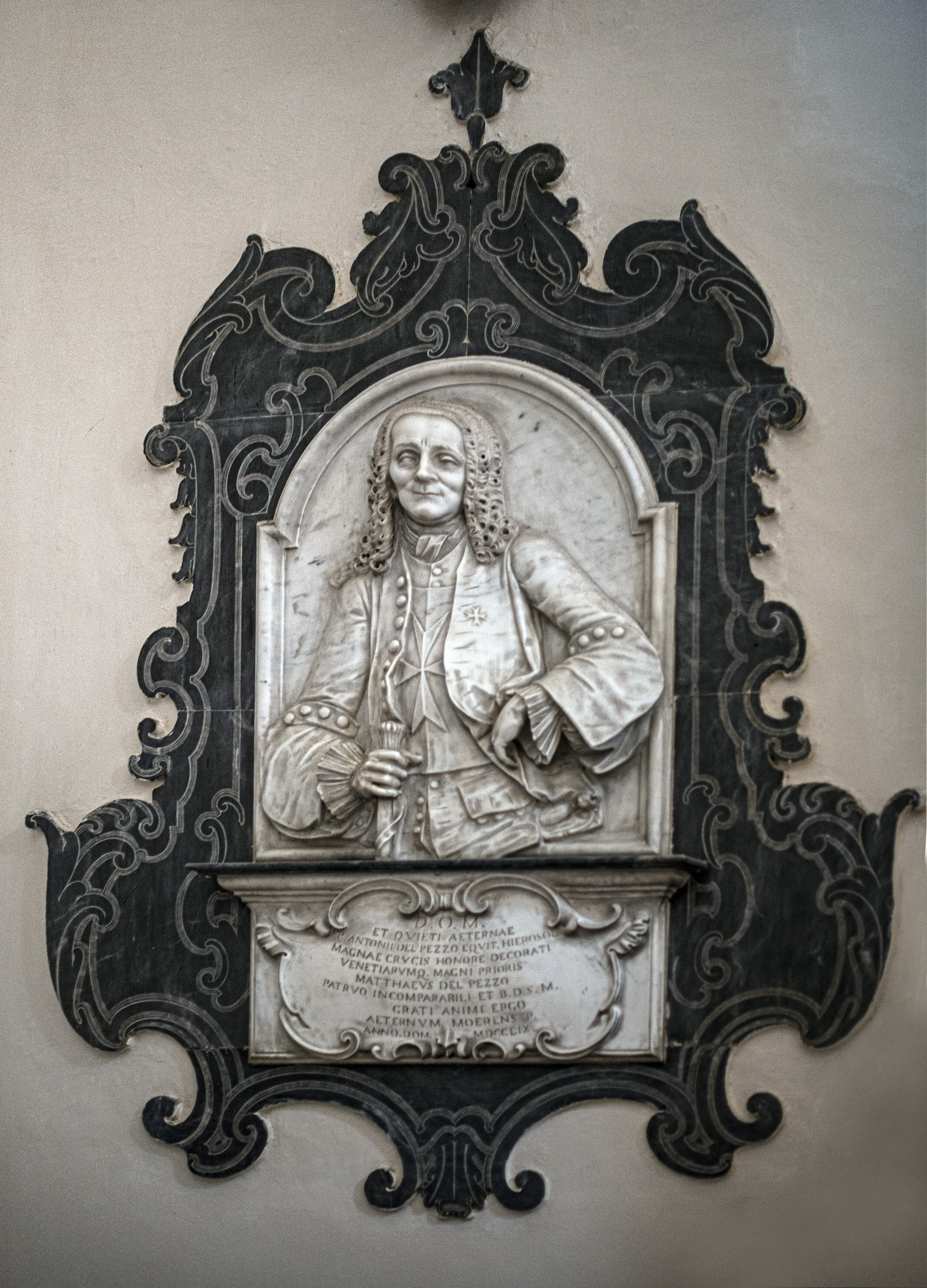
Here we see memorialized Antonio Del Pezzo (1754) in the Our Lady of Sorrows Chapel, one of the two half-bust sculptures shown as funeral monuments of Del Pezzo family members.
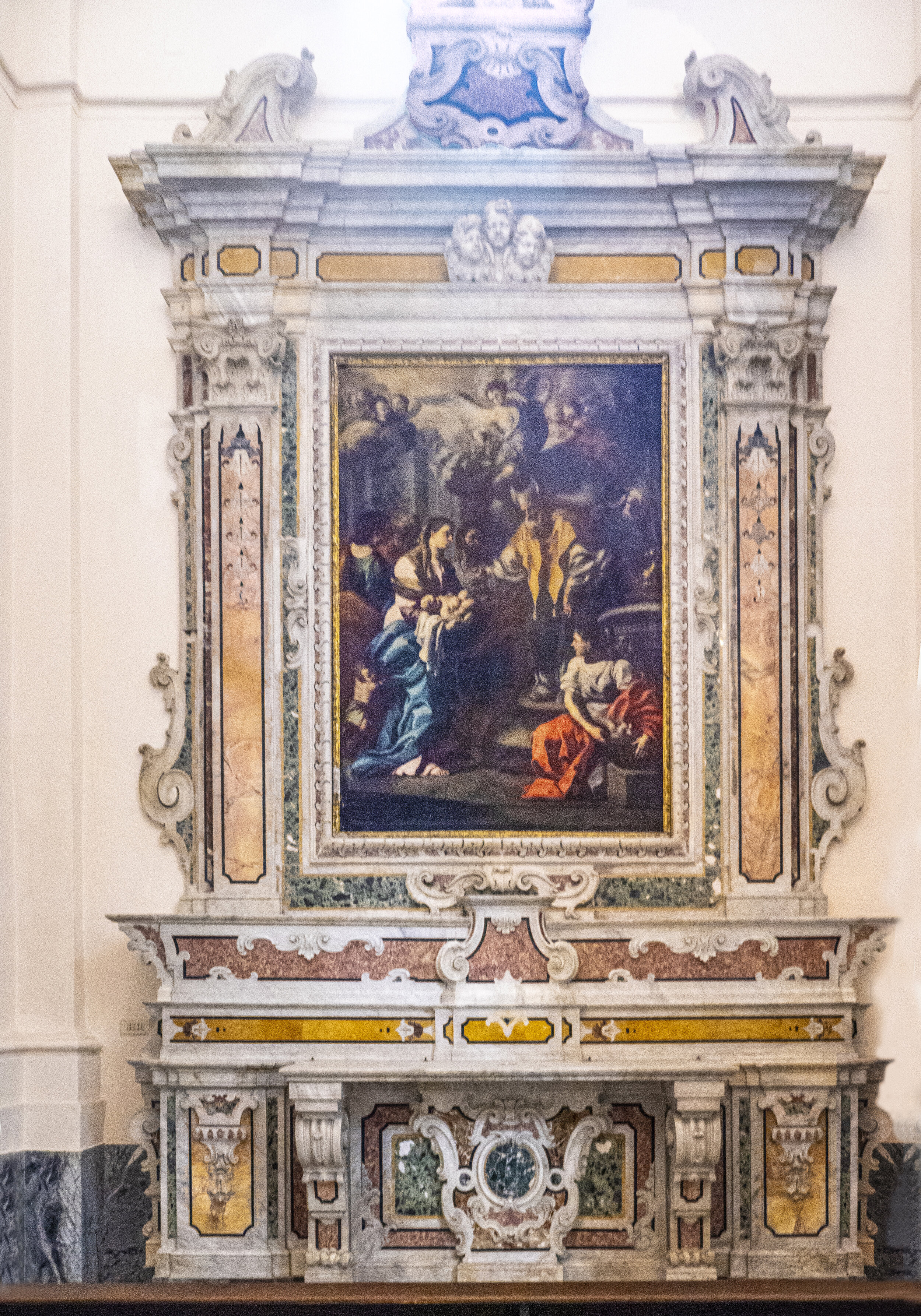
Chapel VI (South nave) - "Chapel of the Purification" (Matteo Chiarelli 18th c.) founded in 1719 by Archbishop Bonaventura Poerio with the noble Andrea Della Calce from Salerno, owner of the altar.
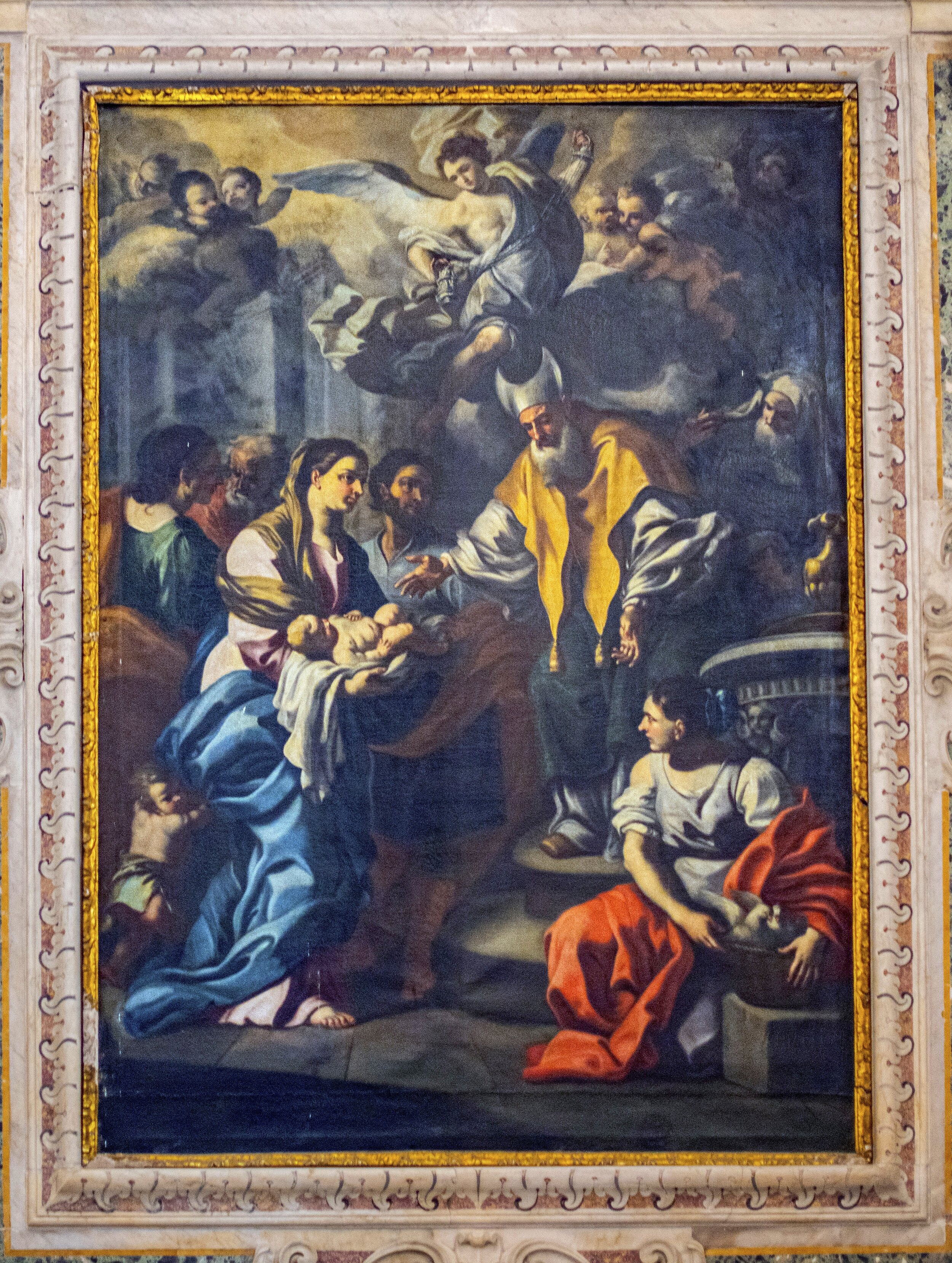
"The Purification of Mary" in the temple of Jerusalem 40 days after Christ's birth in fulfillment of the Mosaic Law requiring the cleansing of a woman from the ritual impurity incurred at childbirth.
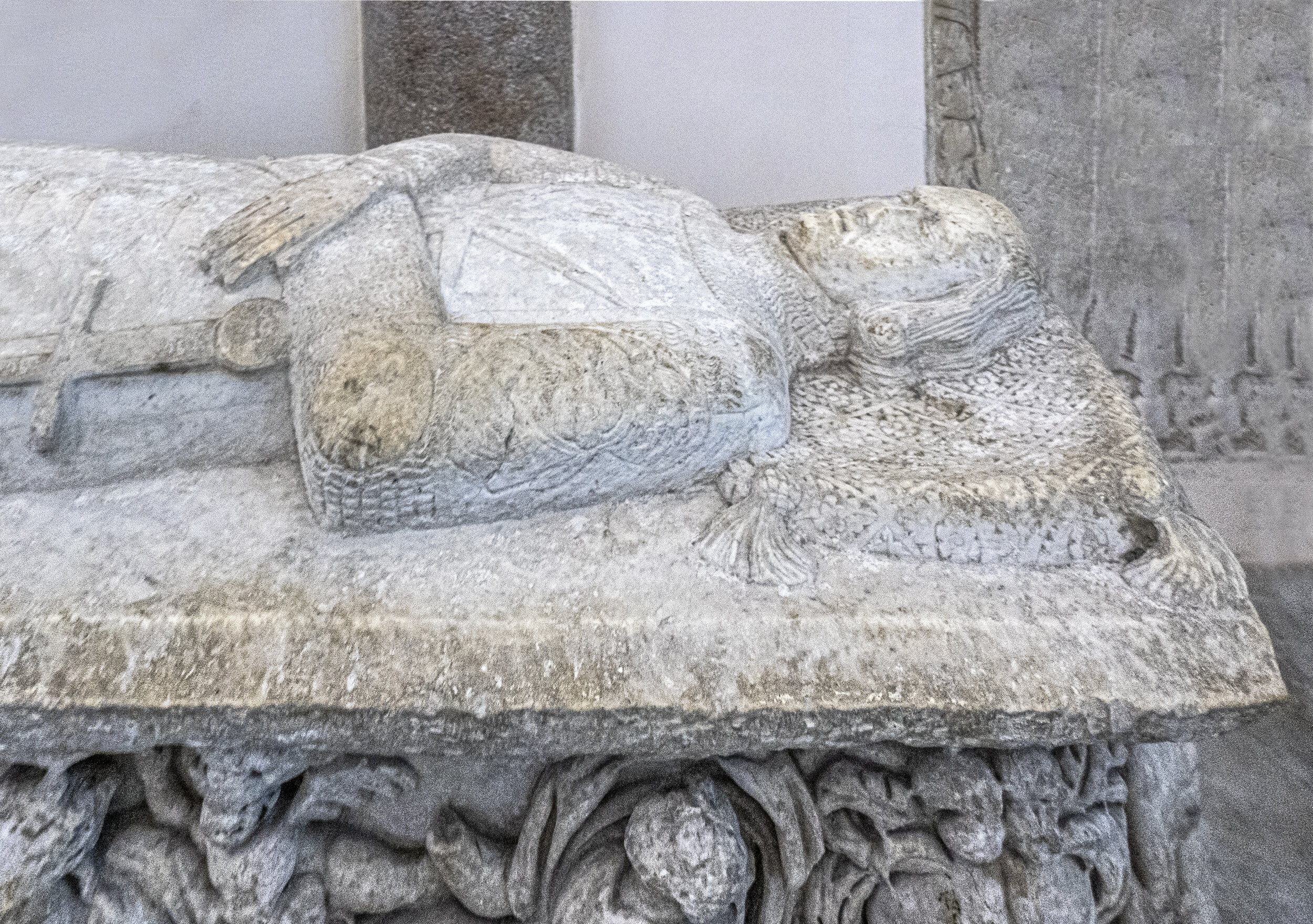
Tomb of "The Angevin Warrior. The lid is early 14th c. The large star design with its eight tips seen on the warrior's bib refers to the noble Stellati family.
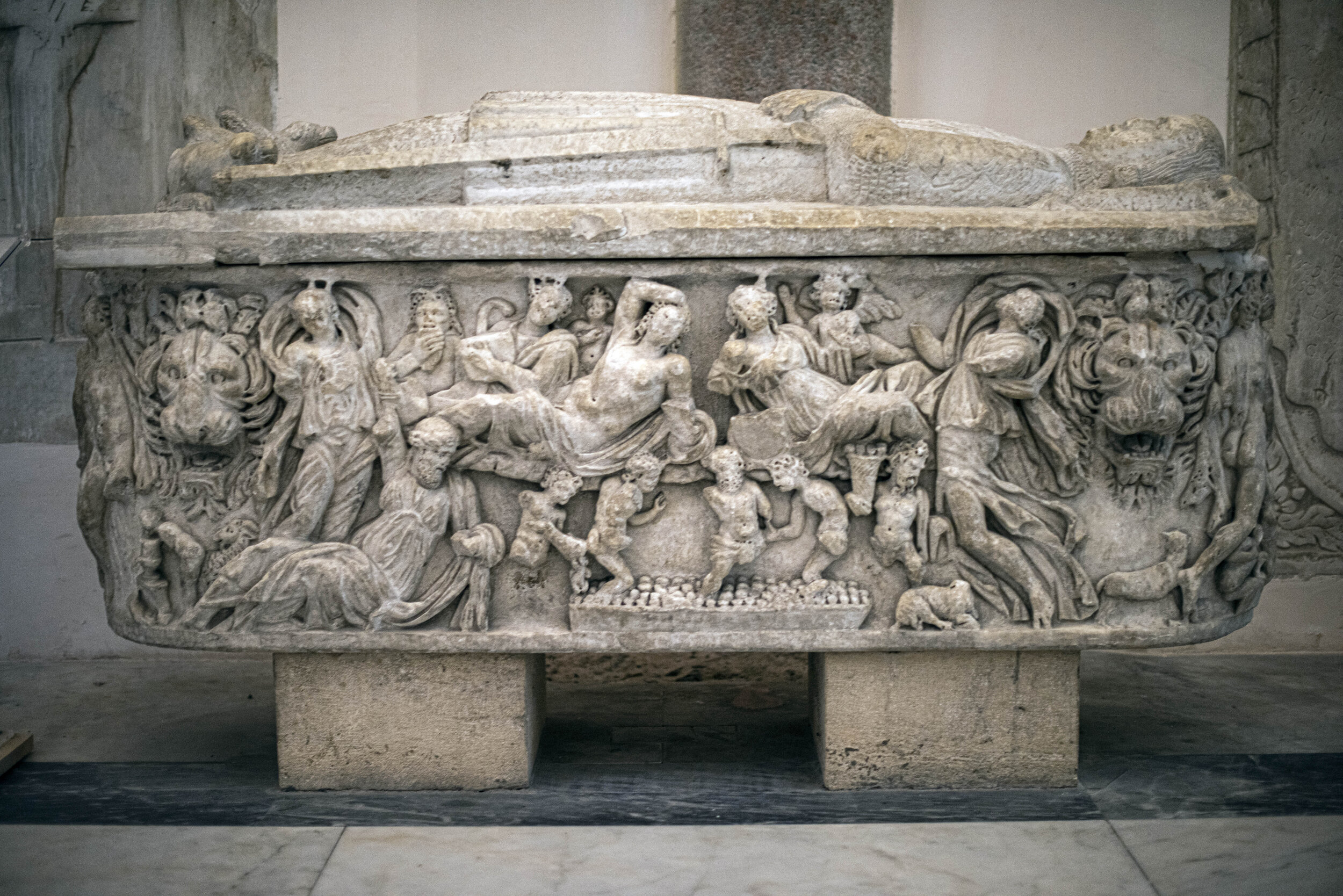
The Angevin Warrior lid sits on a Roman sarcophagus with "Bacchus and Ariadne;" the bottom register has a harvest scene with a satyr pouring the grape clusters, while others dance inside to beat it.
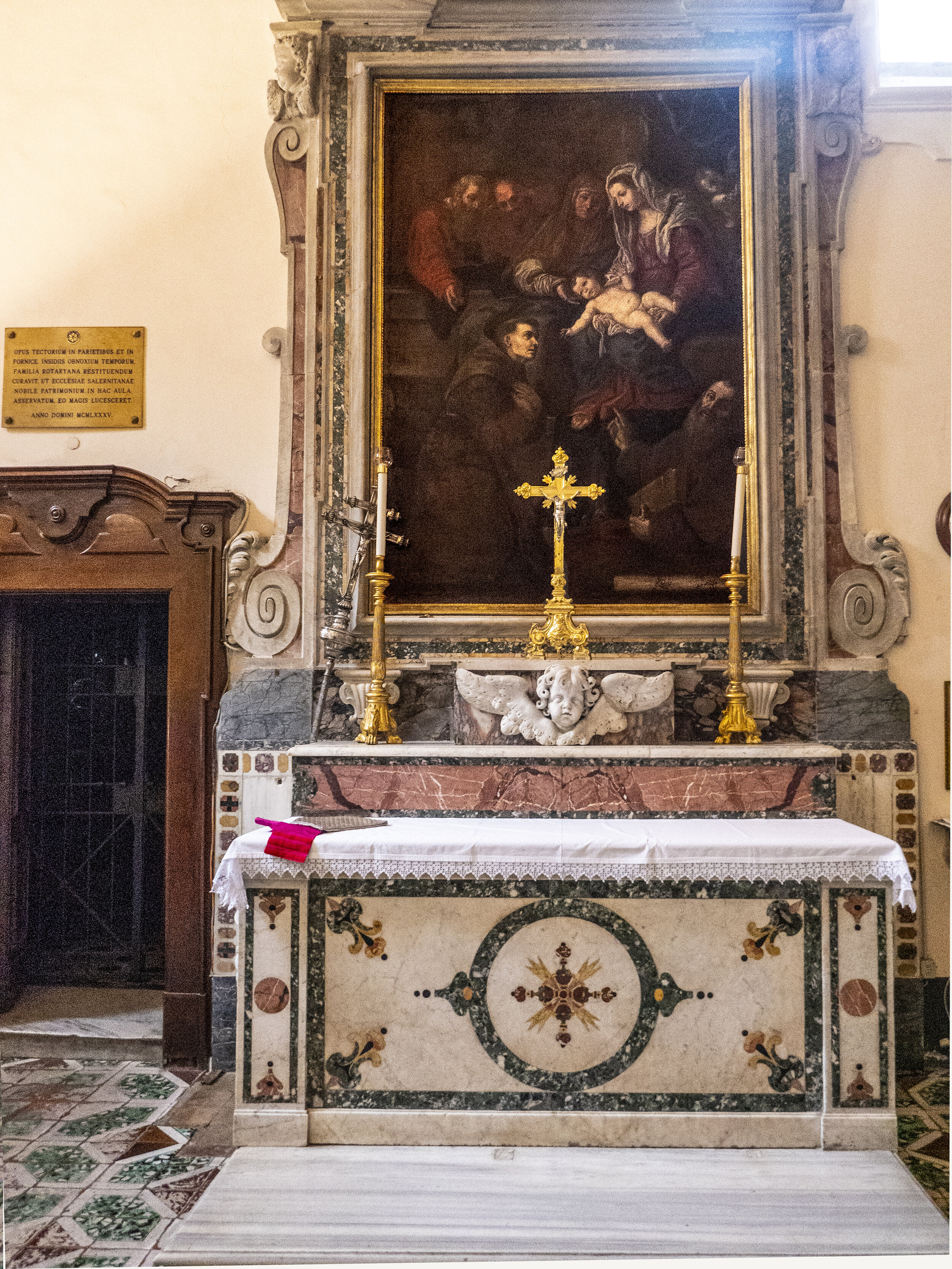
Another representation of the "The Purification of Mary"
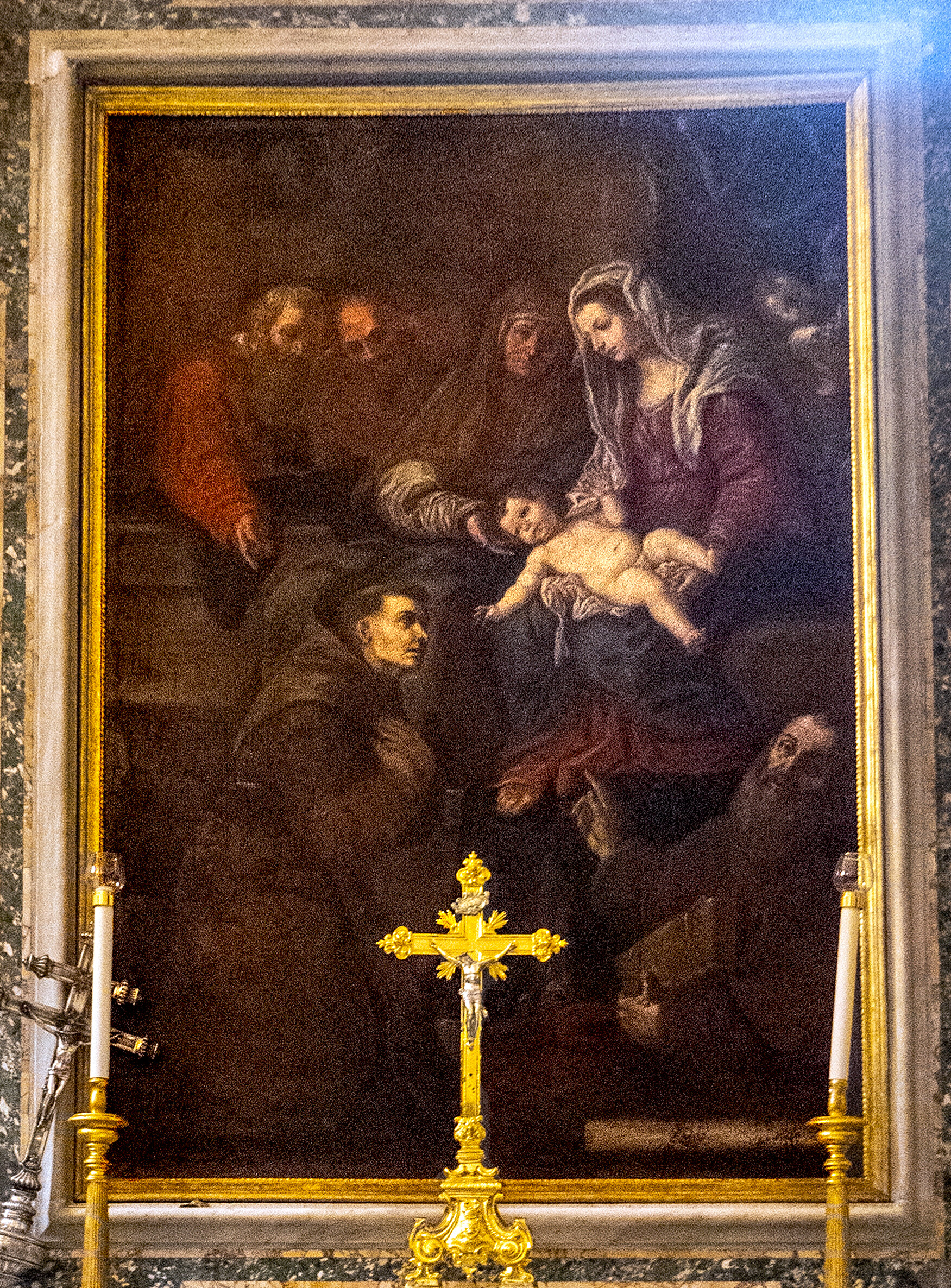
Mary presents Jesus to St. Anthony of Padua (that is my best guess).
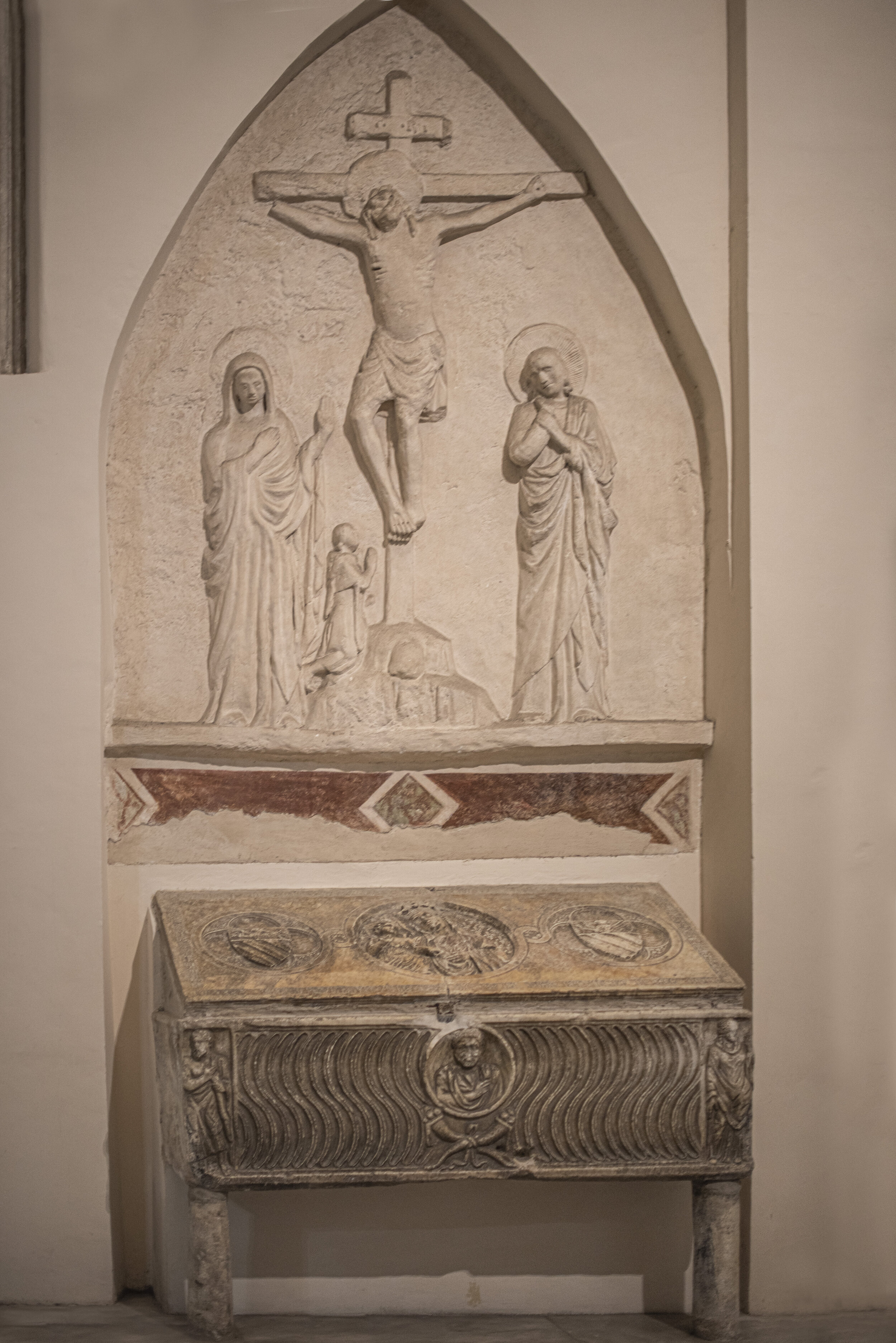
Giacomo Capograsso (d. July 7 1340) entombed in a 3rd-4th c. sarcophagus with male figure on left, female rt. The stucco Crucifixion dates to the late 15th c.
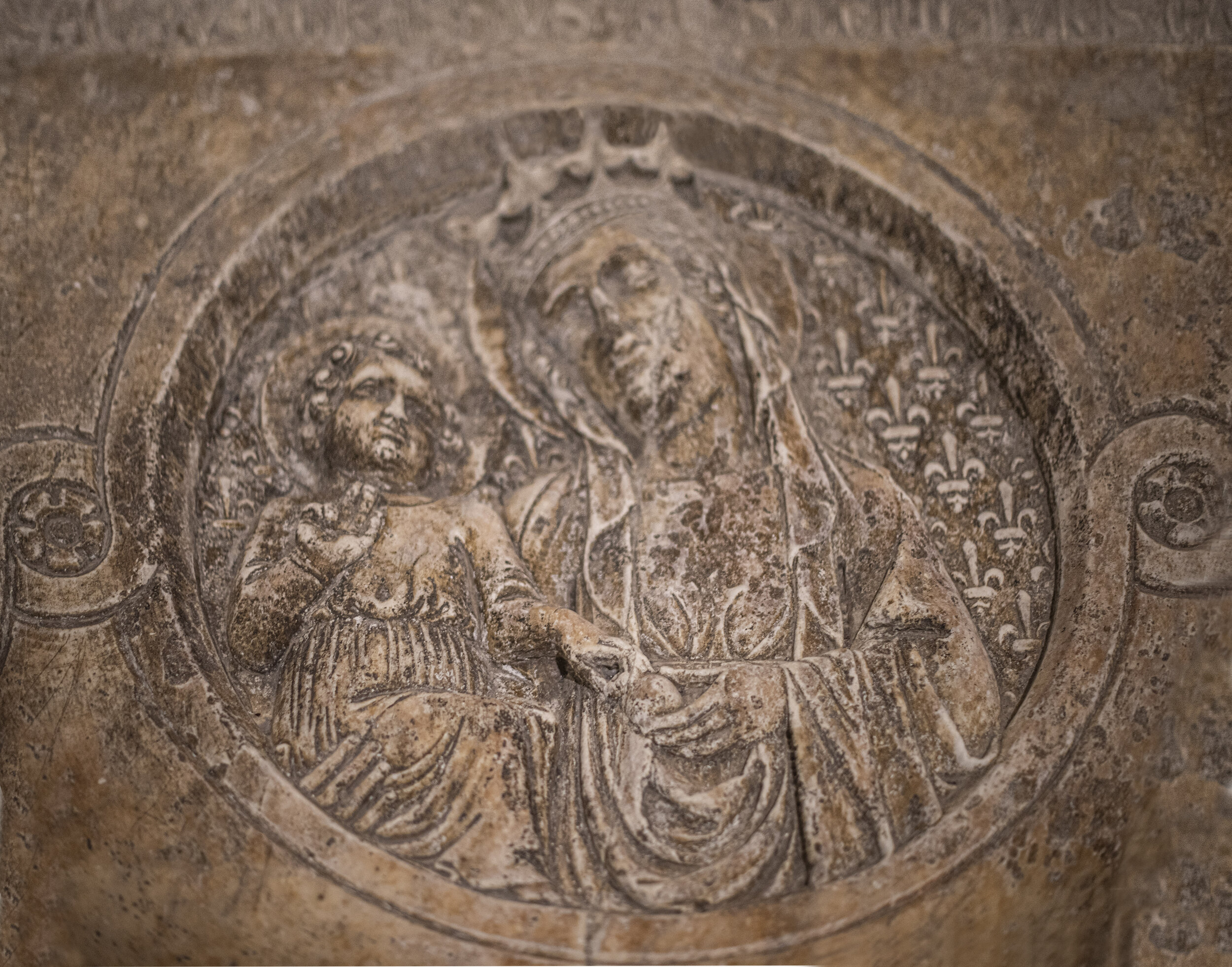
The lid of the Giacomo Capograsso tomb portrays the Madonna and Child, highlighting a strong influence of the school of Tino di Caimaino.

The right apse of the Cathedral, the Southern Minor Apse, is called the "Apse of the Crusades," or the "Apse of Gregory VII."

Southern Minor Apse: Gregory VII sits in the middle with Saints Fortunato and Giovanni on the left and Saints Giacomo and Lorenzo on the right. At the foot of St. Matthew is Giovanni da Procida.

Southern minor Apse (top): Saint Michael th Archangel. The entire mosaic was offered by Giovanni da Procida, a noble of Salerno, very active in the fight against the Angevins.
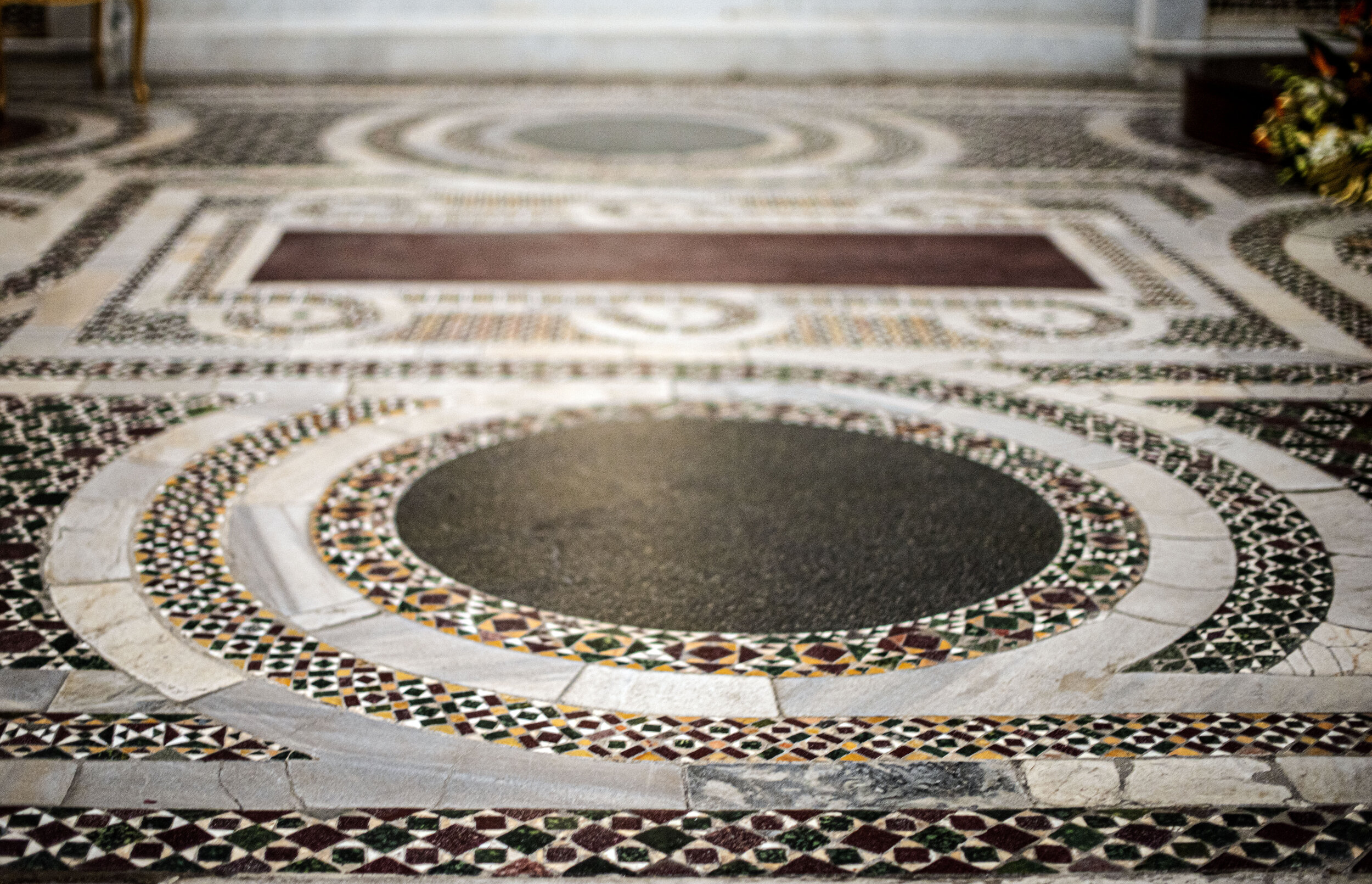
The vast area of the transept floor is entirely covered with mosaics, divided into large panels, which in front of the altar have the shape of six-petal flowers that create the so-called Spring meadow
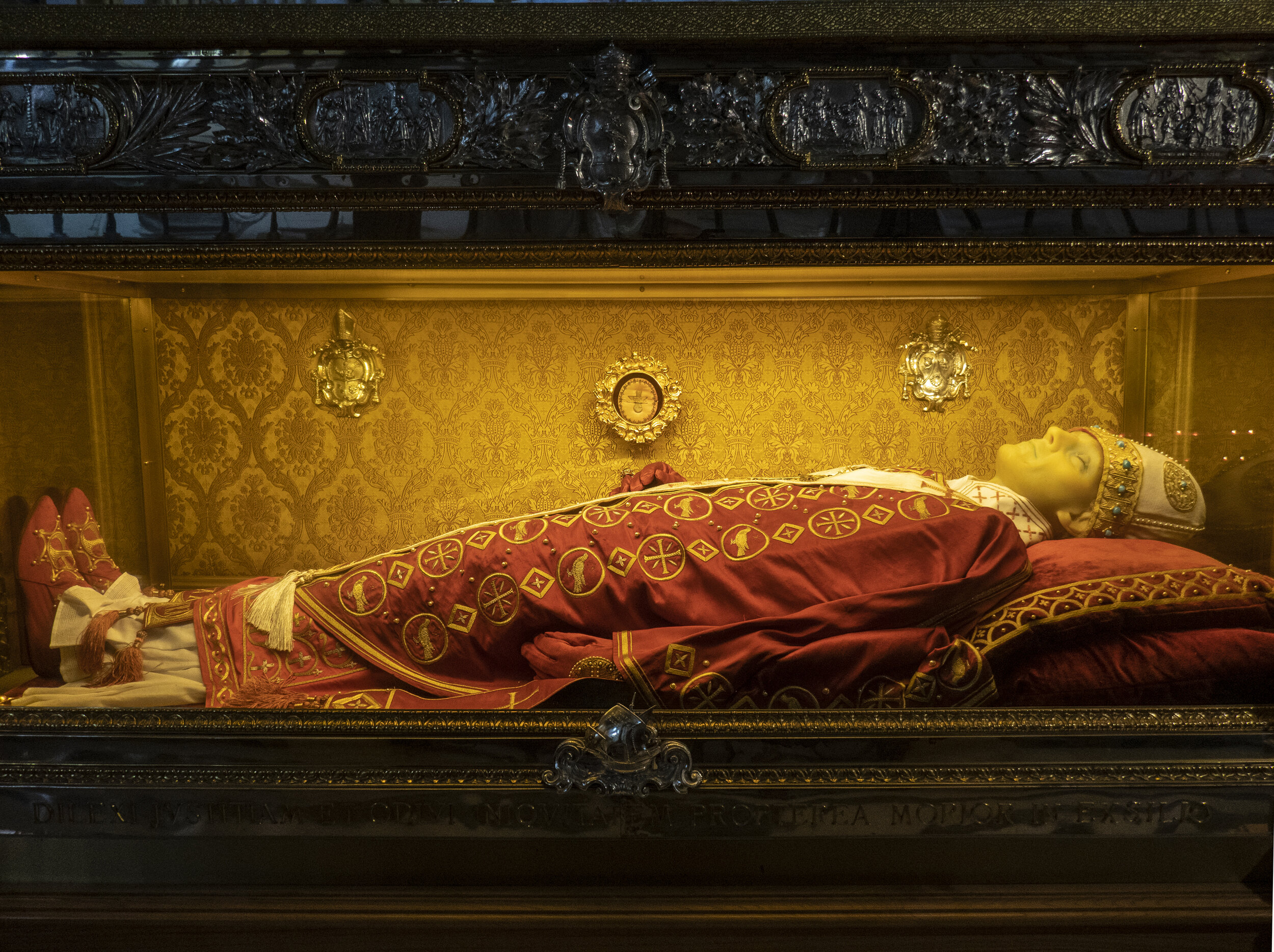
Pope Gregory VII died in exile in Salerno; the epitaph on his sarcophagus in Saint Matthew Cathedral says: "I have loved justice and hated iniquity; therefore, I die in exile. Pope: 4/22/1073 to 1085.
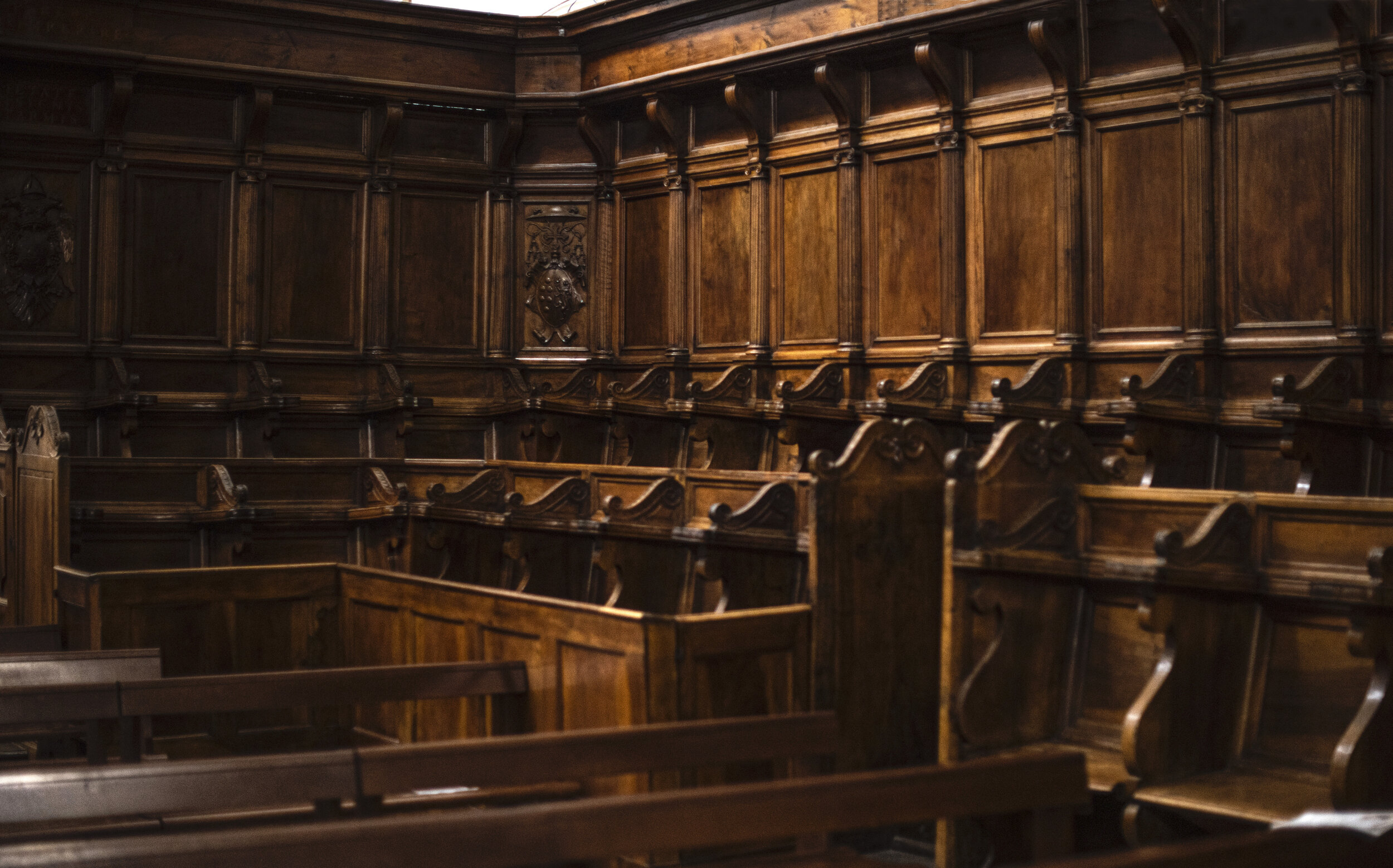
The interior of the choir area is occupied along the entire perimeter by the wooden stalls donated by the archbishop Girolamo Seripando (1554-63).

Northern Apse, the Apse of SS Sacramento or the Apse of Saint Giovanni presents a Baroque decoration with a marble altar. Two side panels depict the Communion of the Apostles and the Fall of Manna.

North Apse: The Baptism of Christ. The gospels relate that Jesus came from Galilee to John and was baptized by him, the Spirit descended upon Jesus, and a voice from Heaven told him he was God's son.

Central door to the Saint Matthew Cathedral.
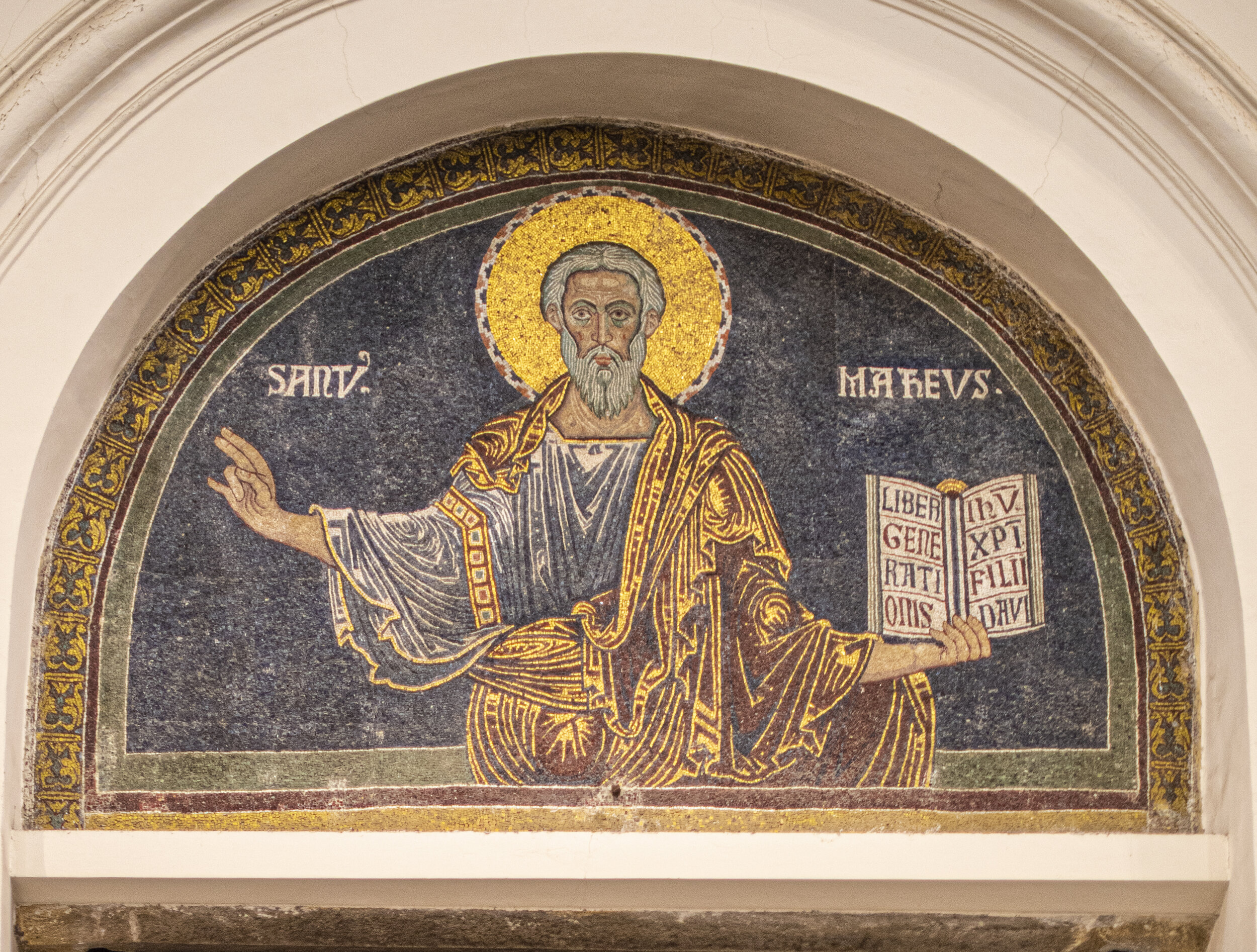
Lunette mosaic above the central door - Saint Matthew borrowed from the image of the Byzantine Christ Pantocrator, in which one hand holds the open book of the Gospel and the other blesses the crowd.
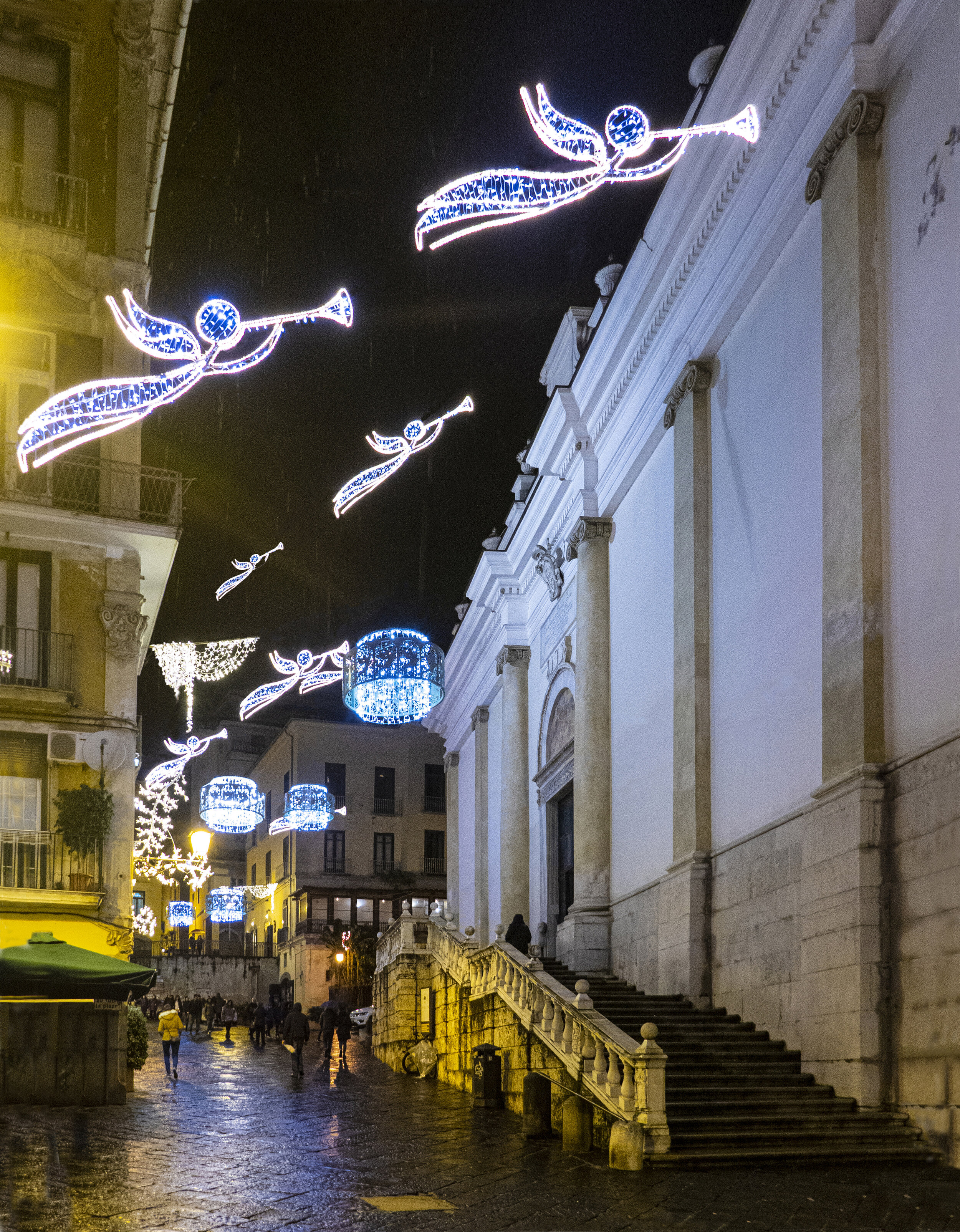
Evening in front of Saint Matthew Cathedral with the angels floating in air announcing that it is Christmas season.
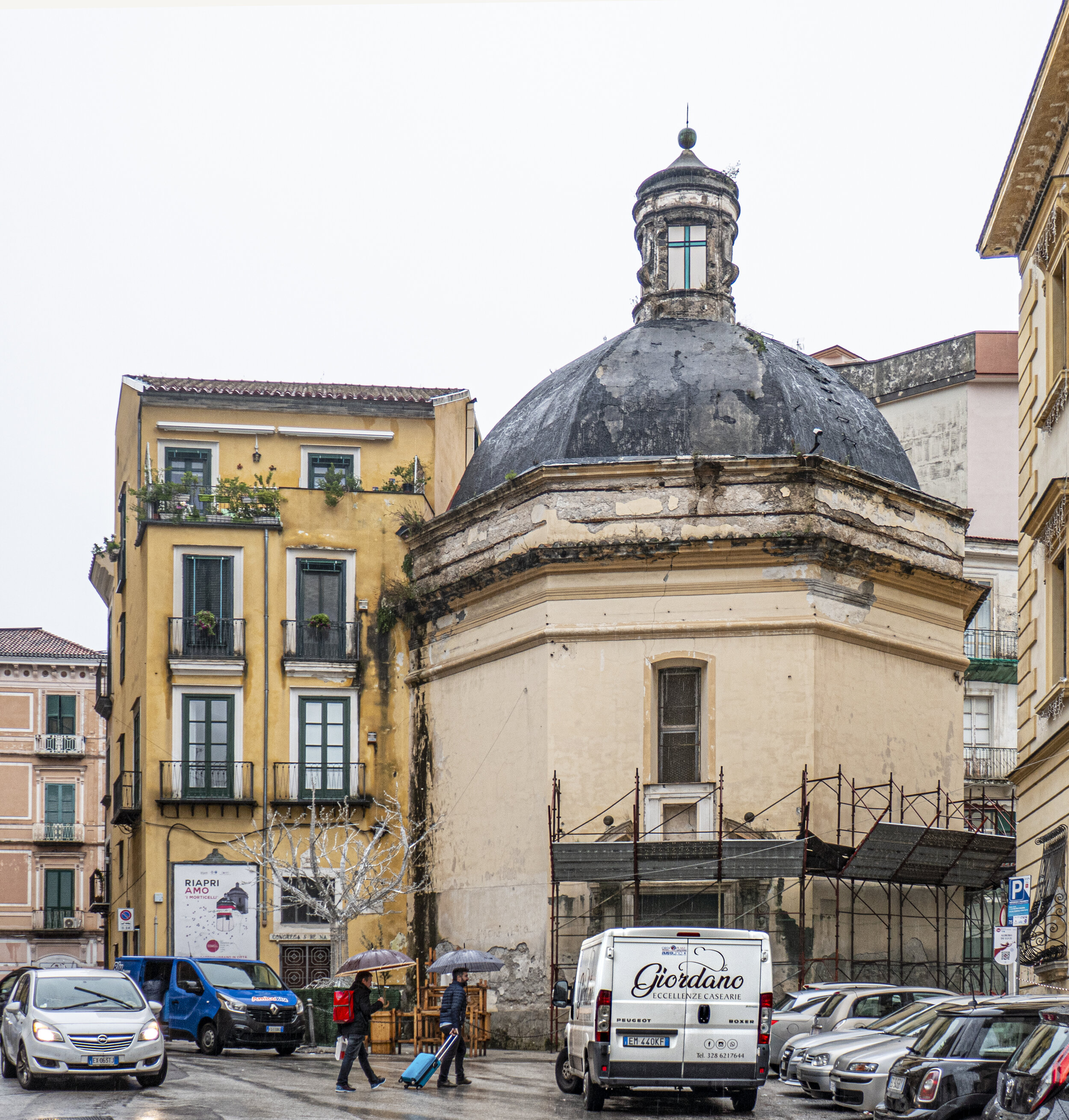
Street area on the backside of the Saint Matthew Cathedral area.

The Saint Matthew Cathedral bell tower with Christmas decorations. We were on our way to having dinner at a wonderful little restaurant about two blocks away.

Louise looks through the window of restaurant Cincerelli, after having a wonderful (and magical) birthday dinner.
PrevNext